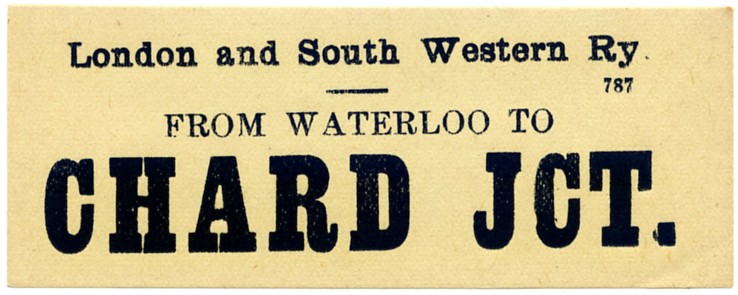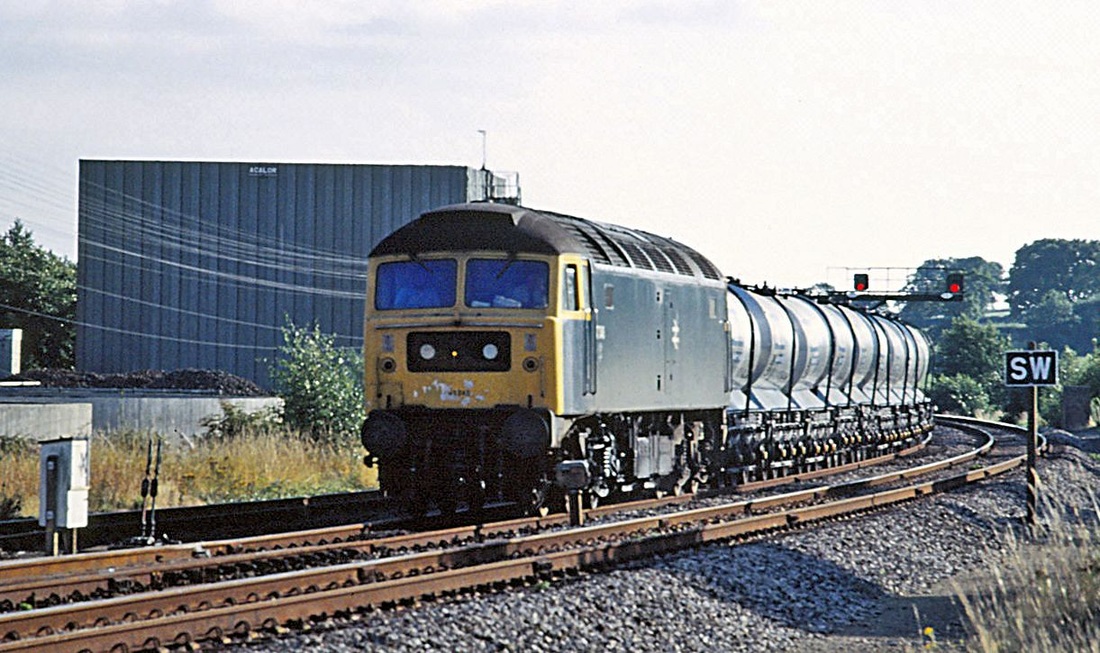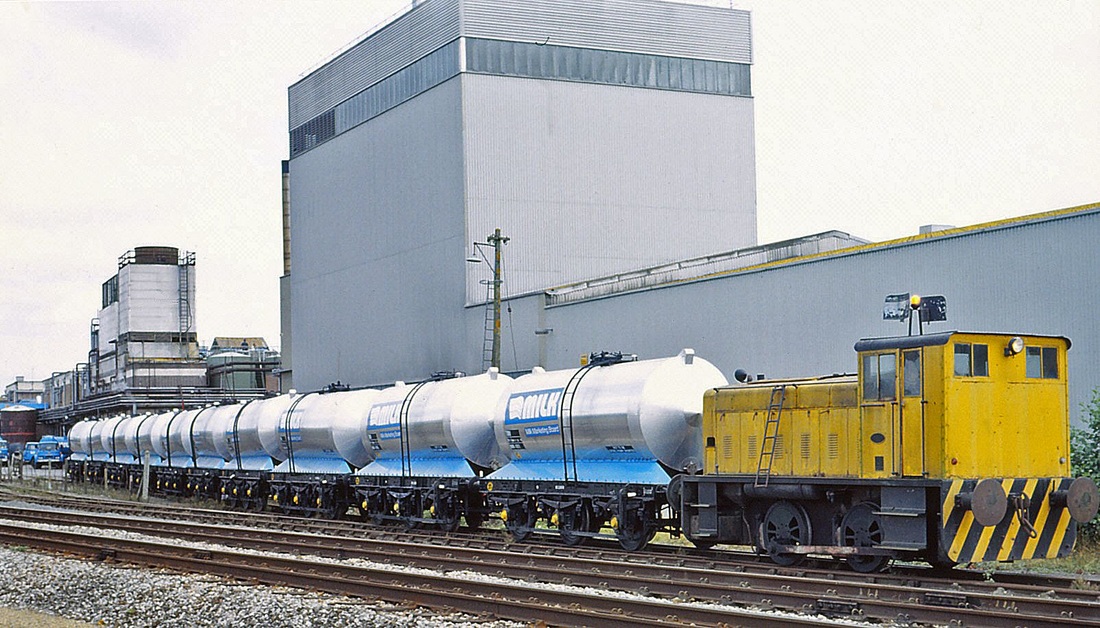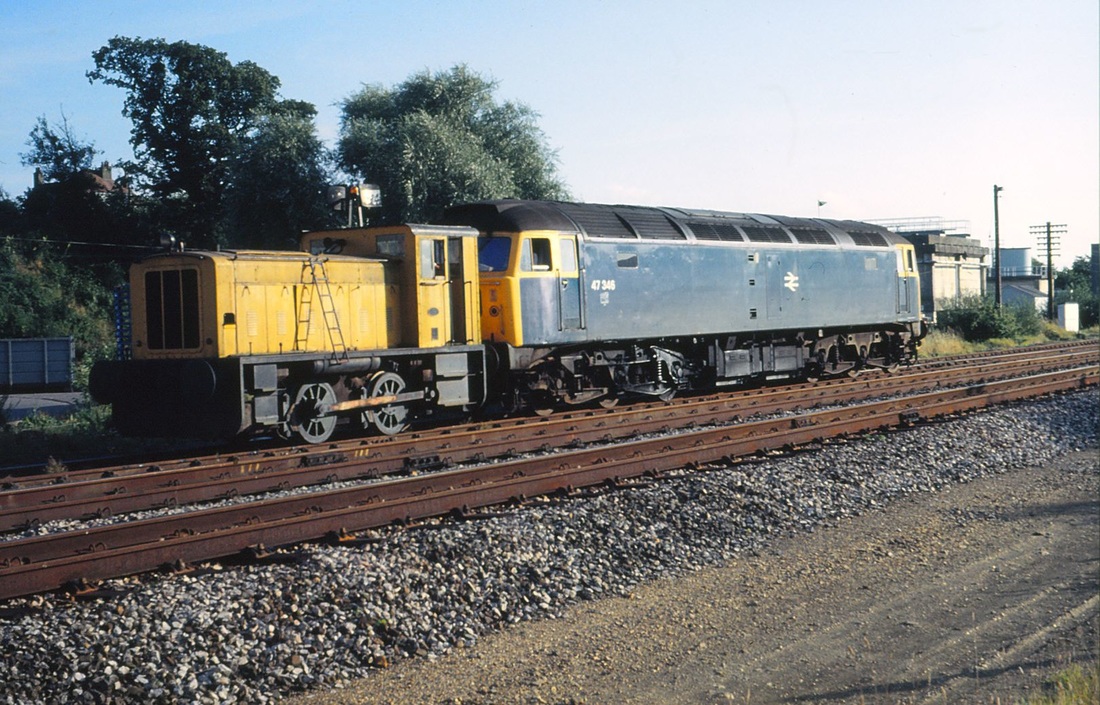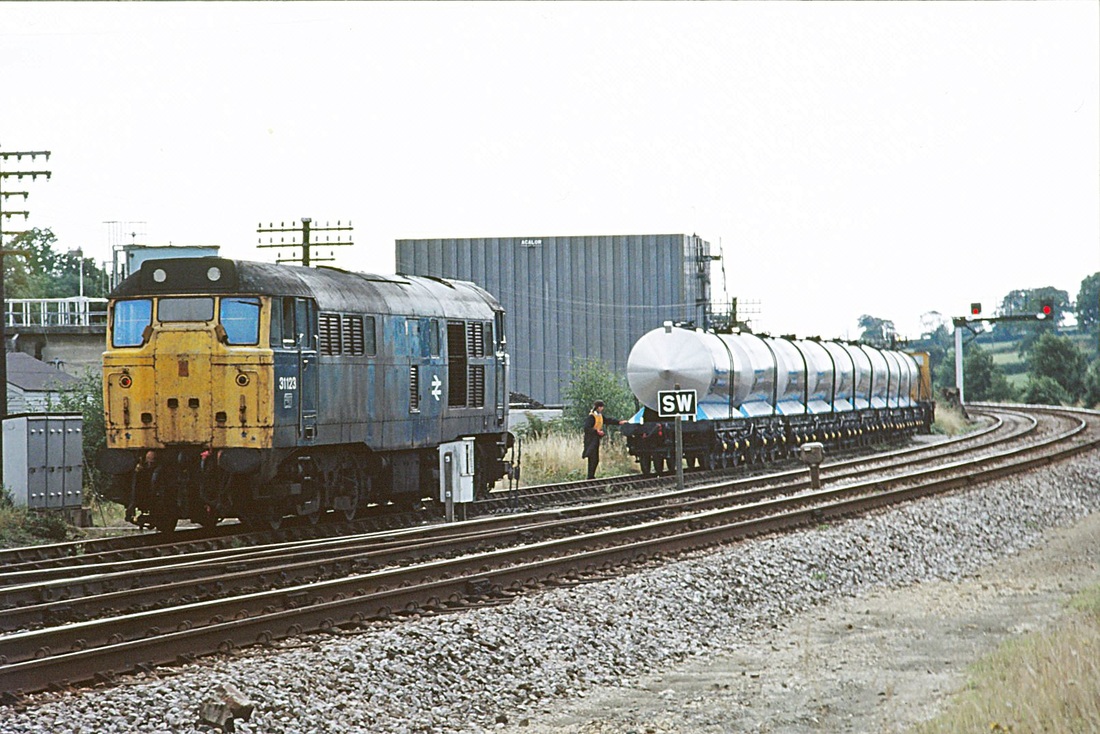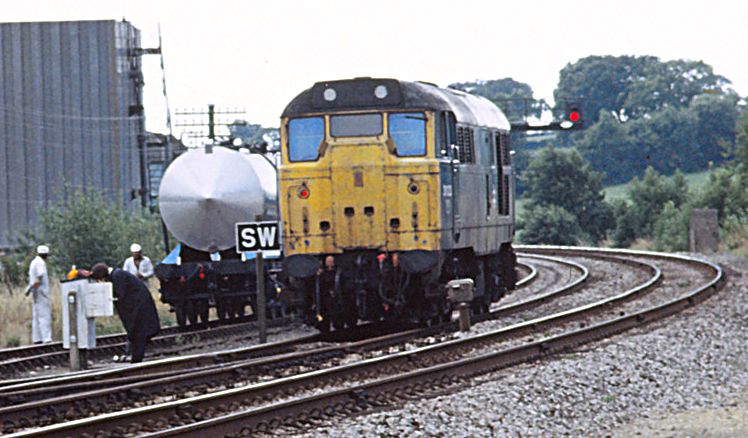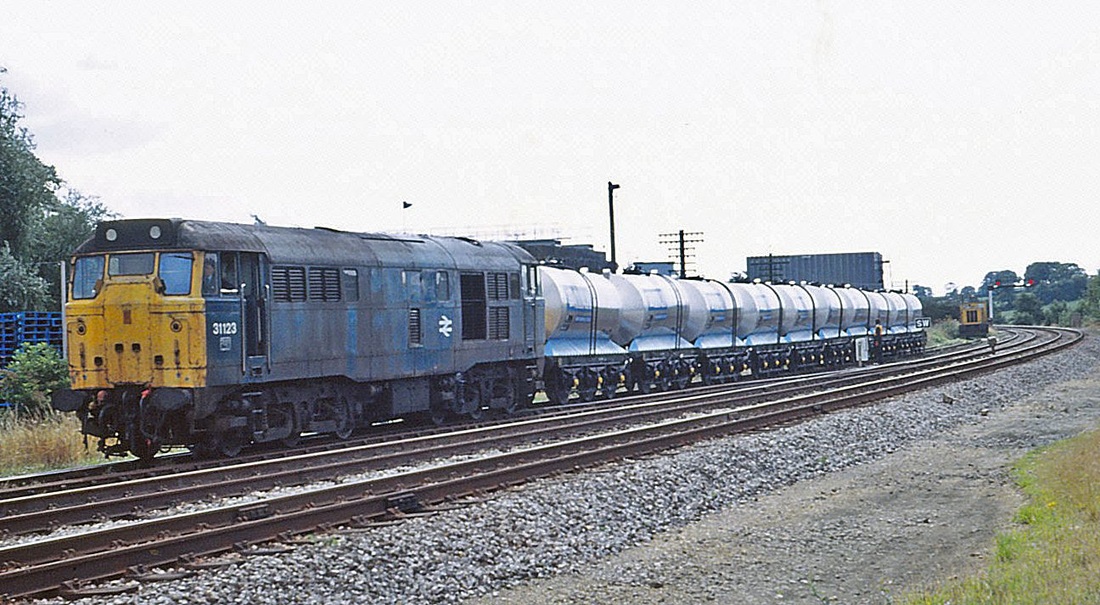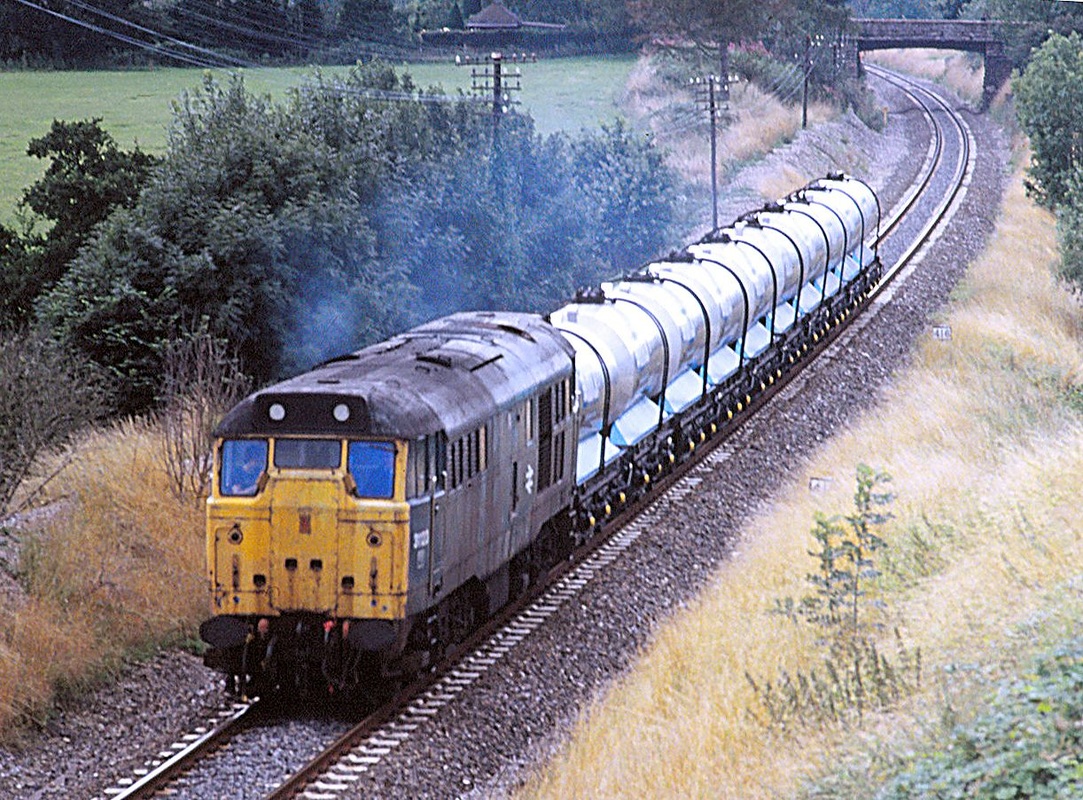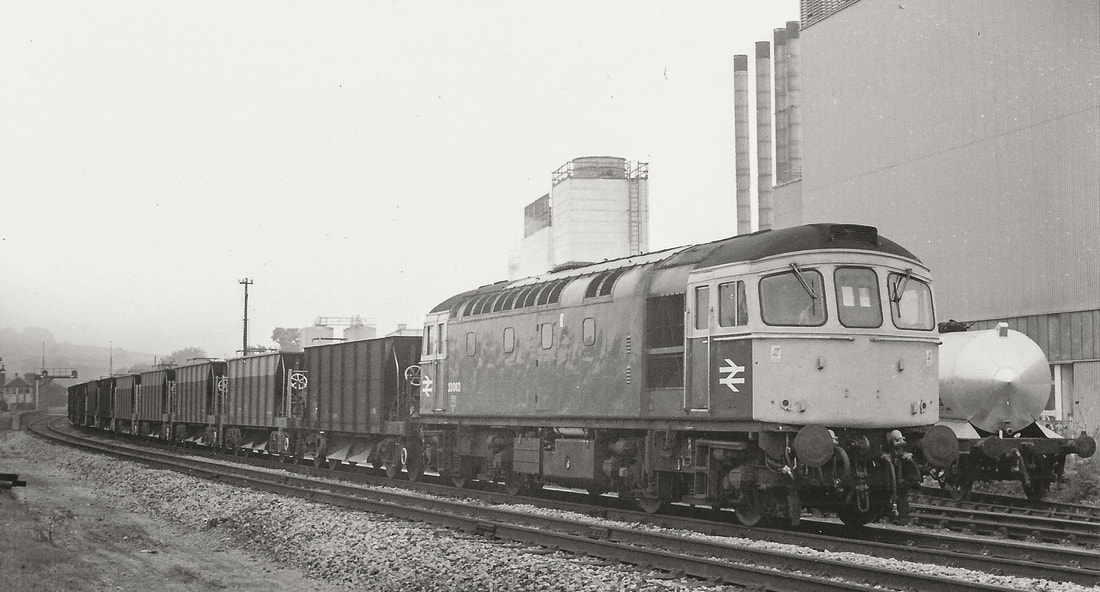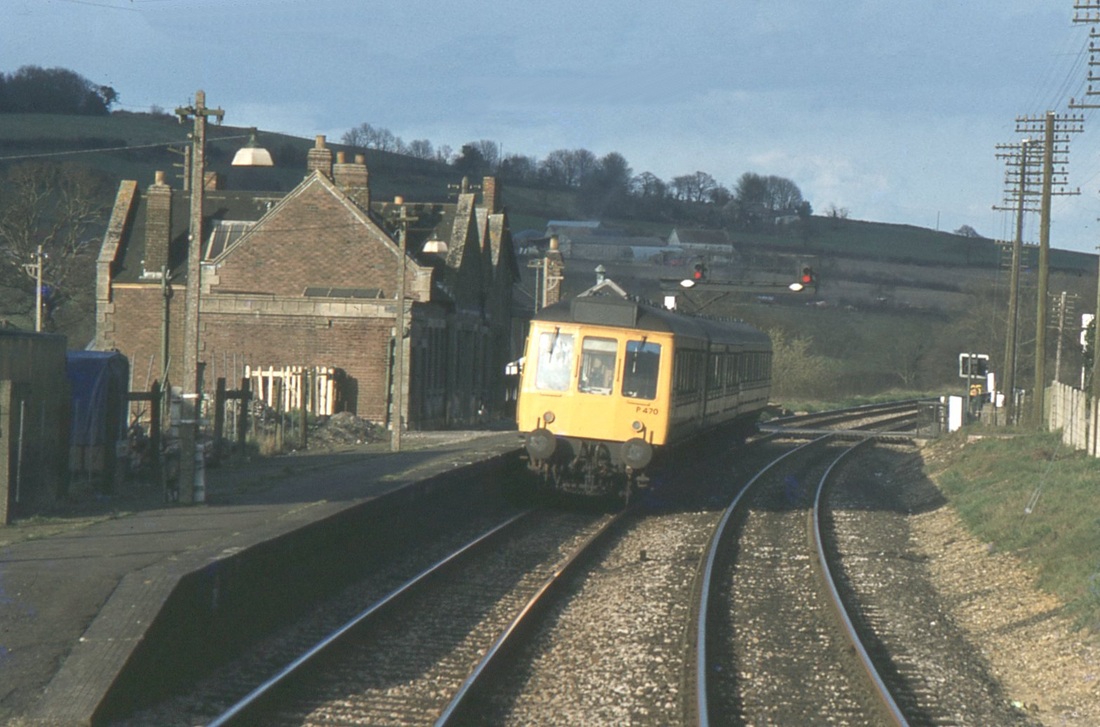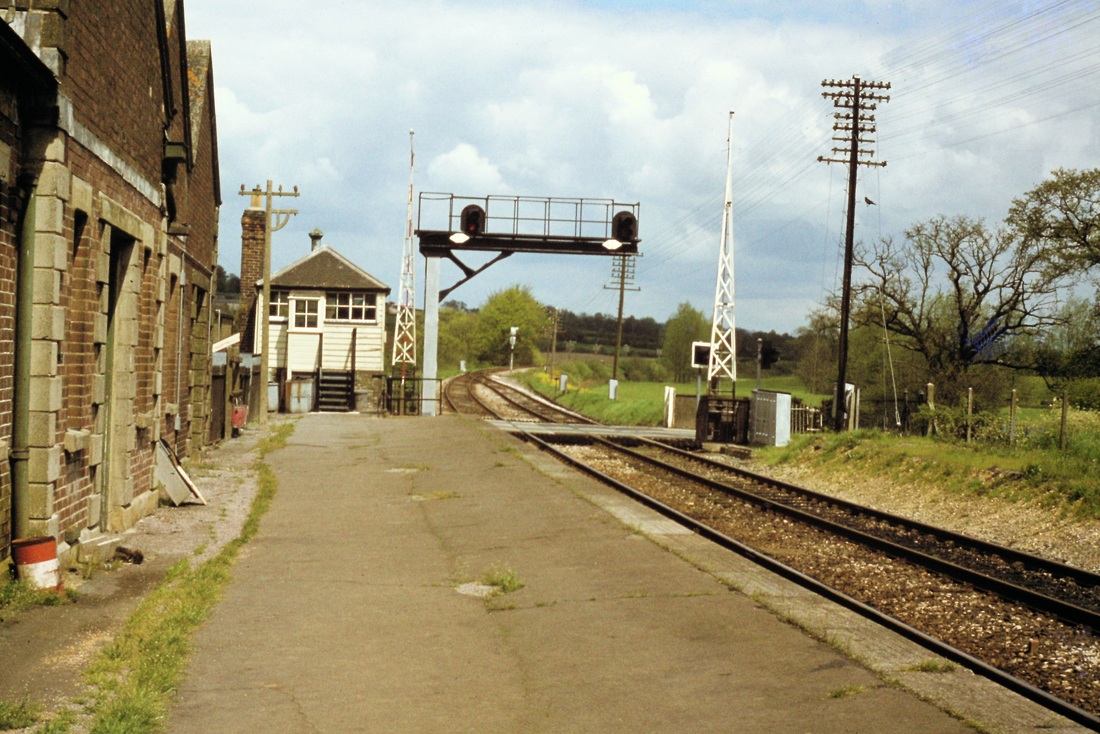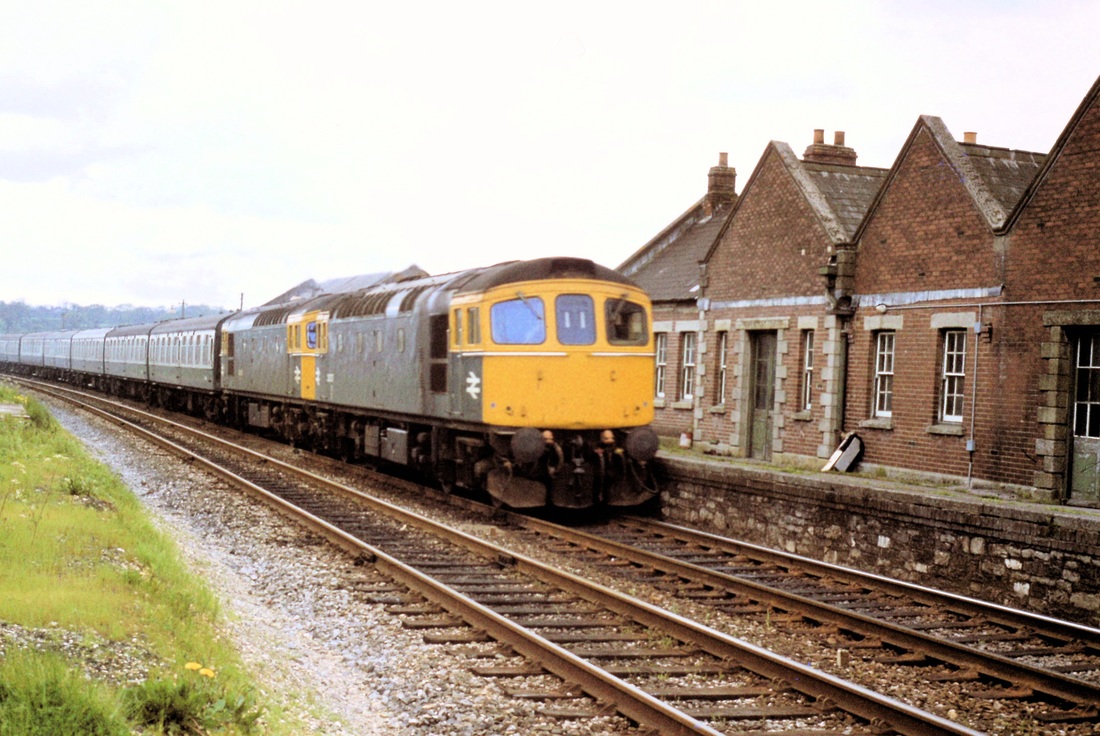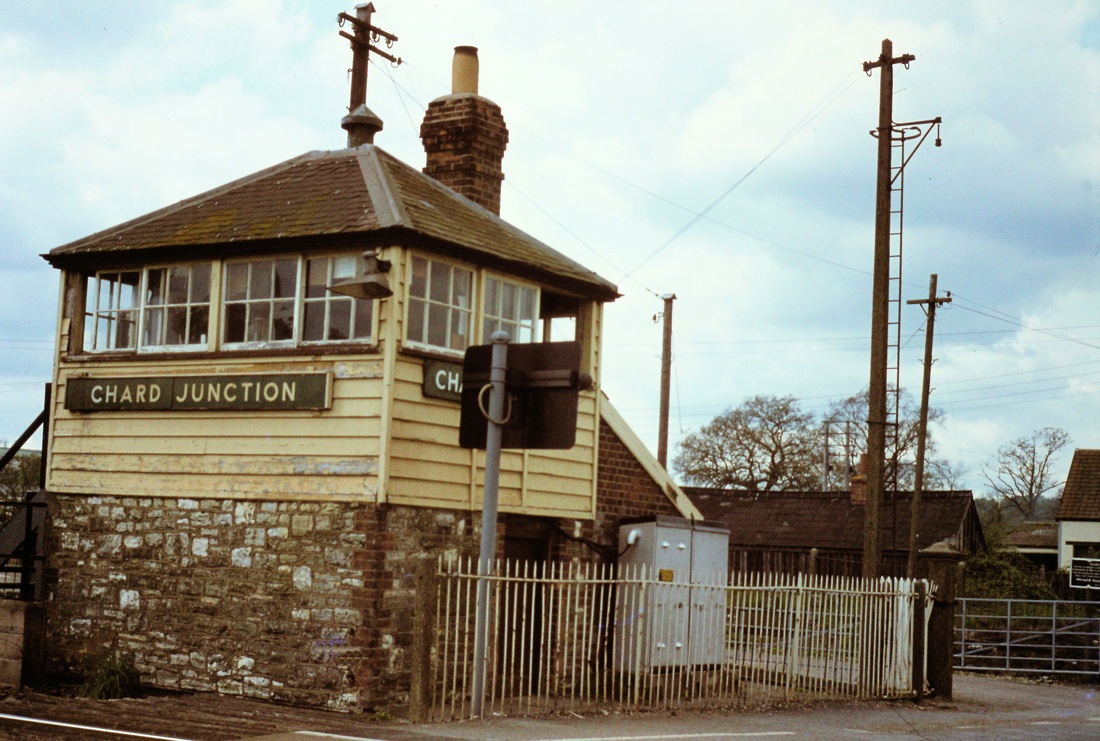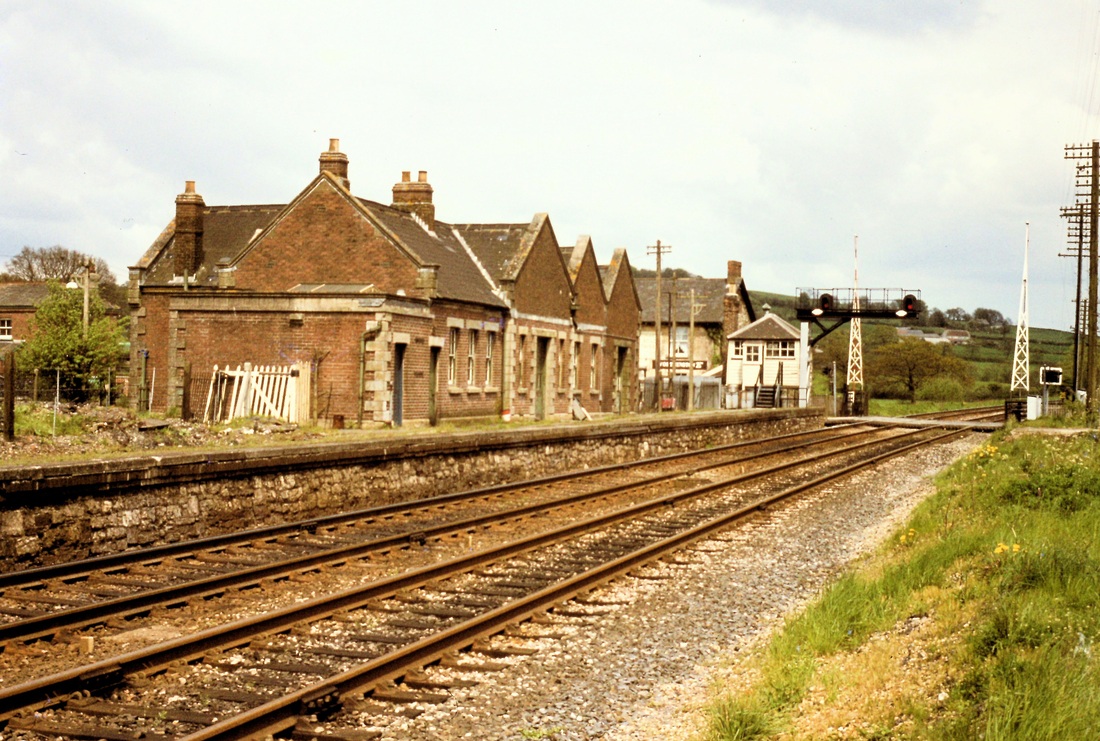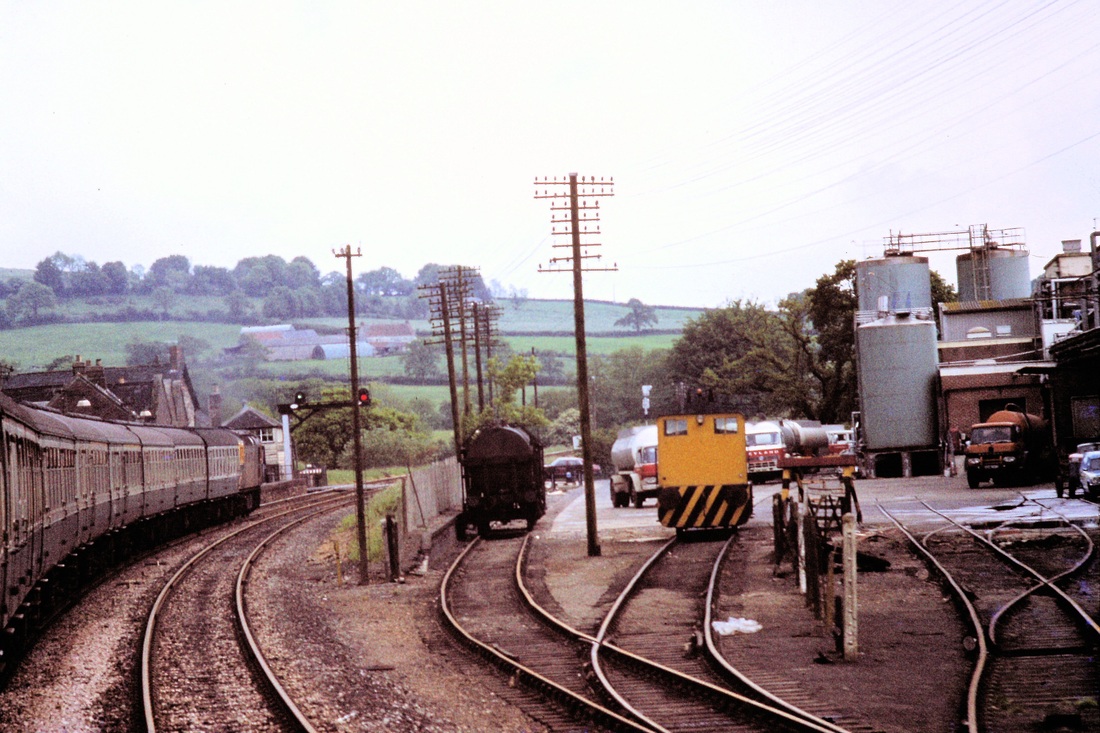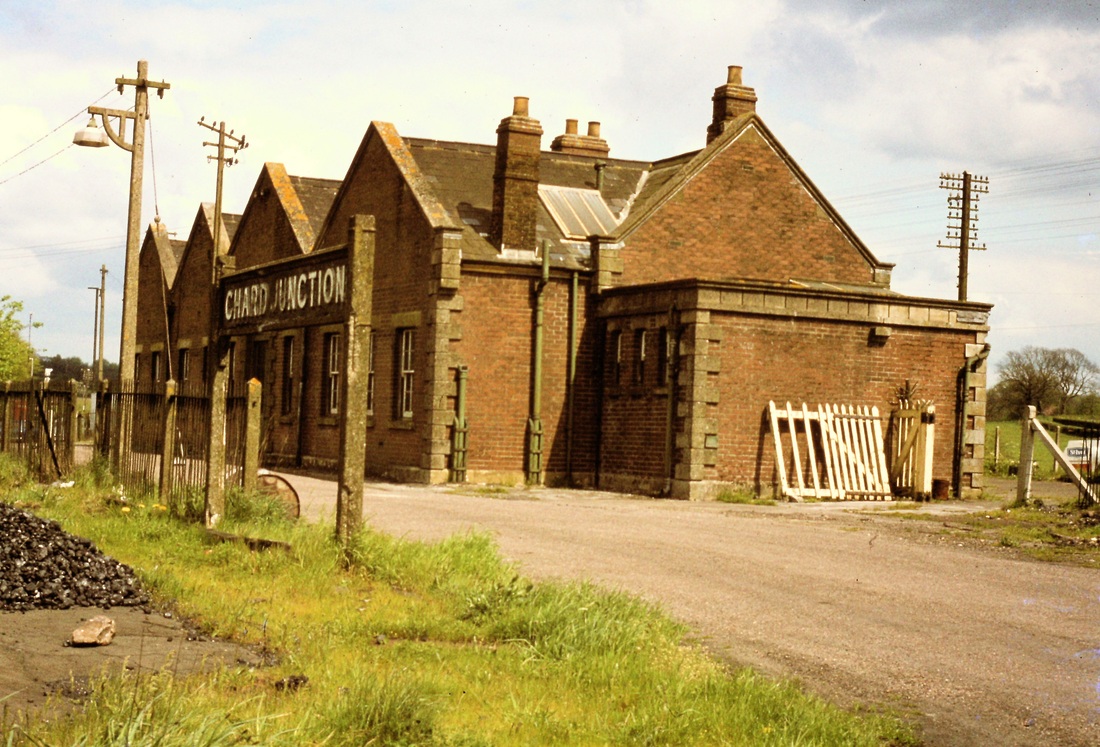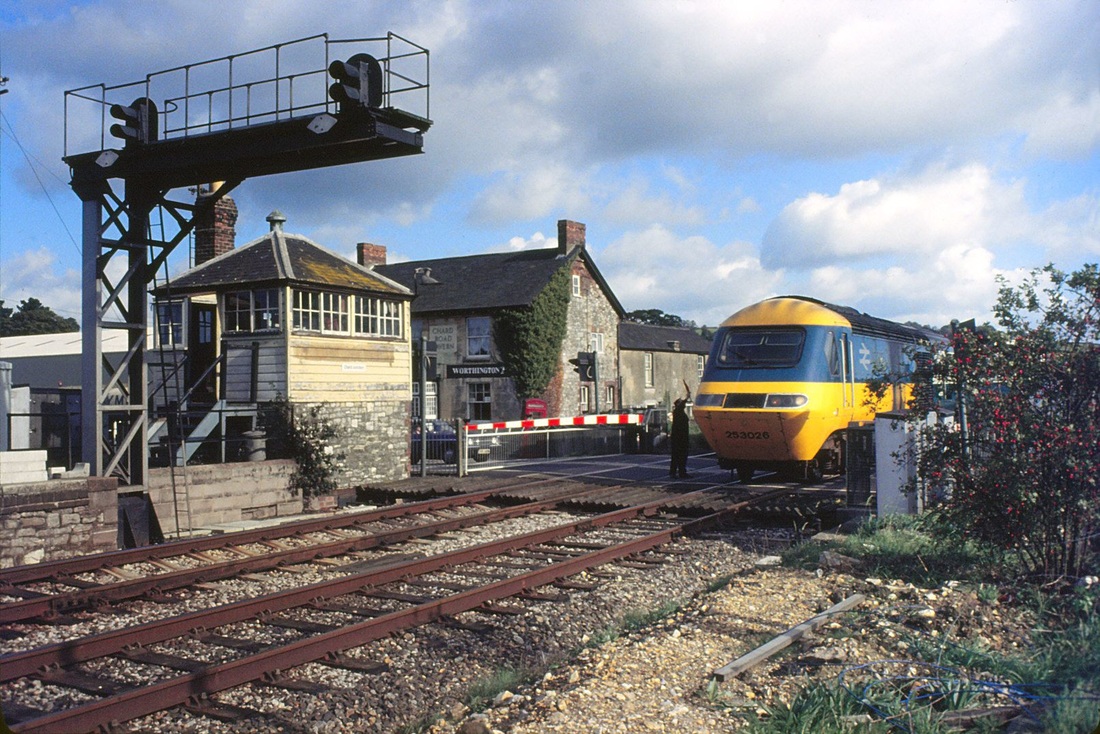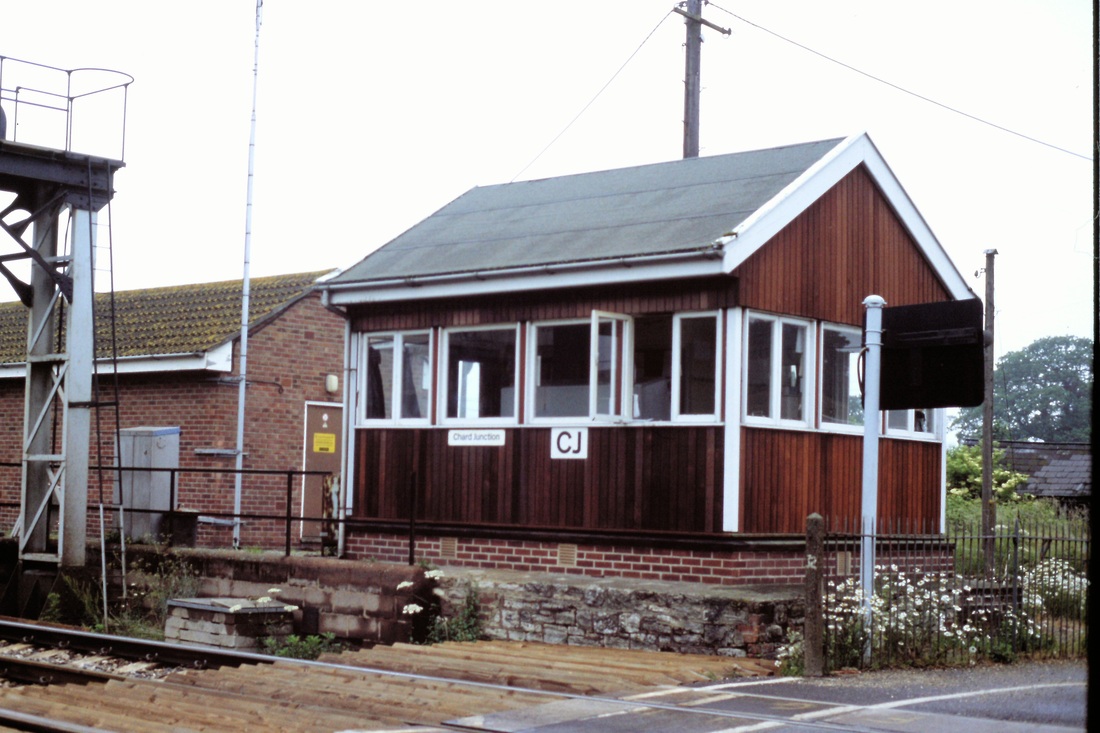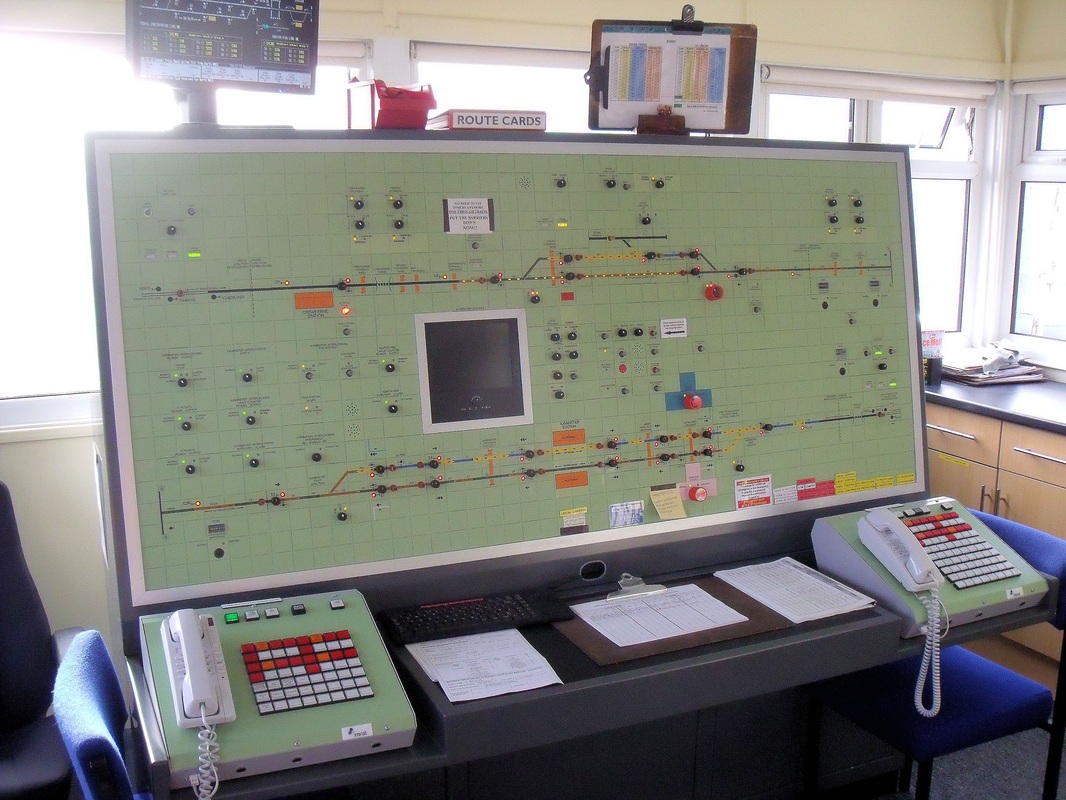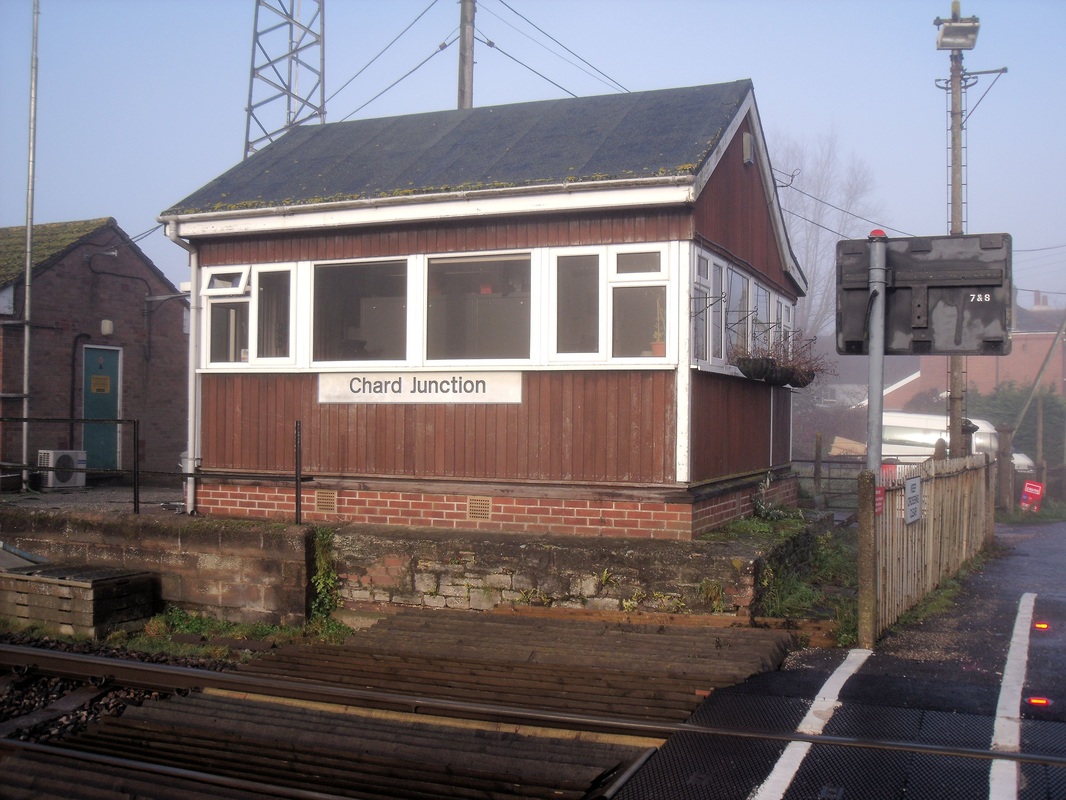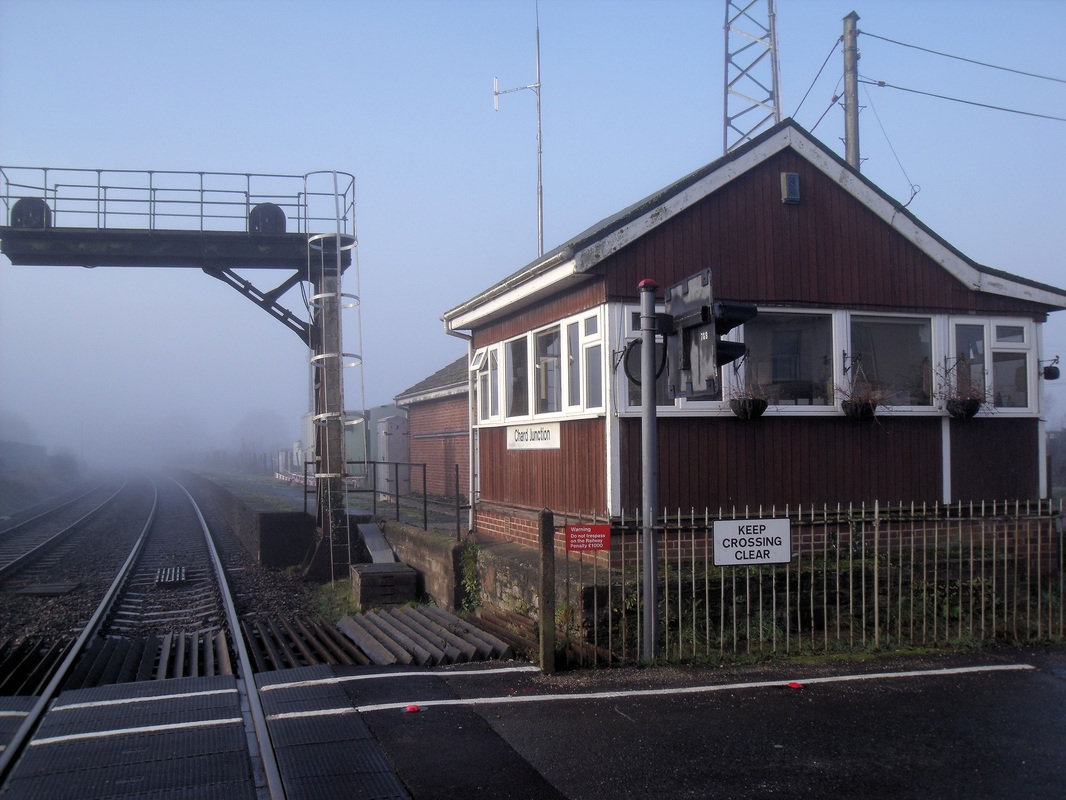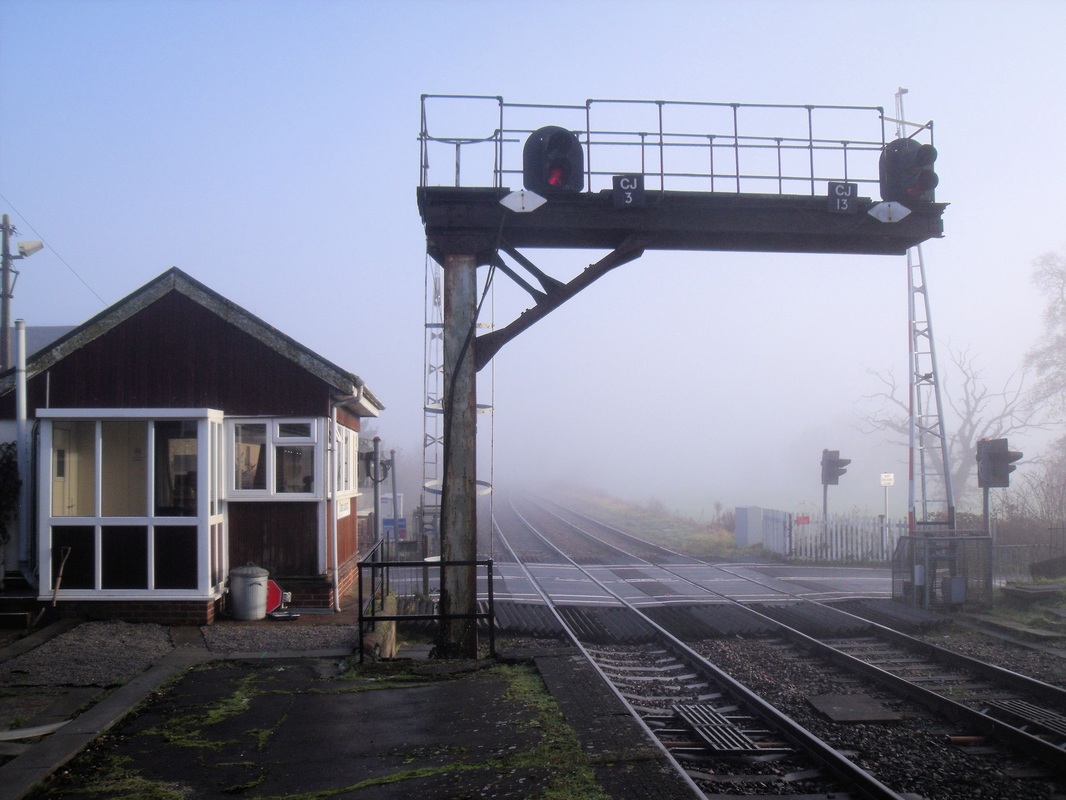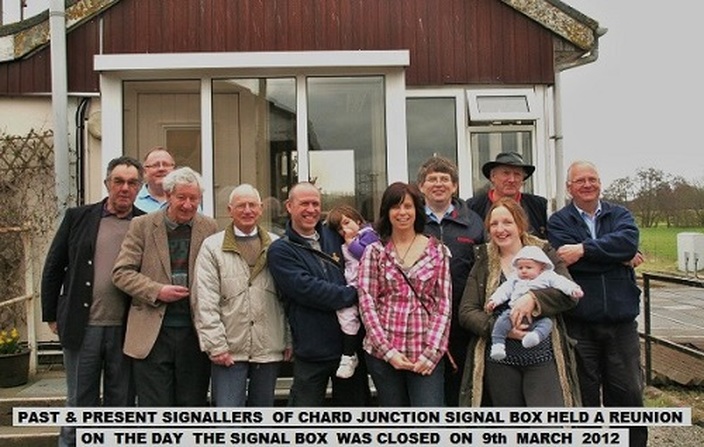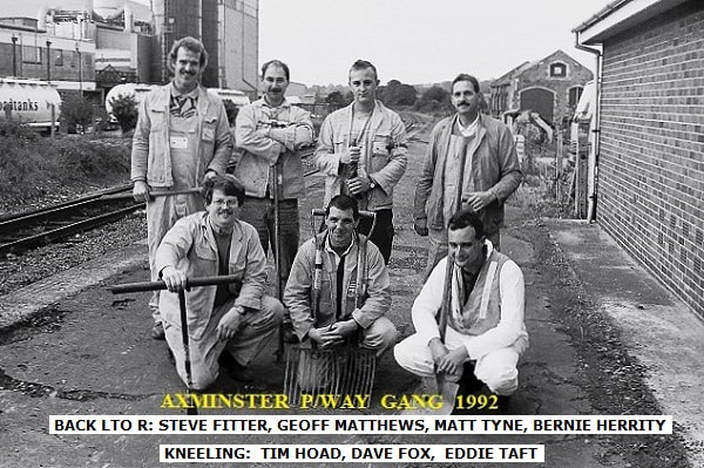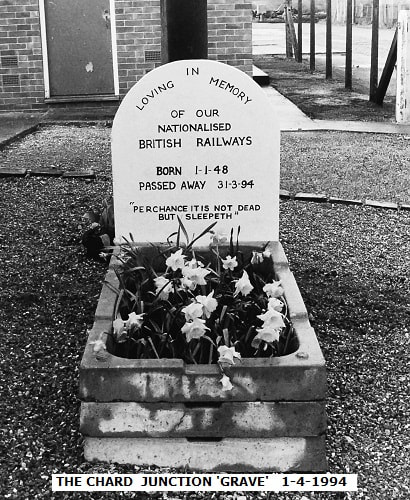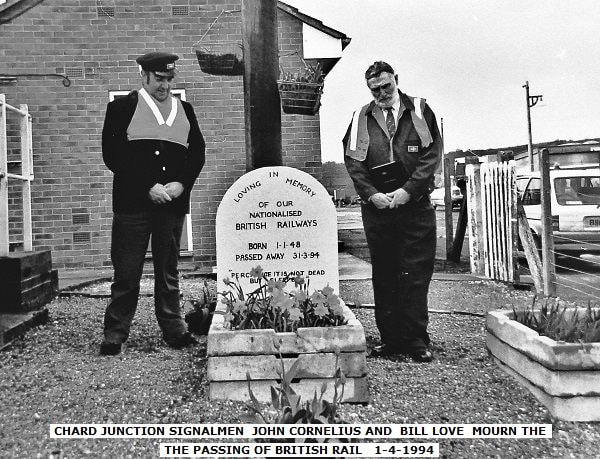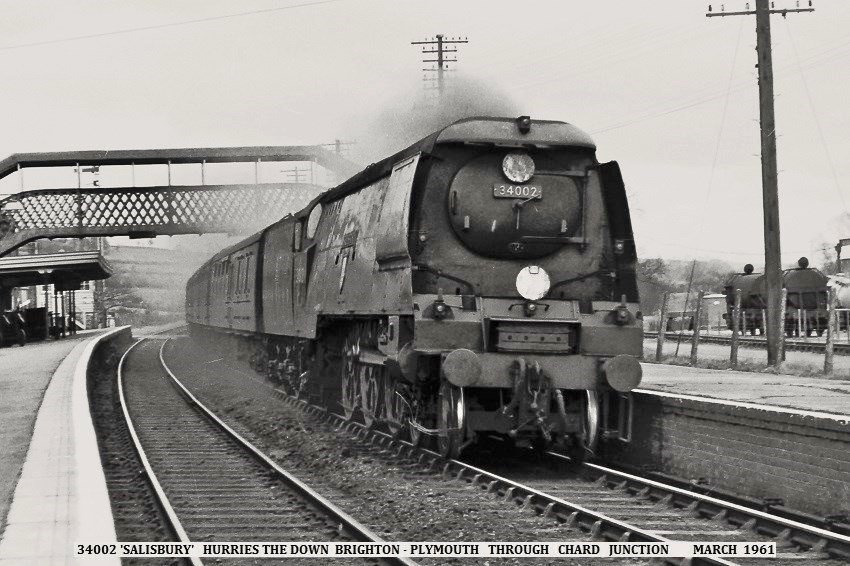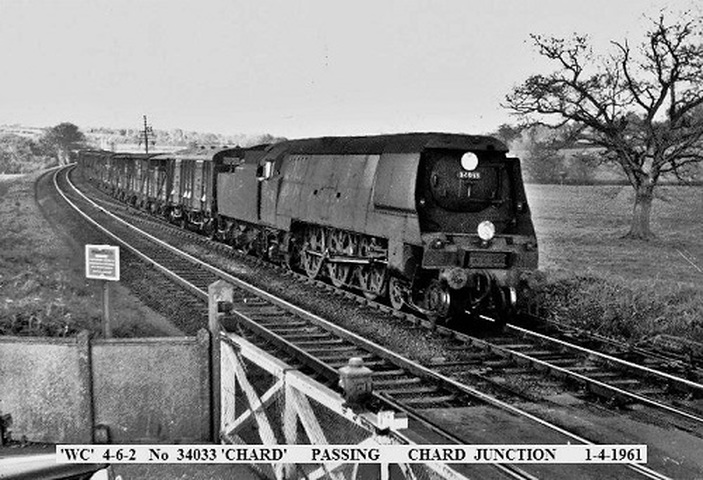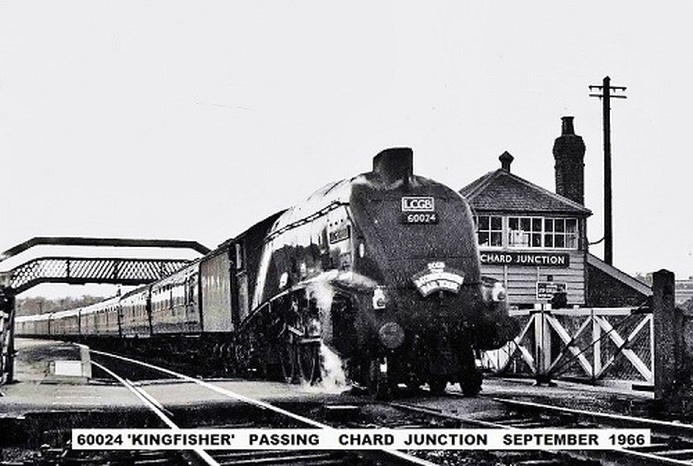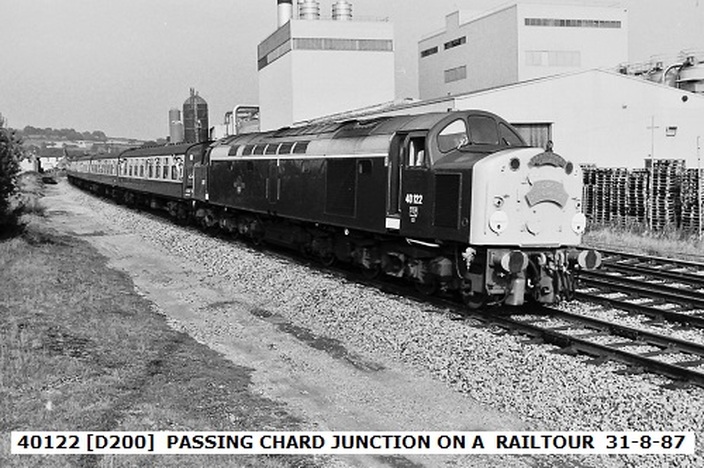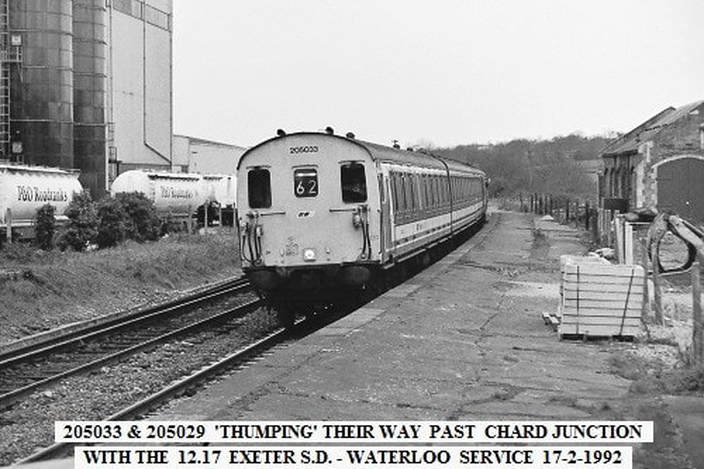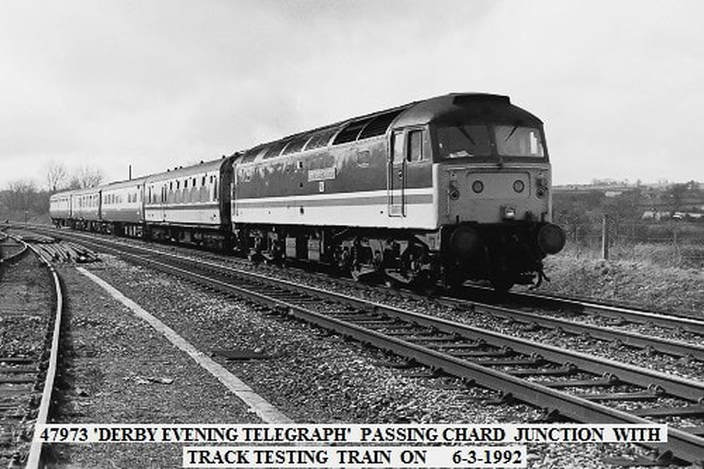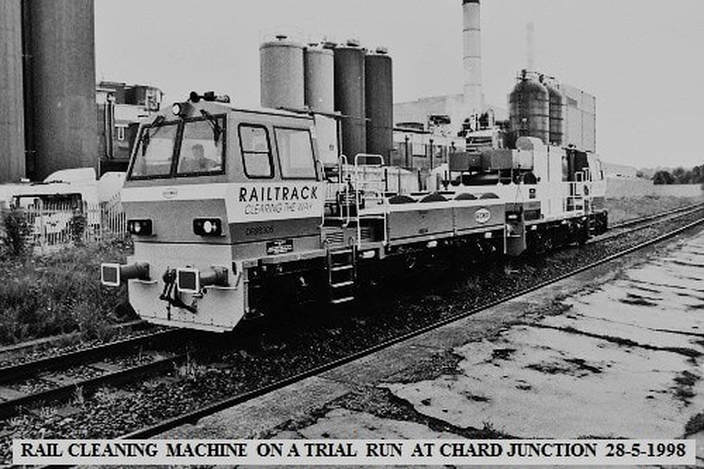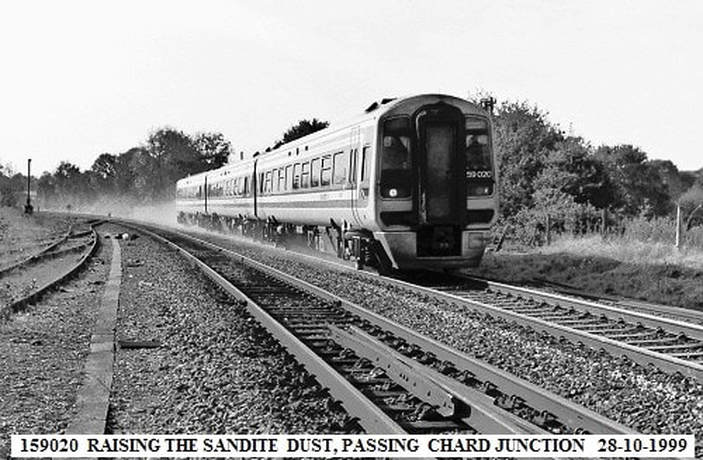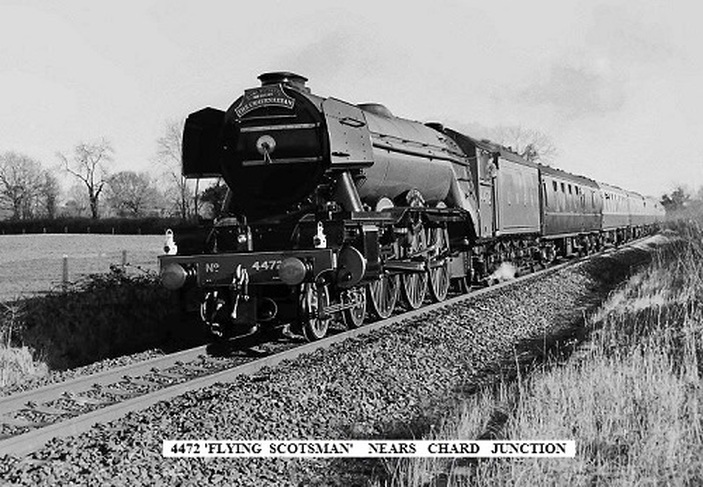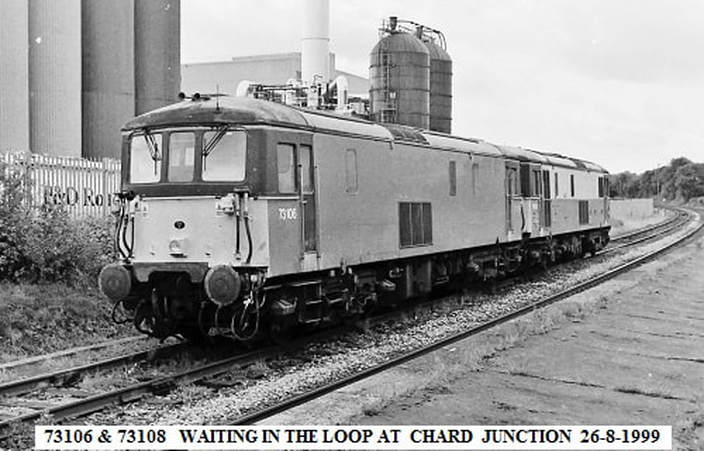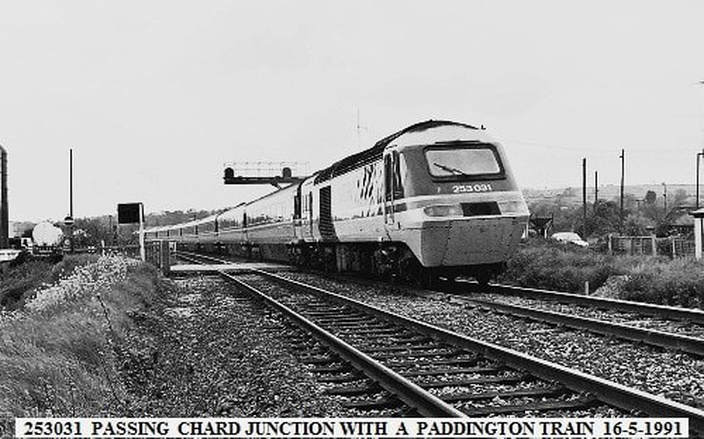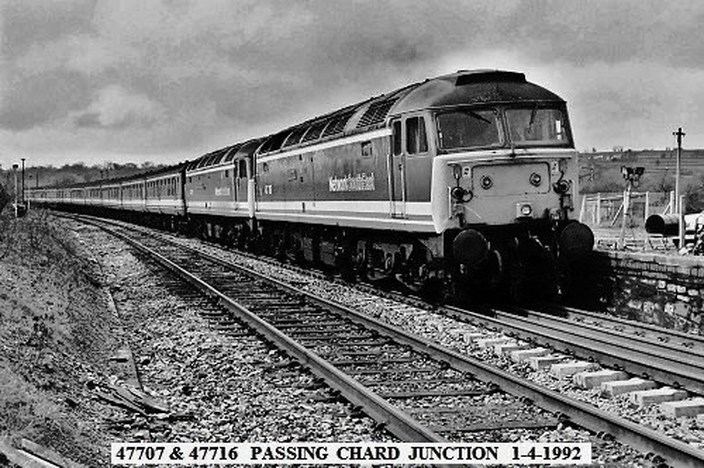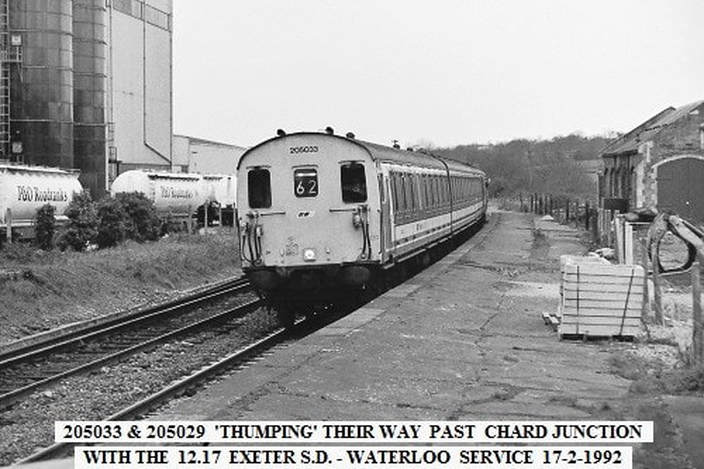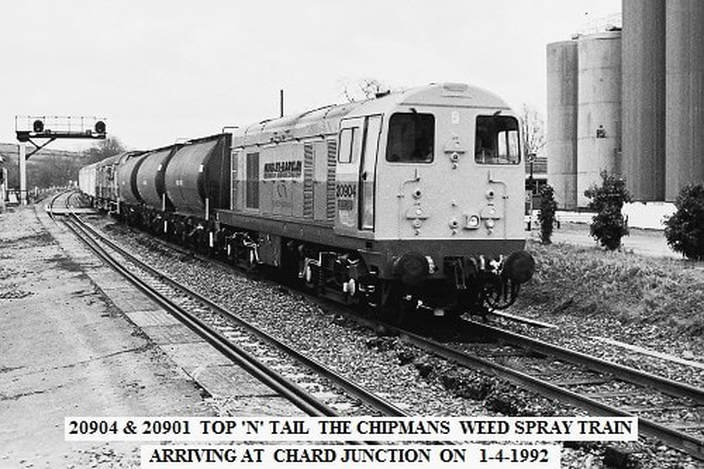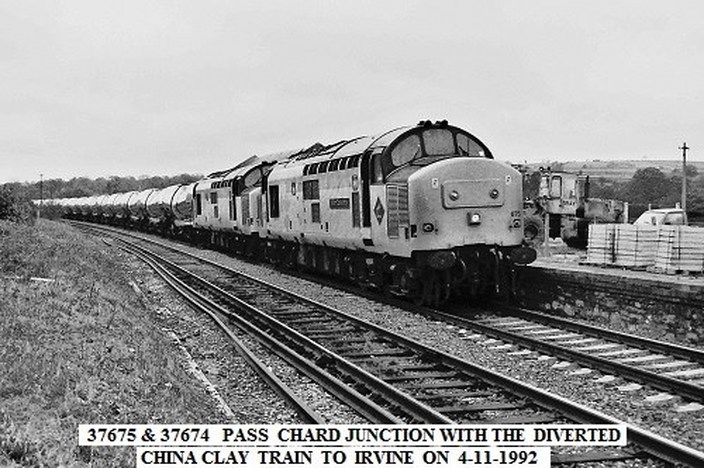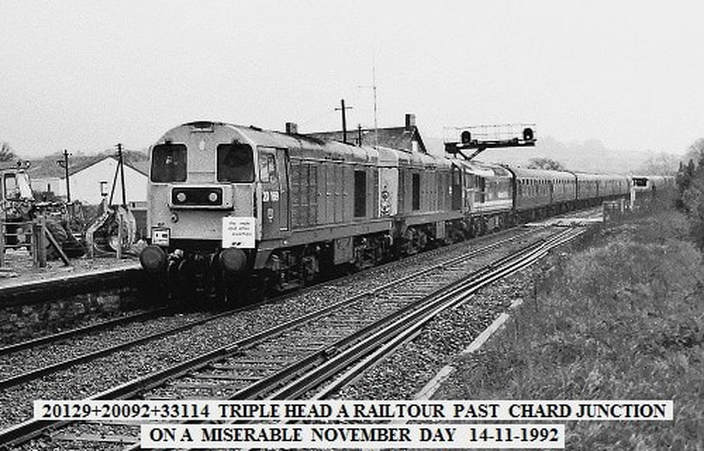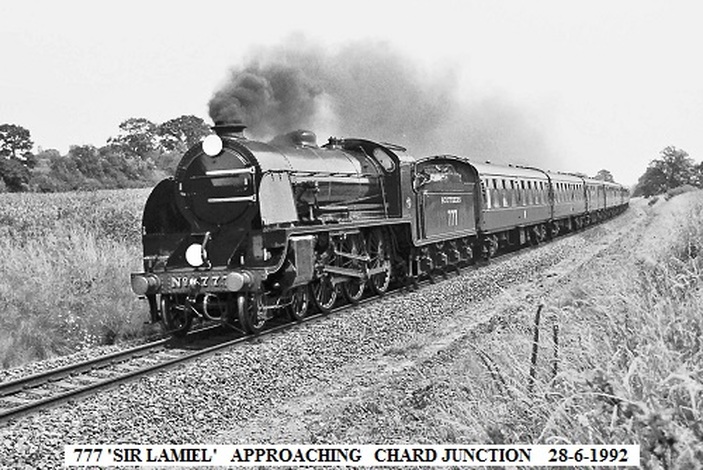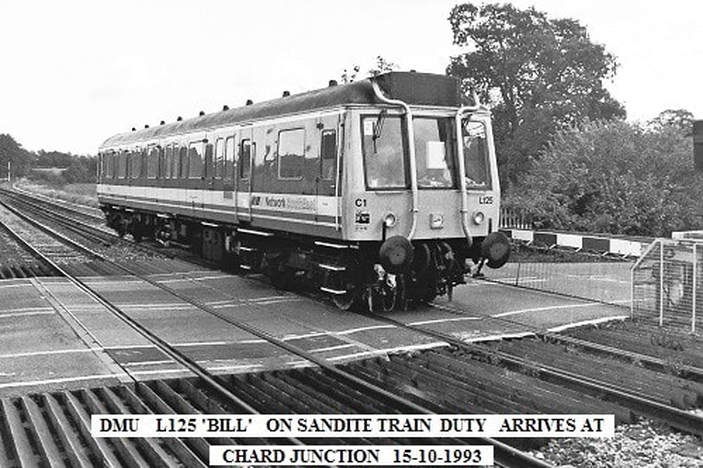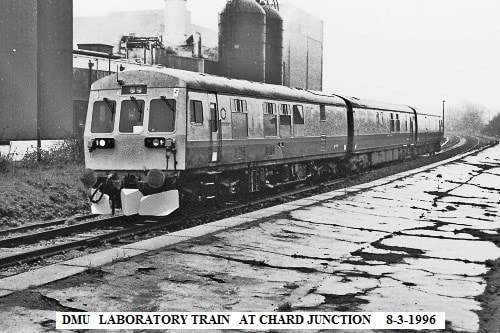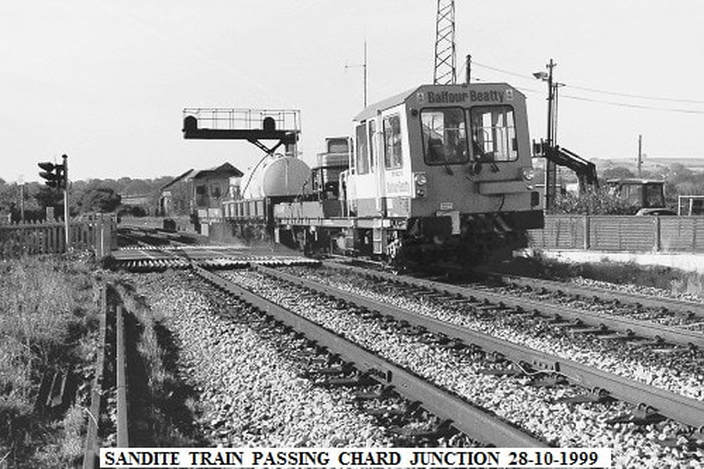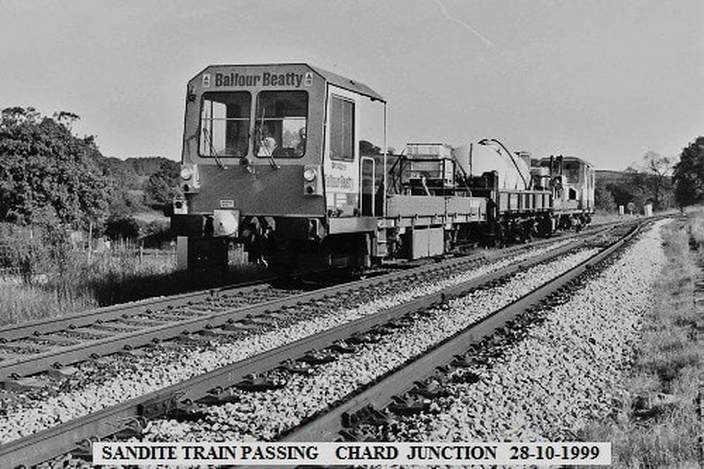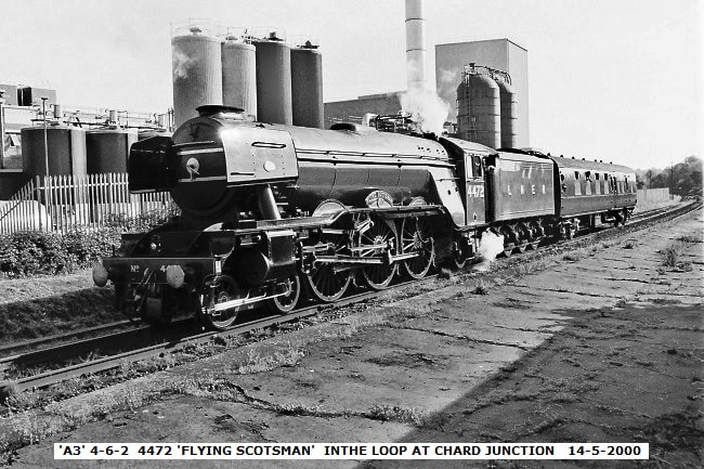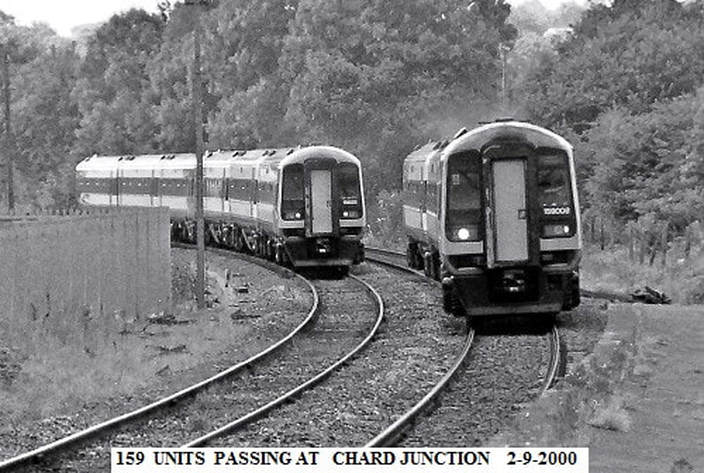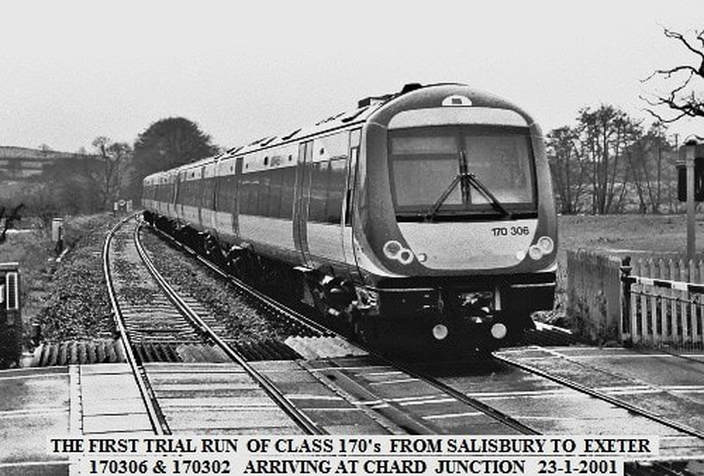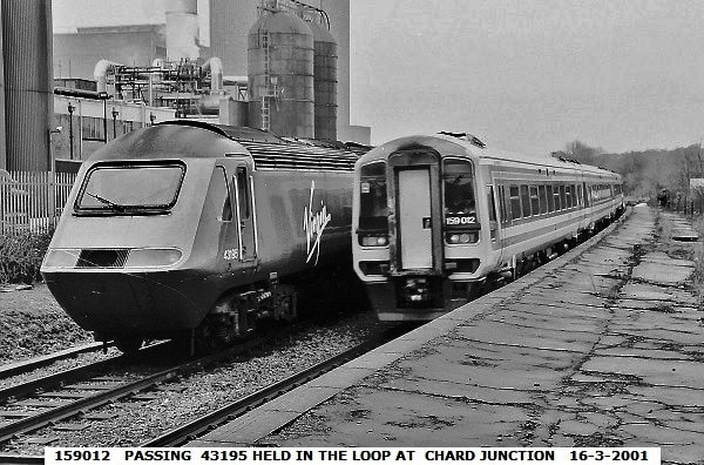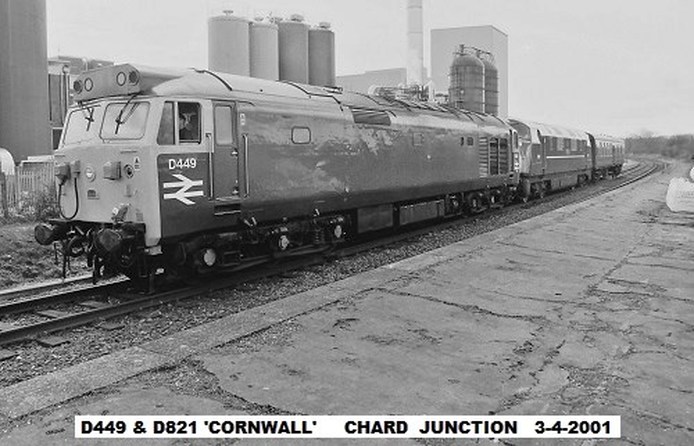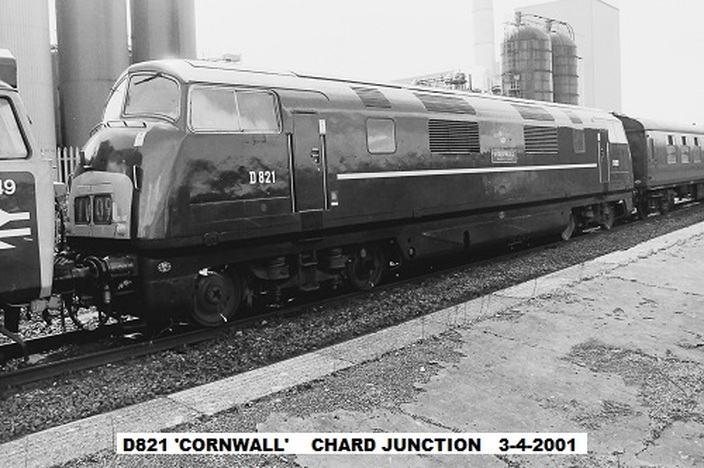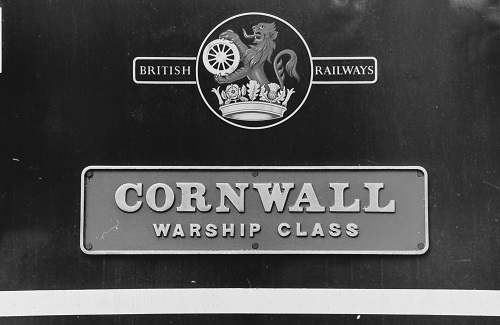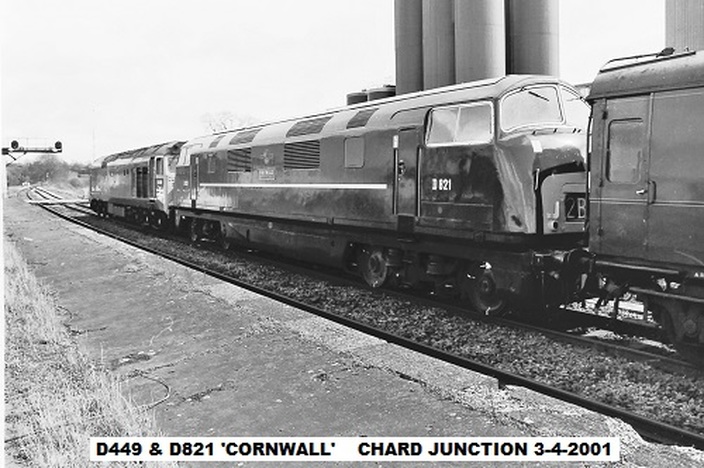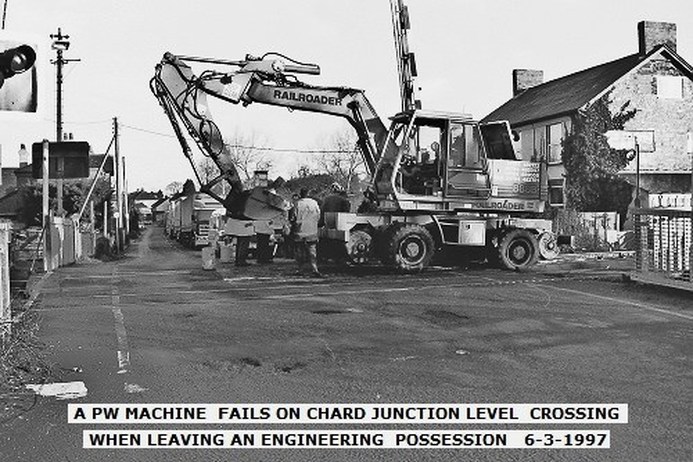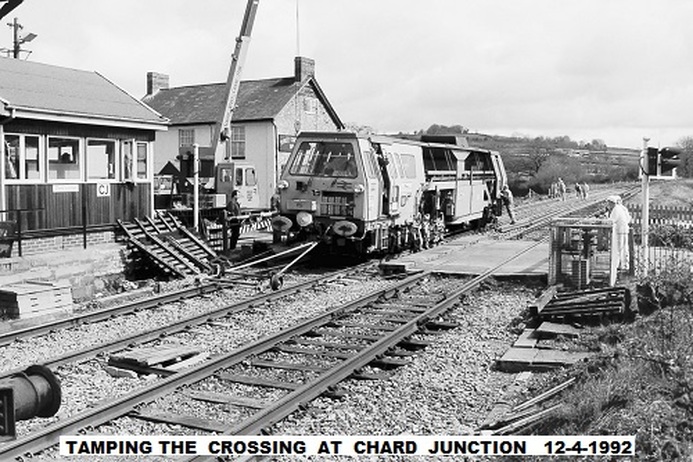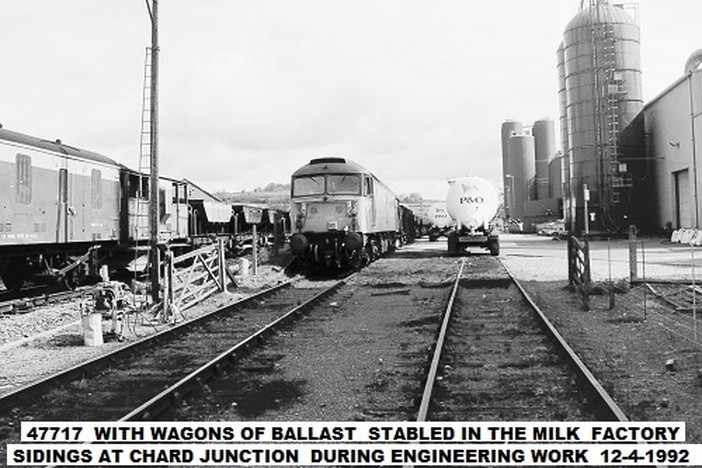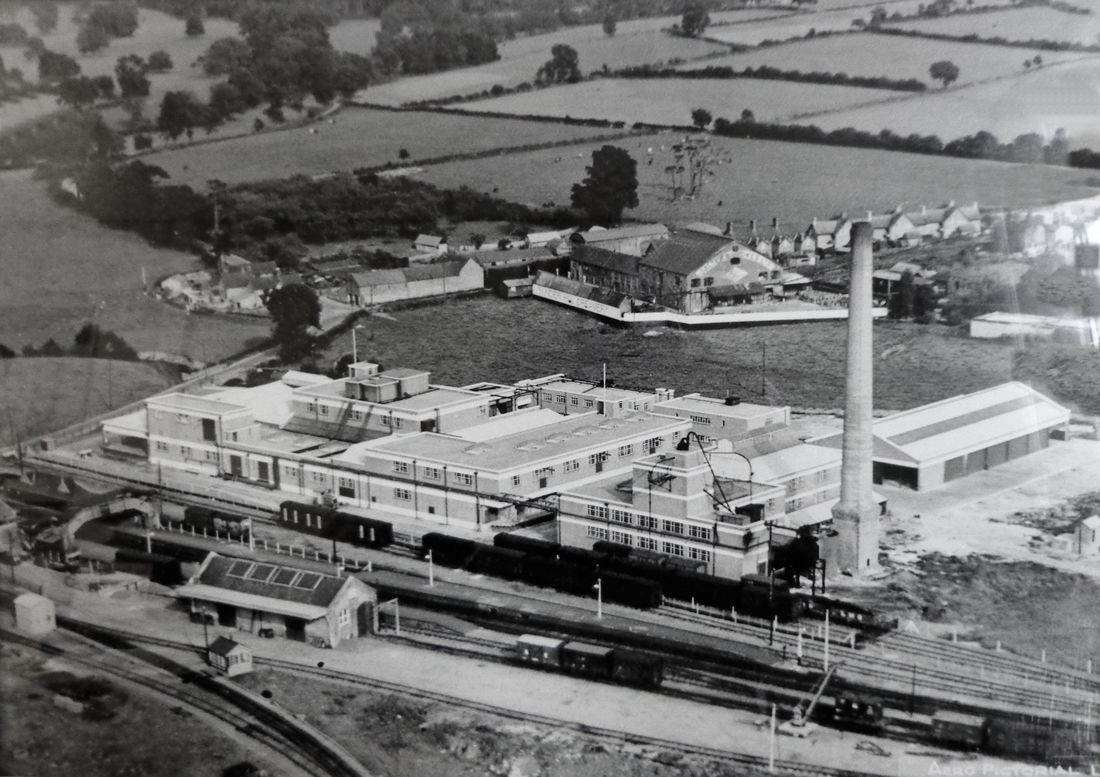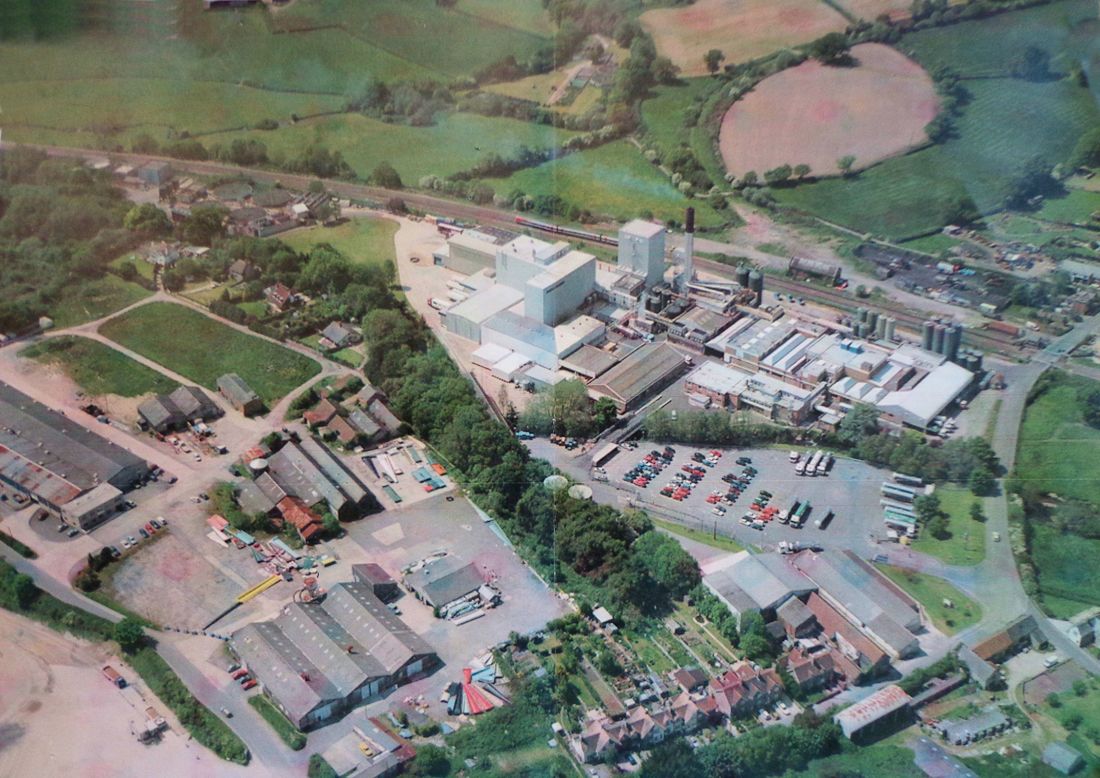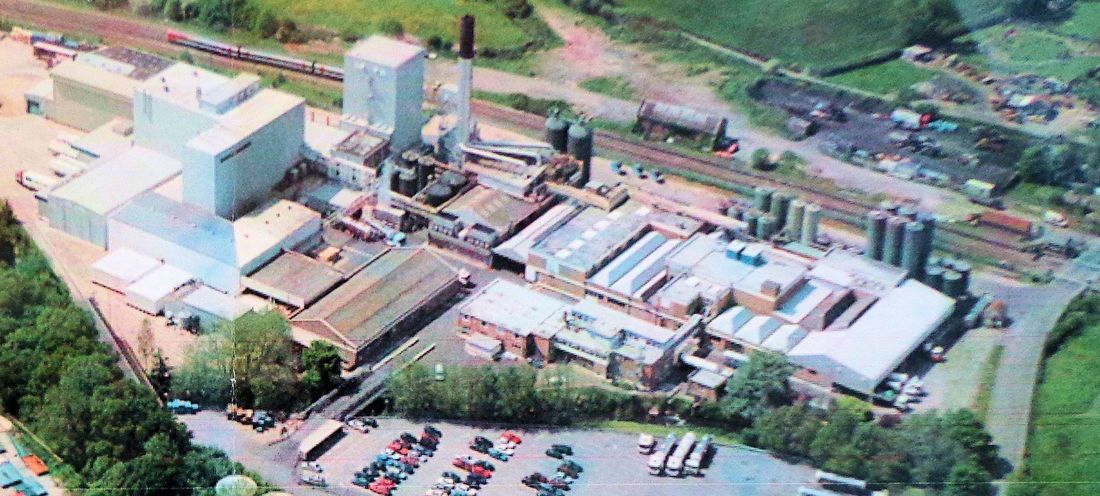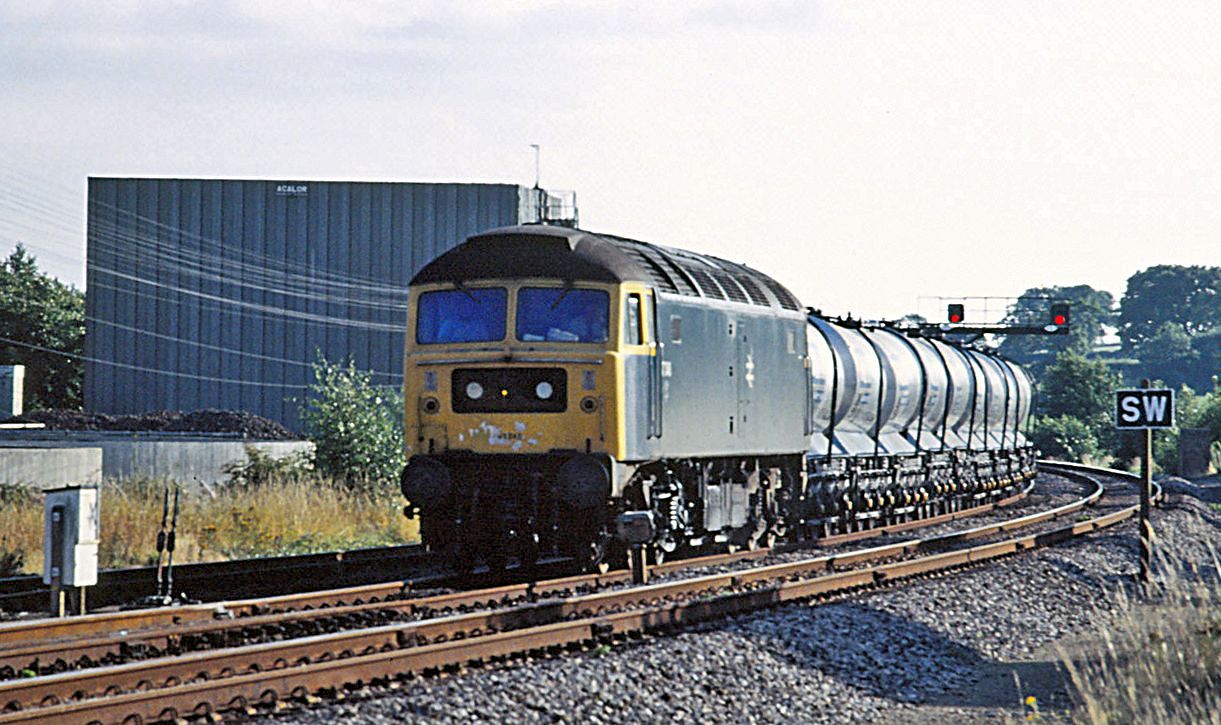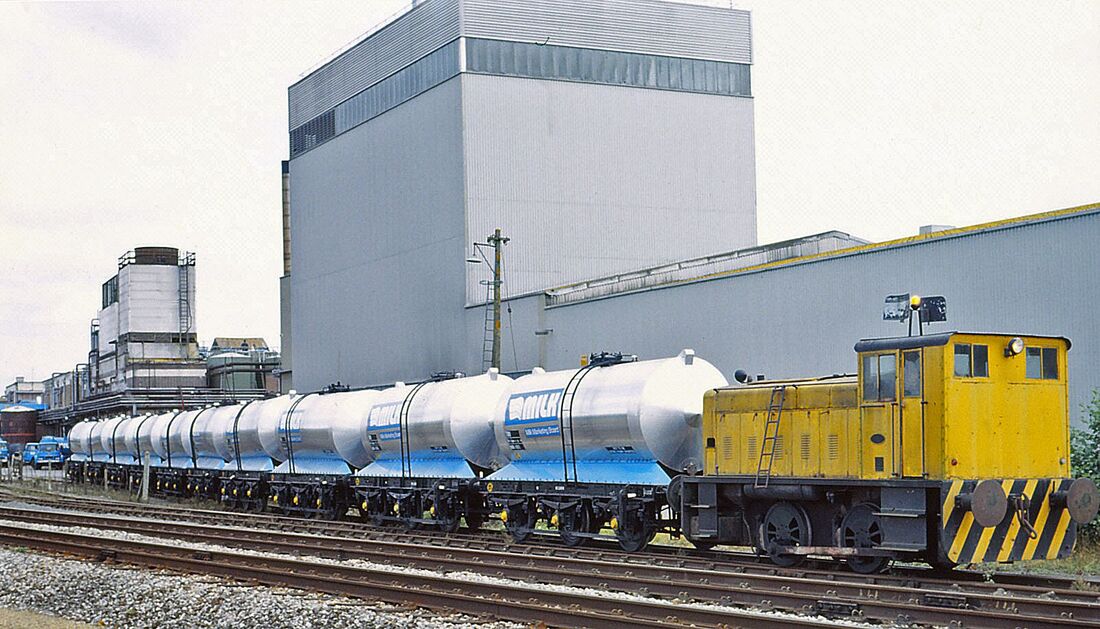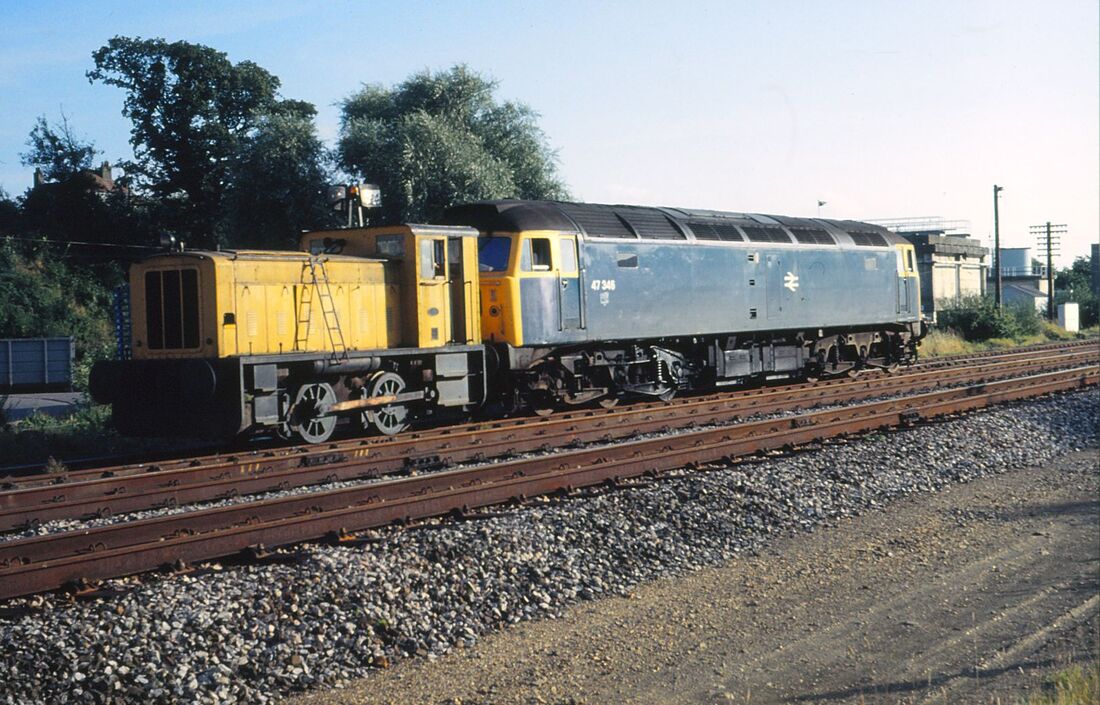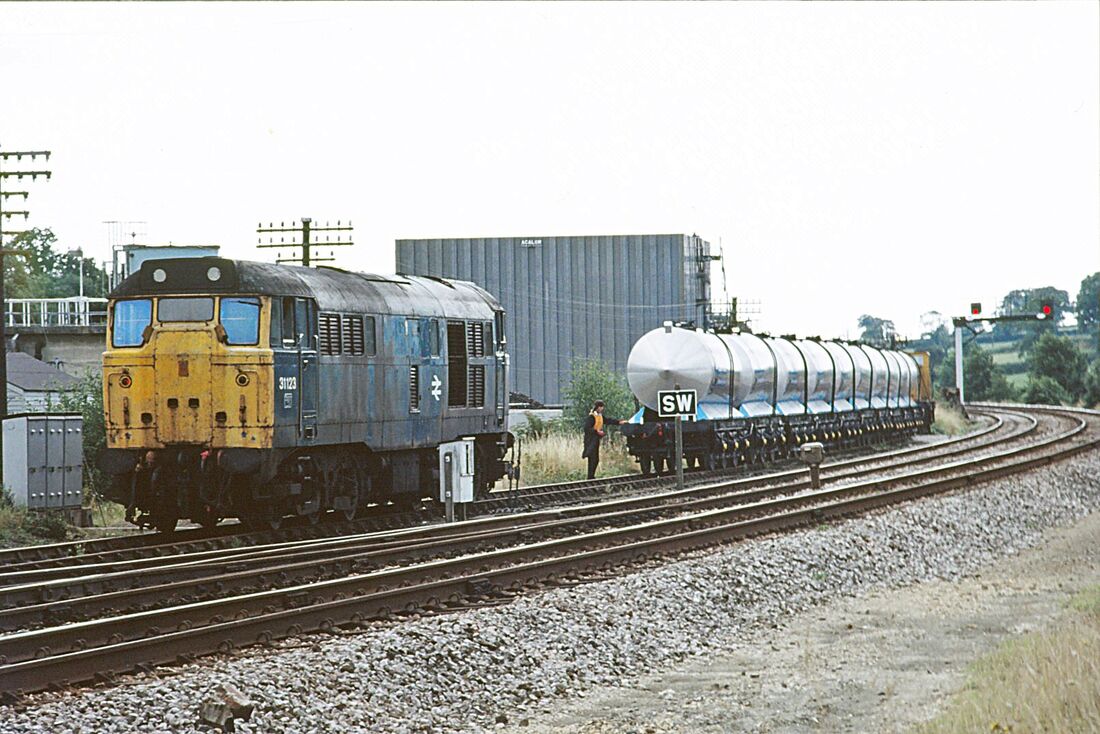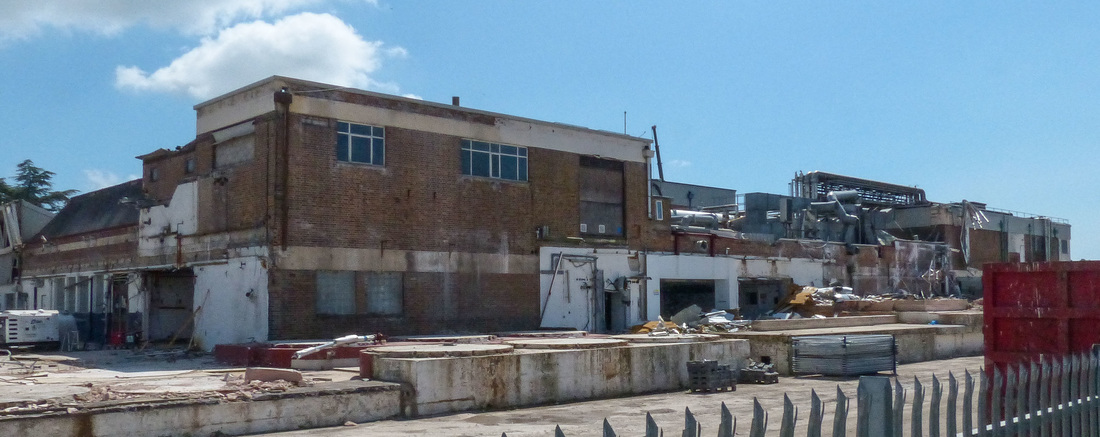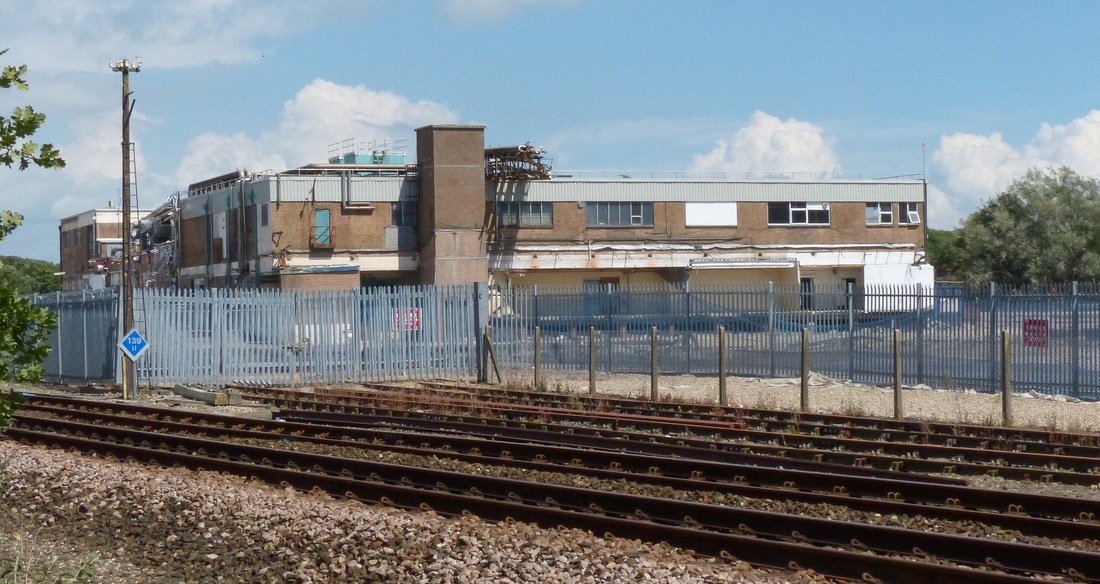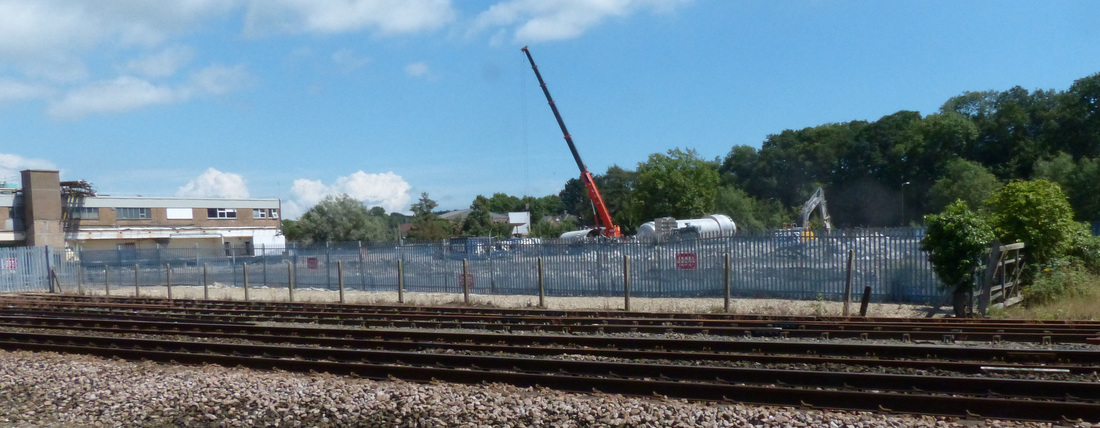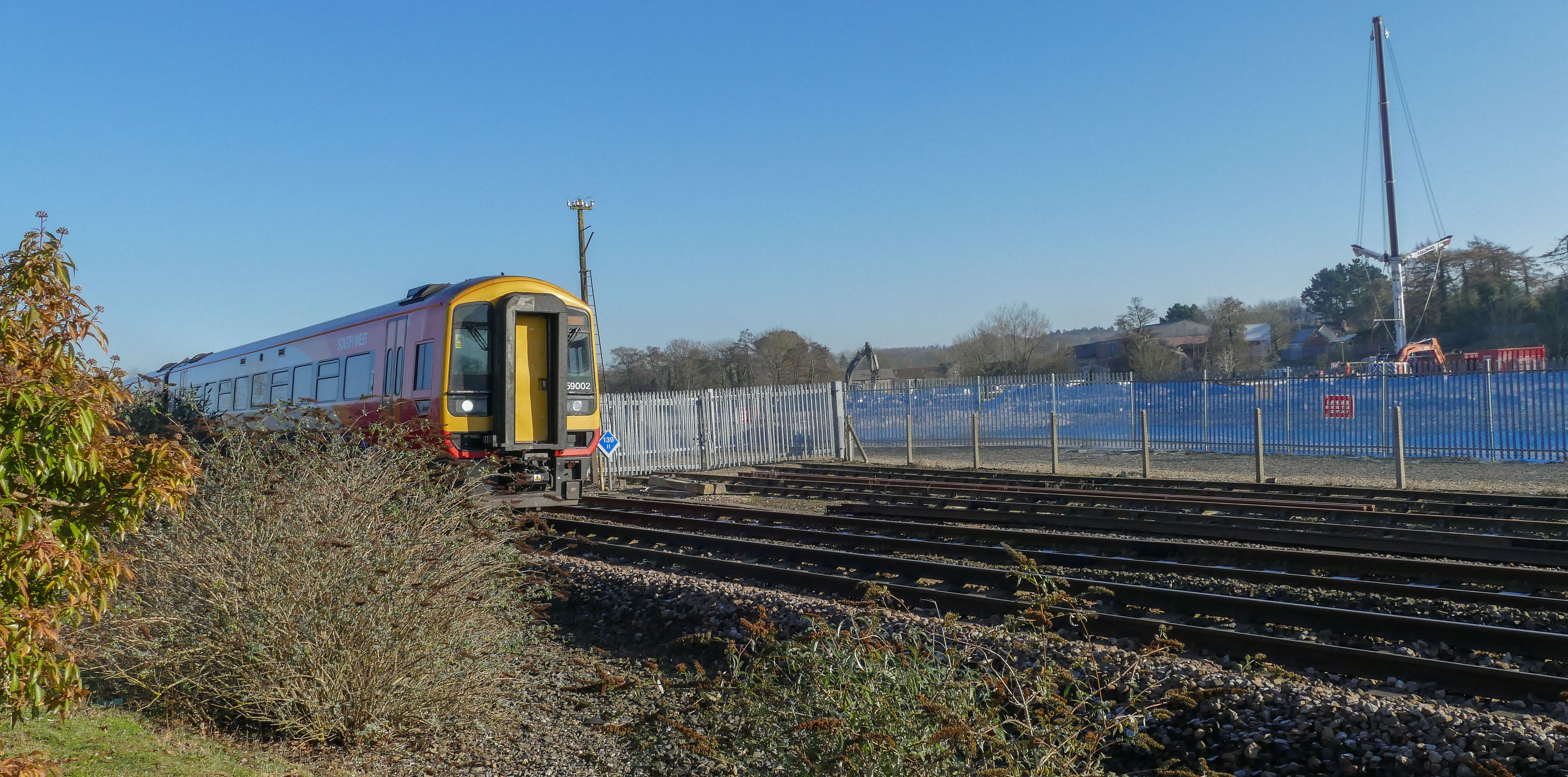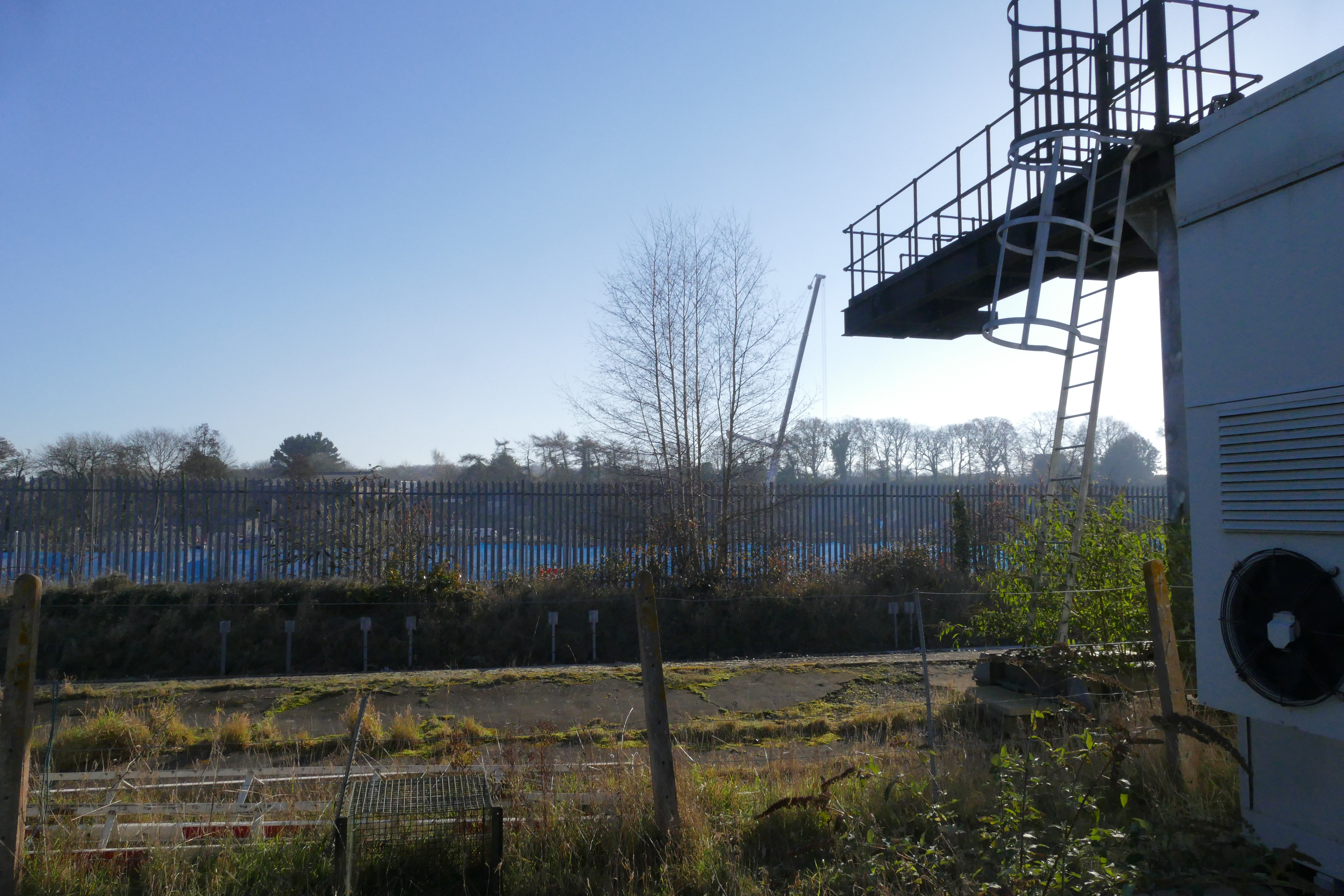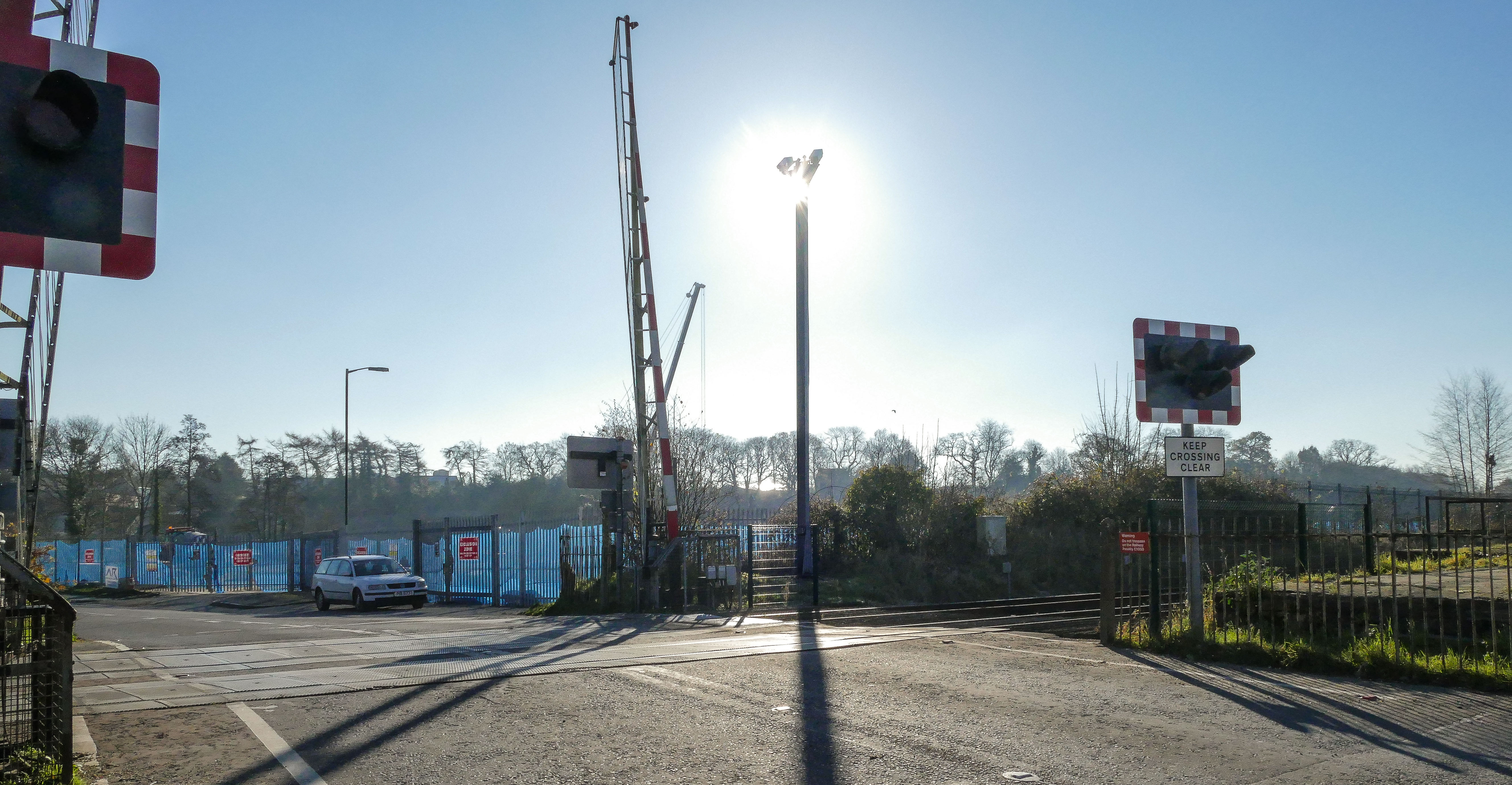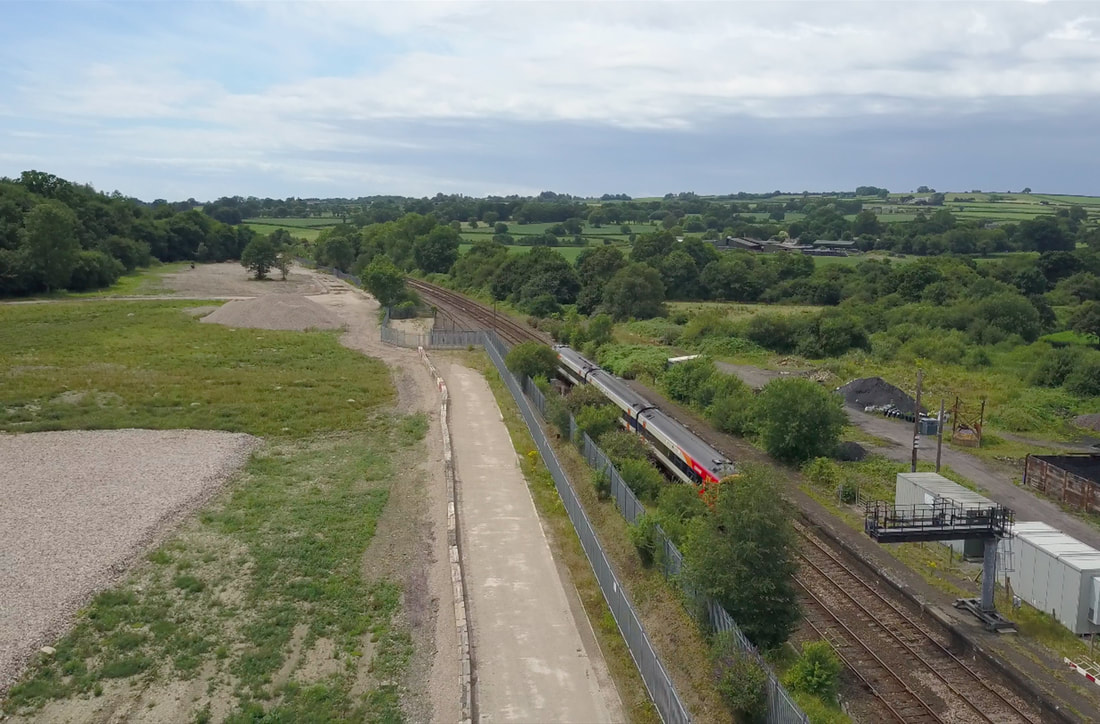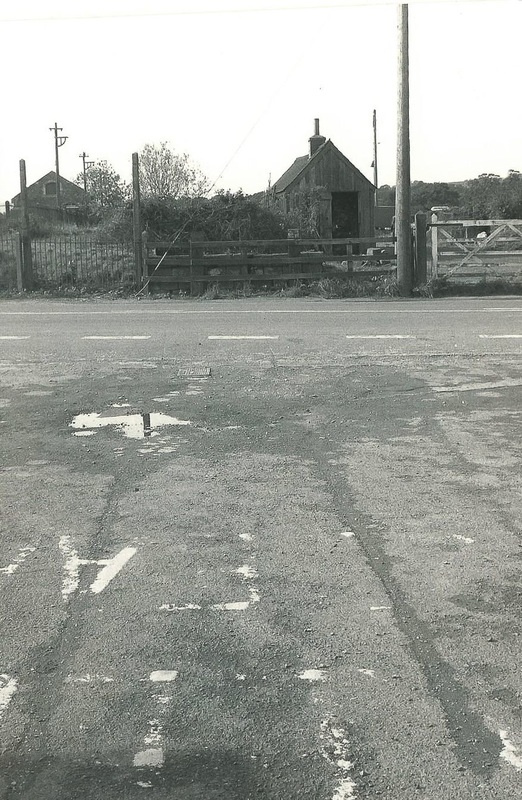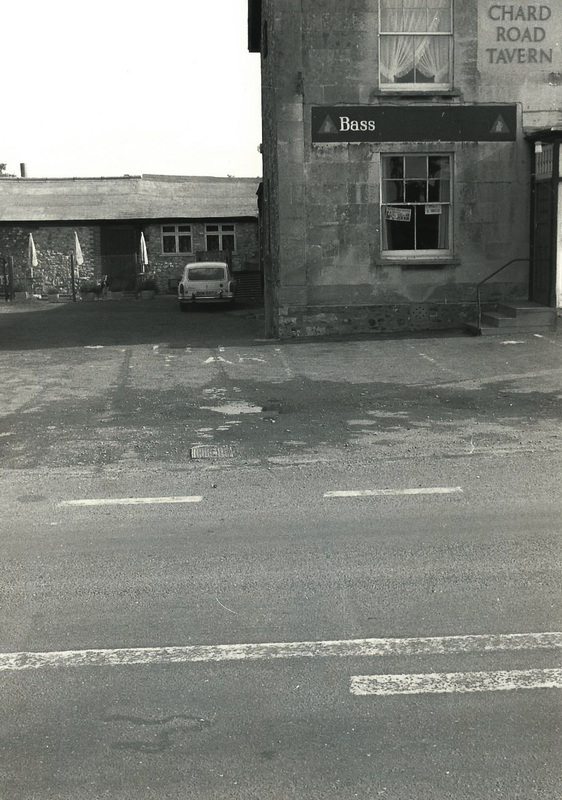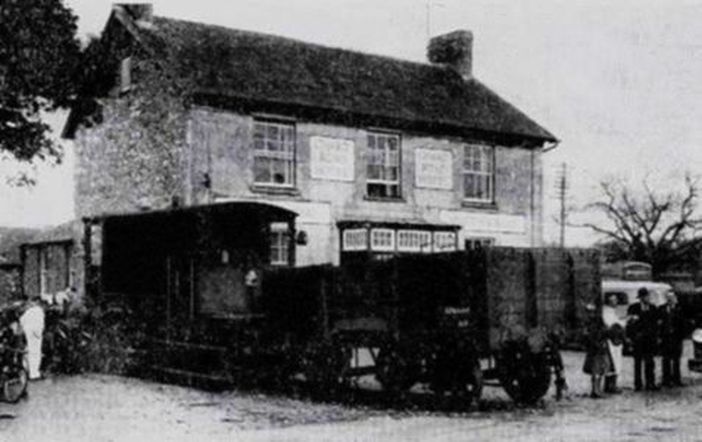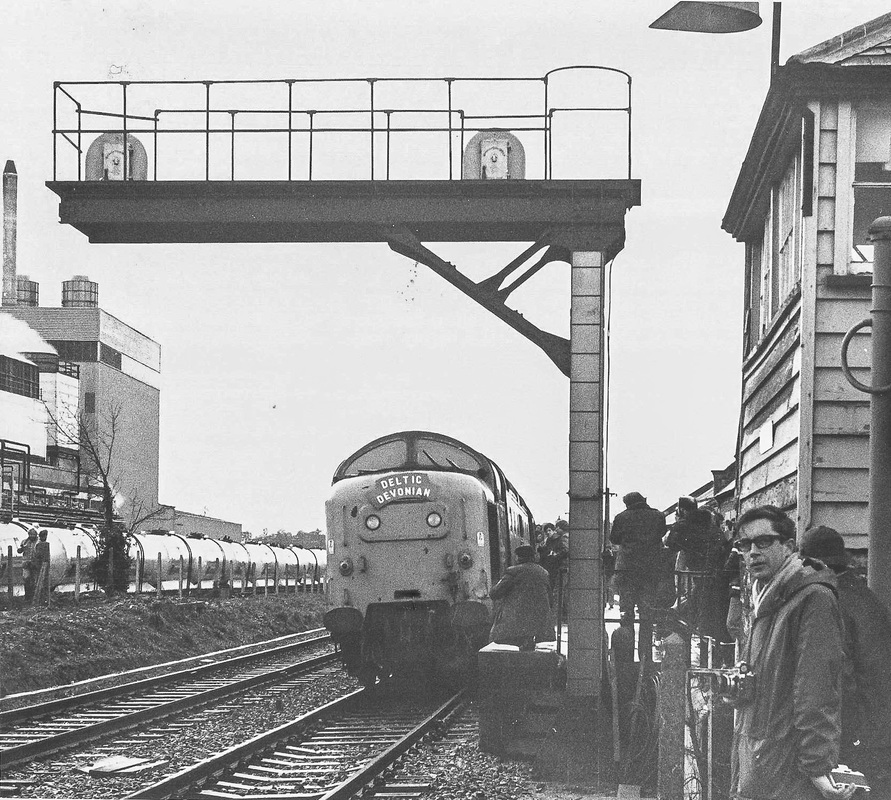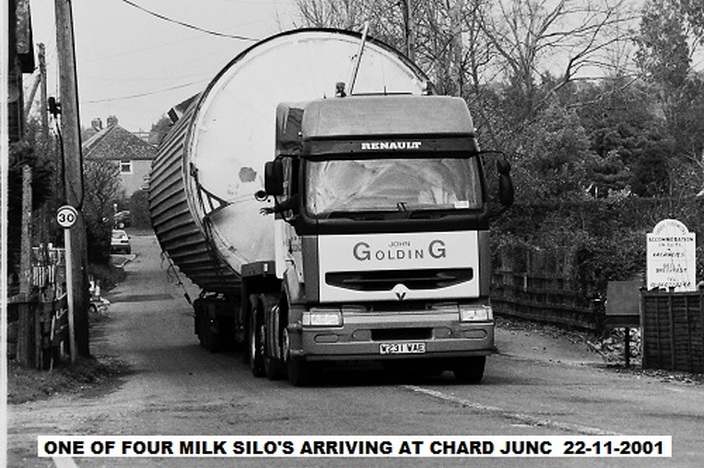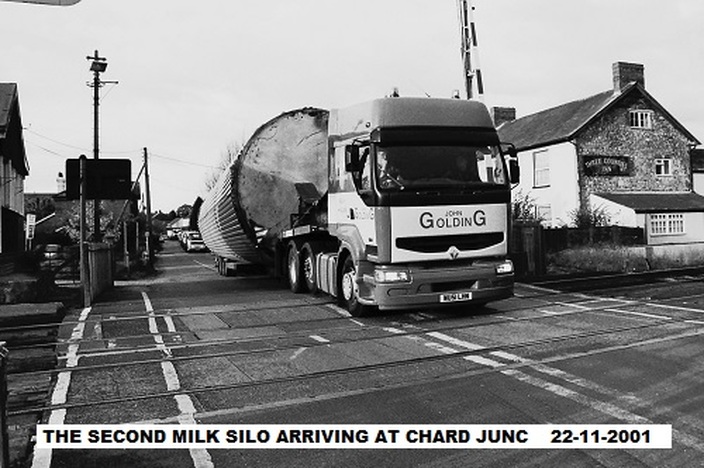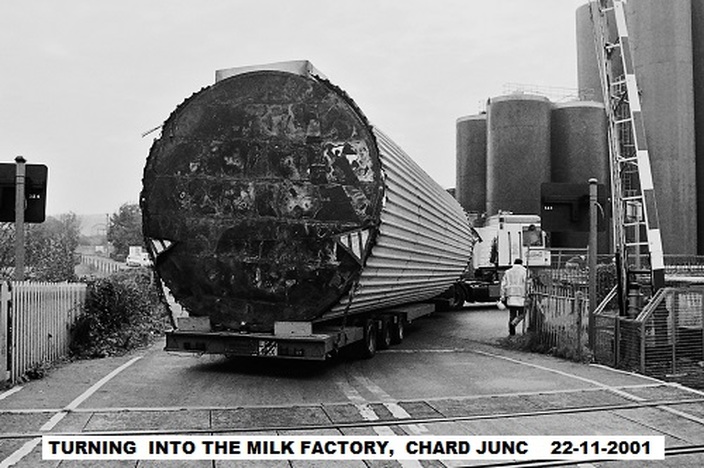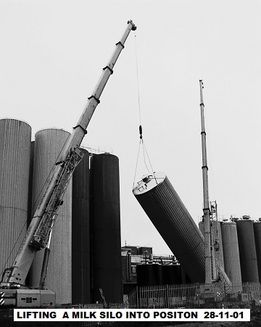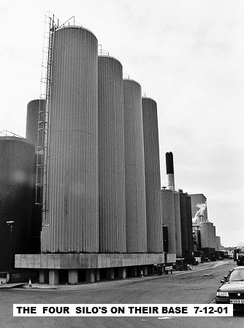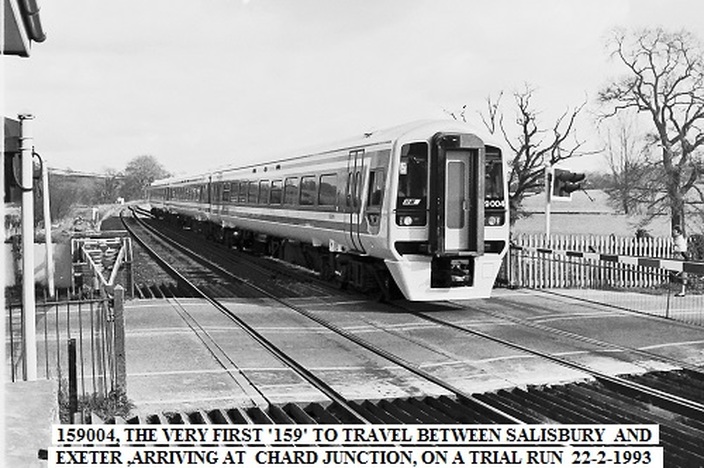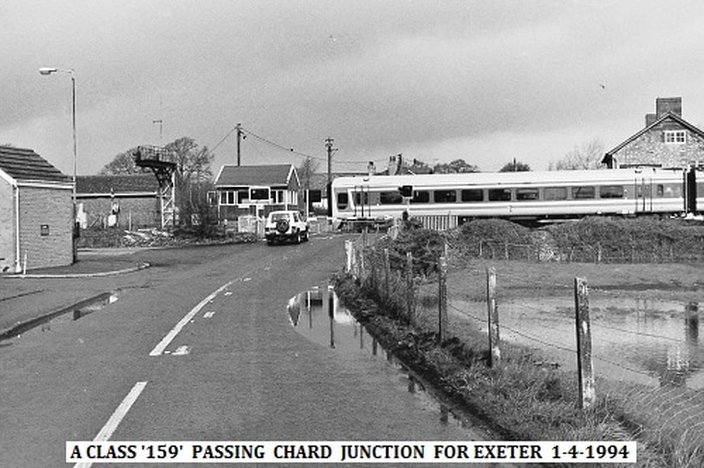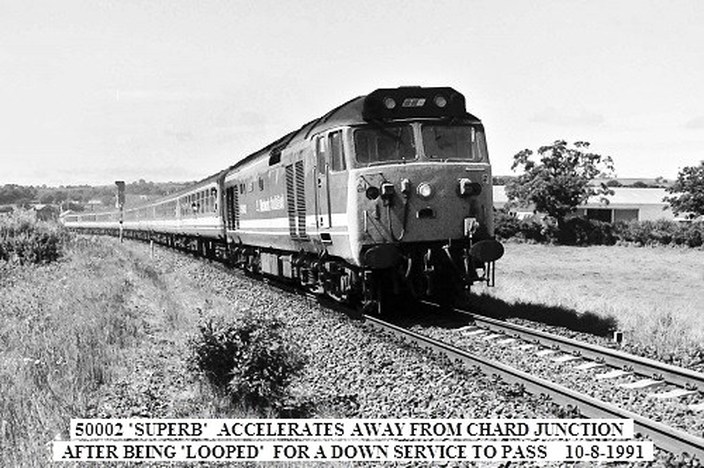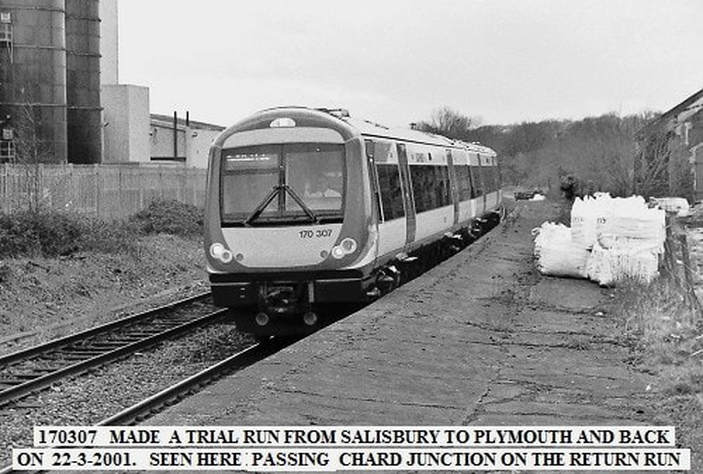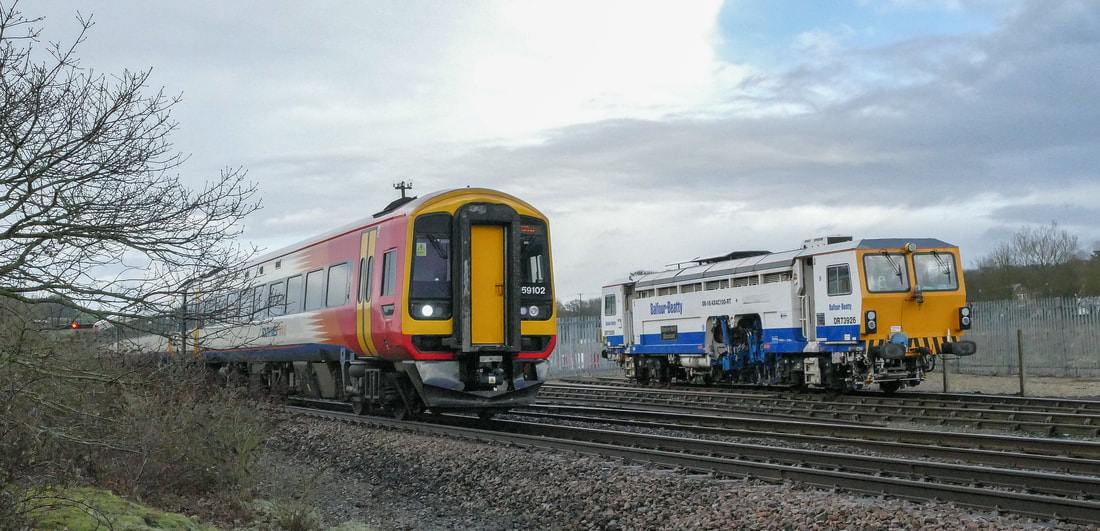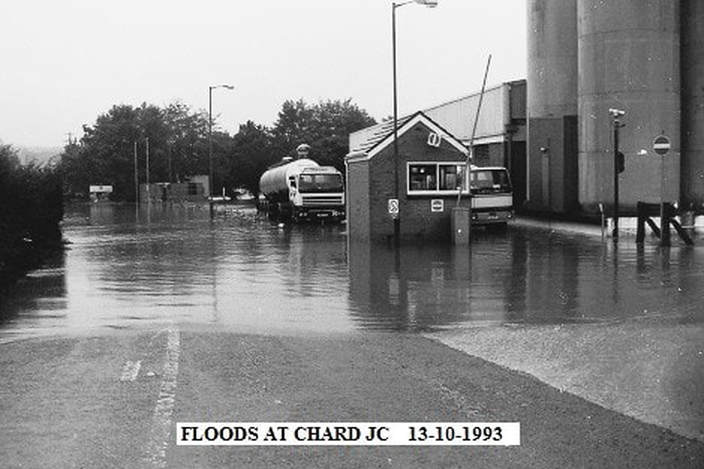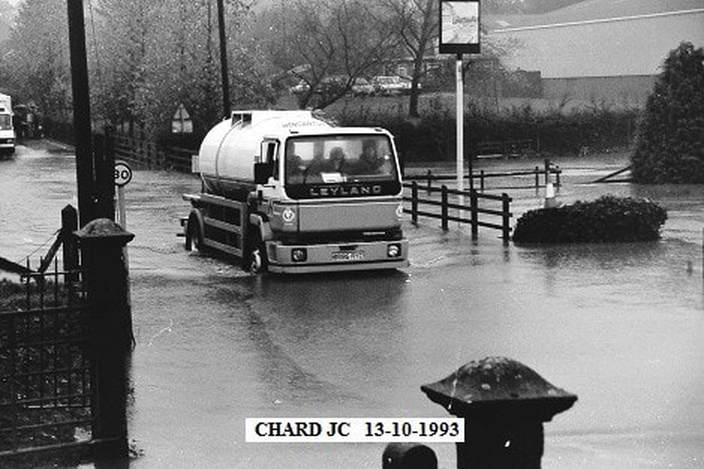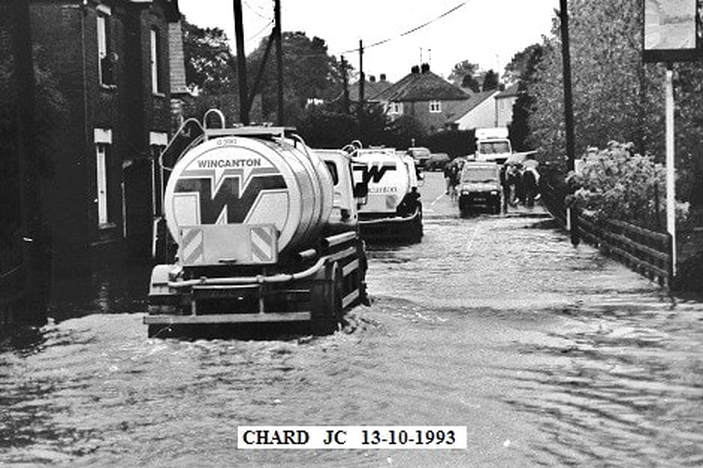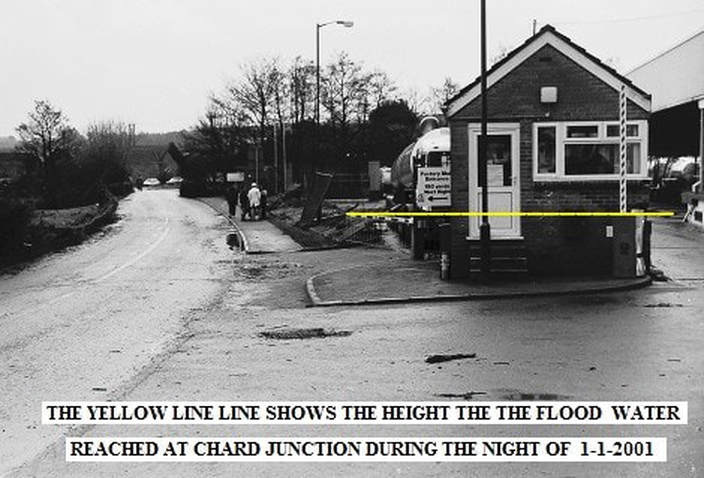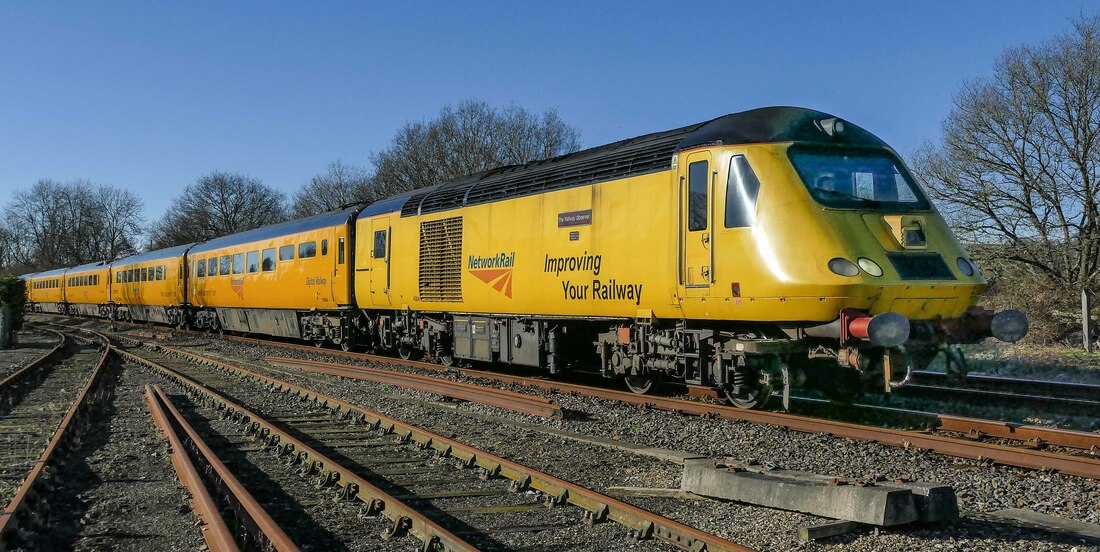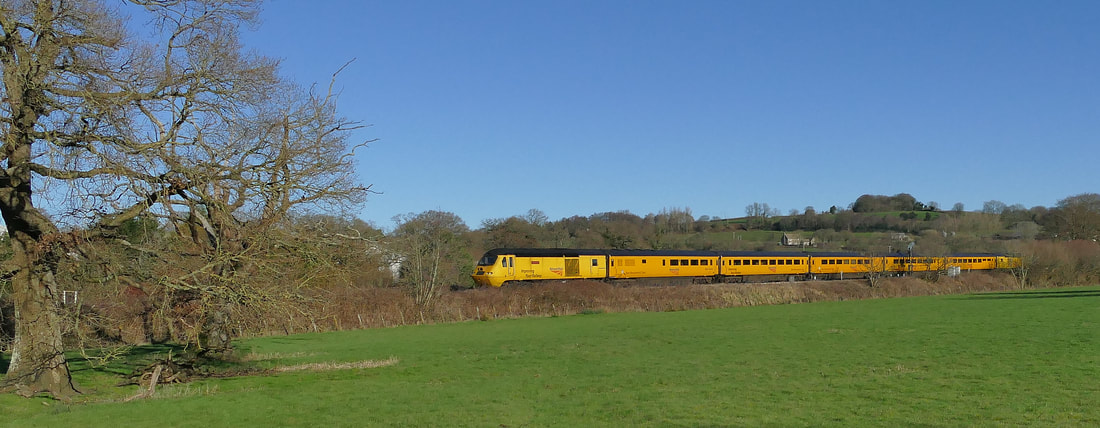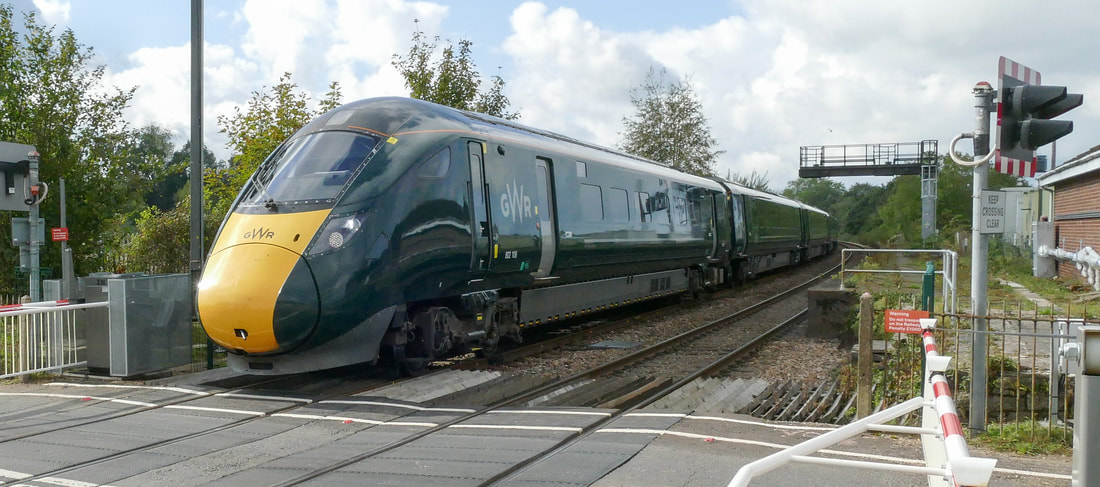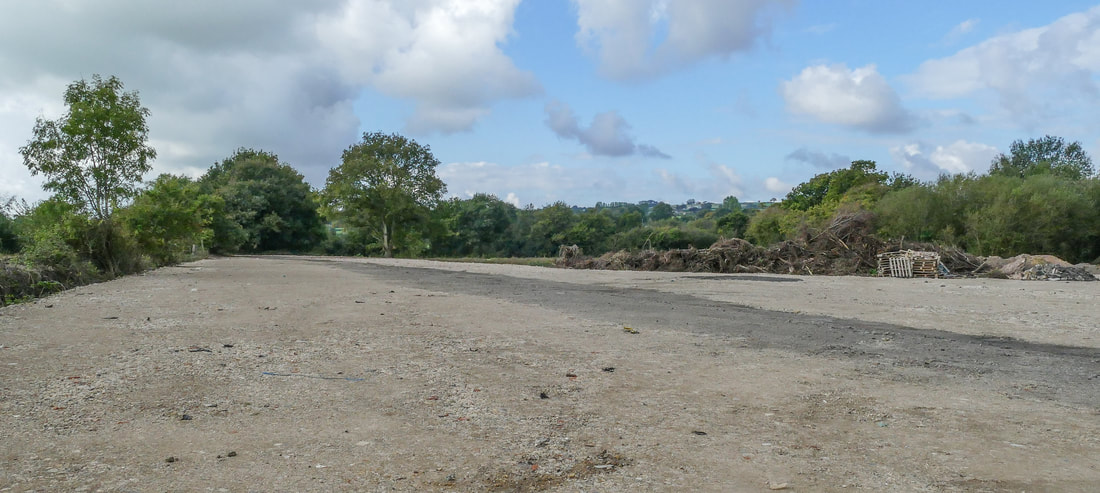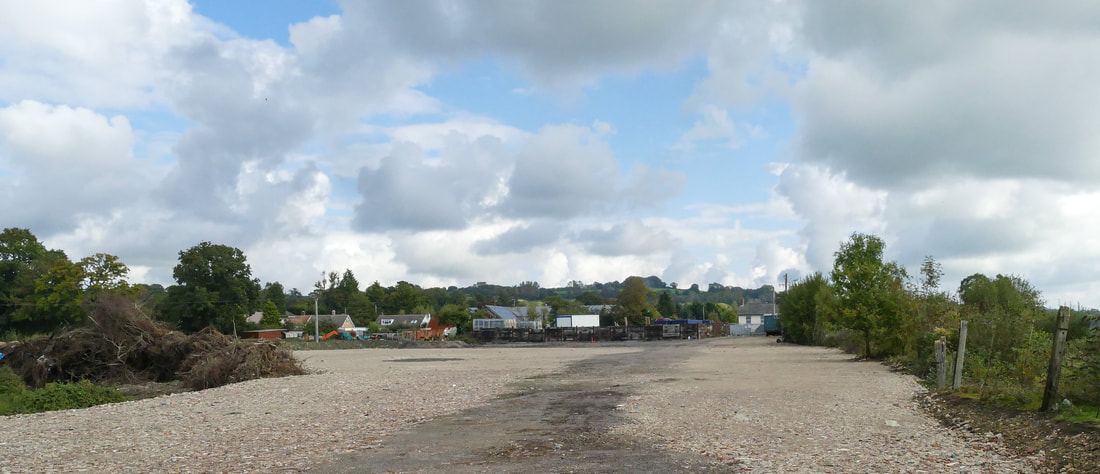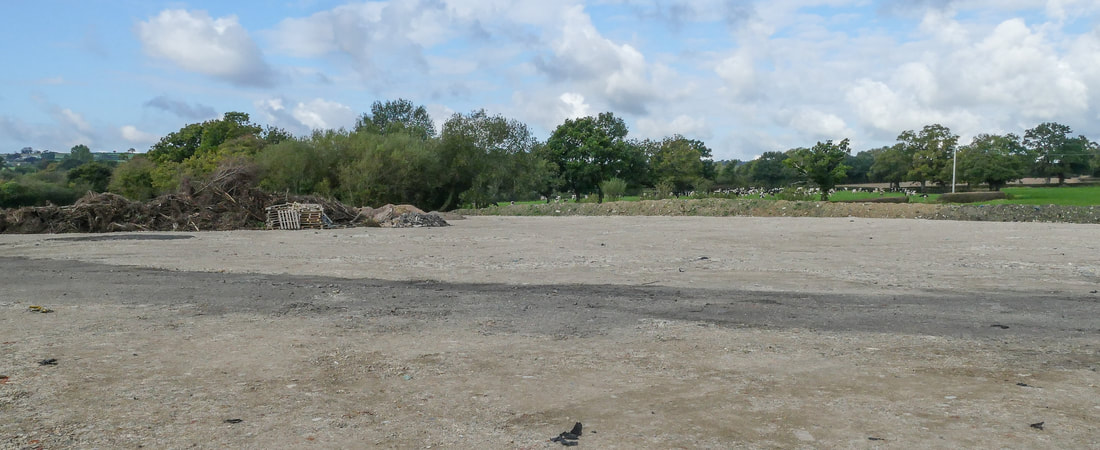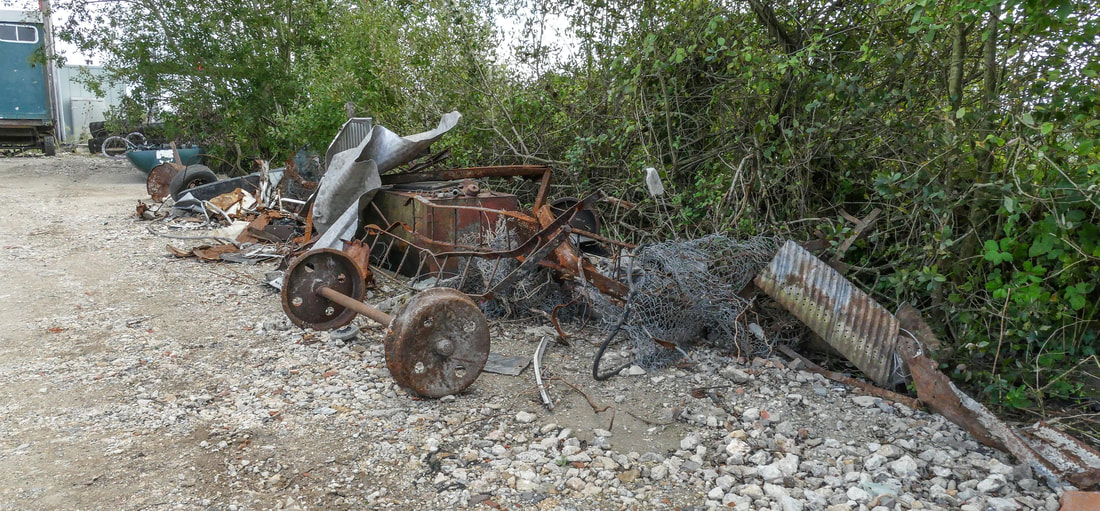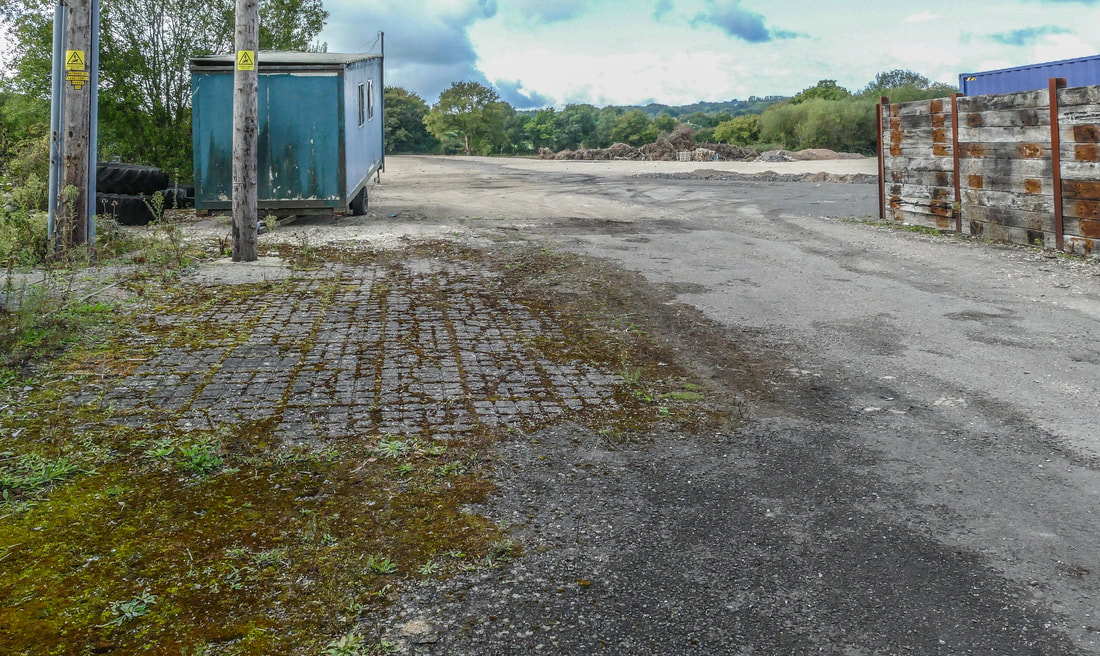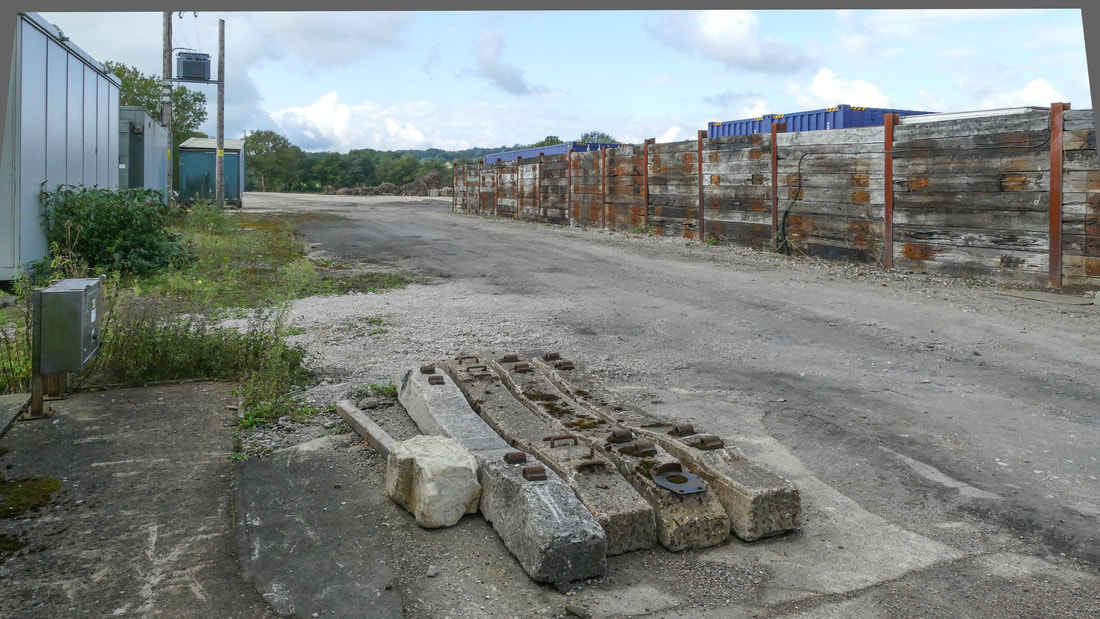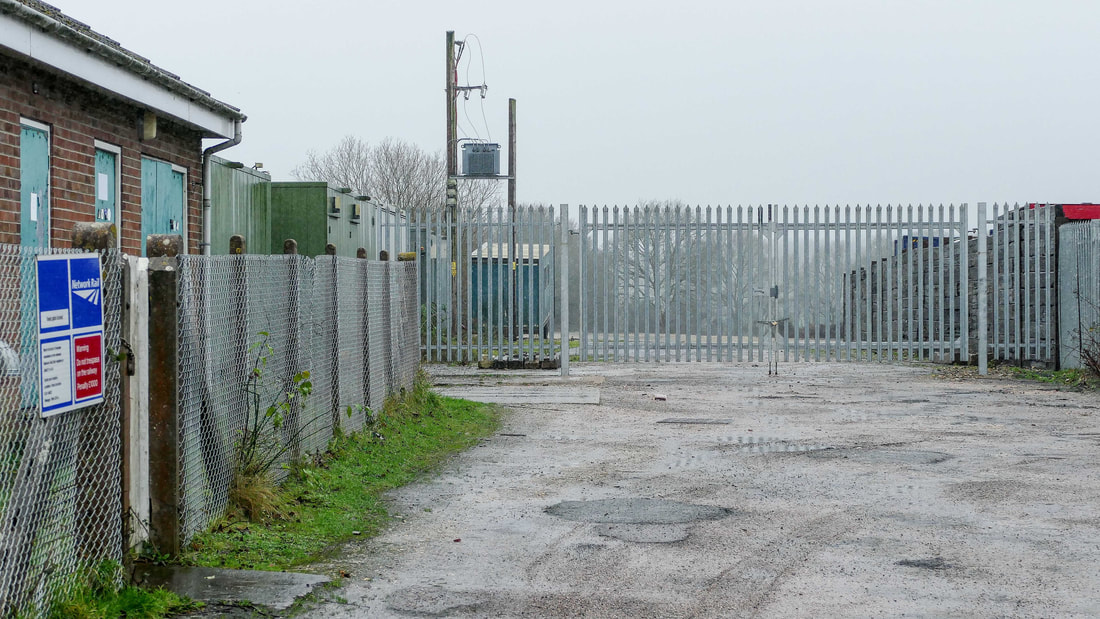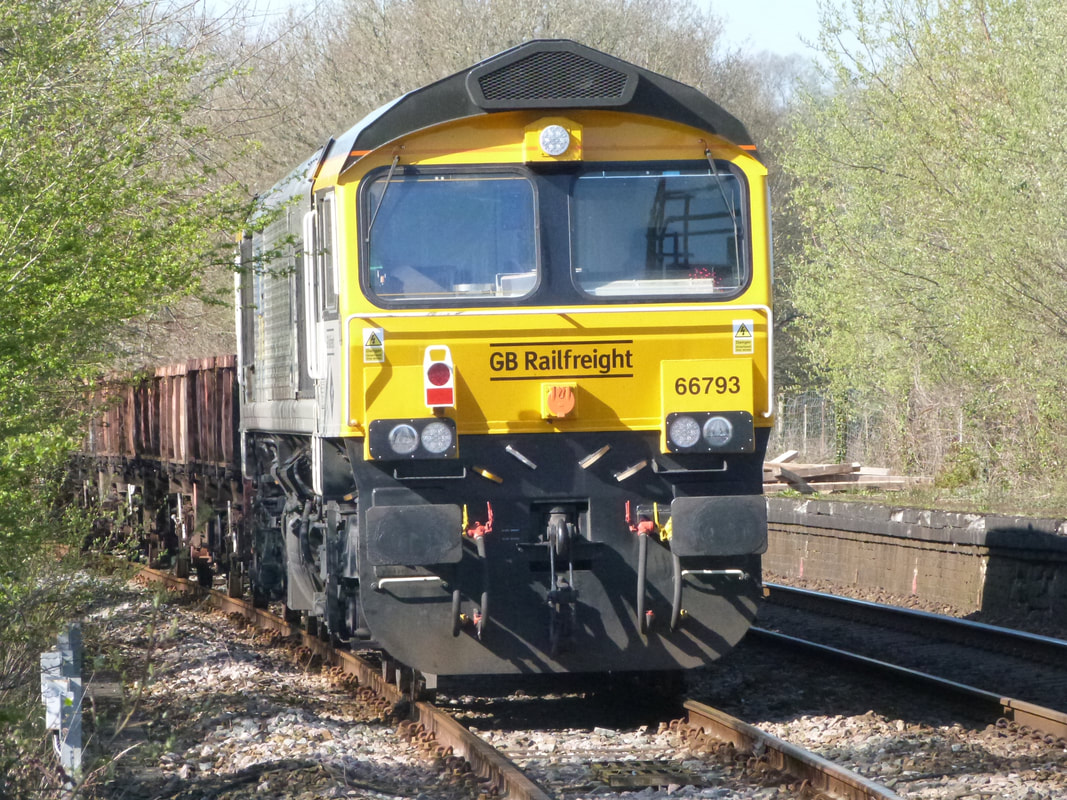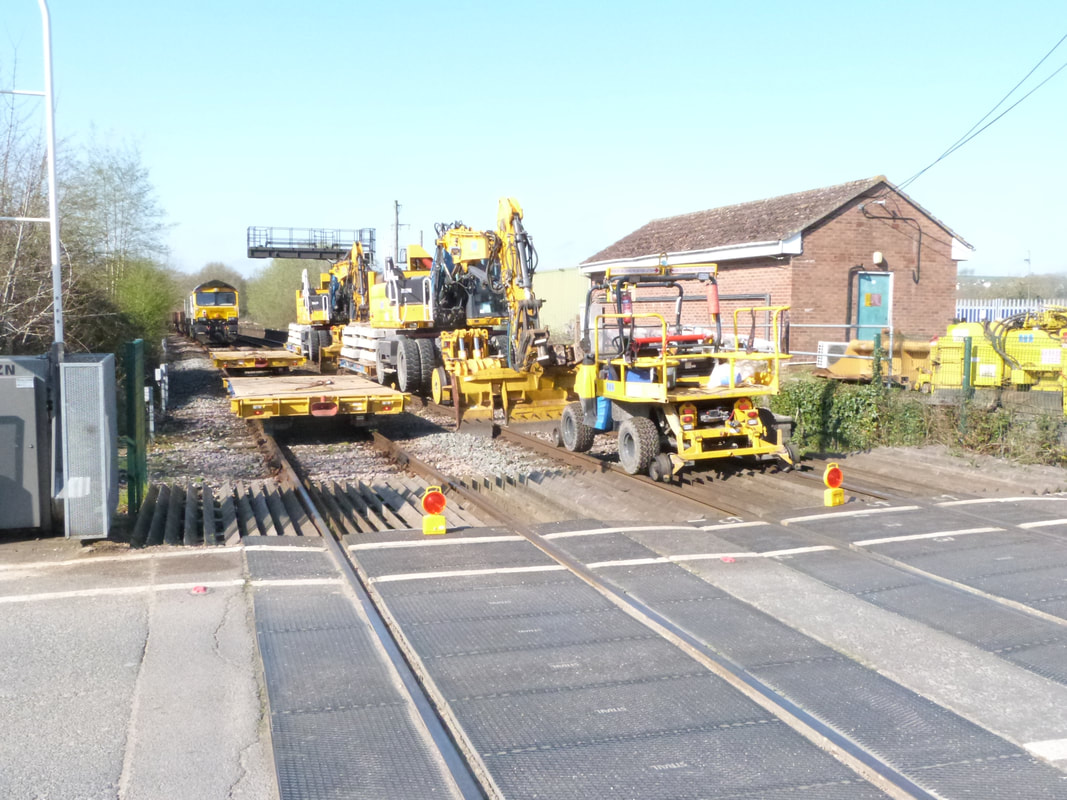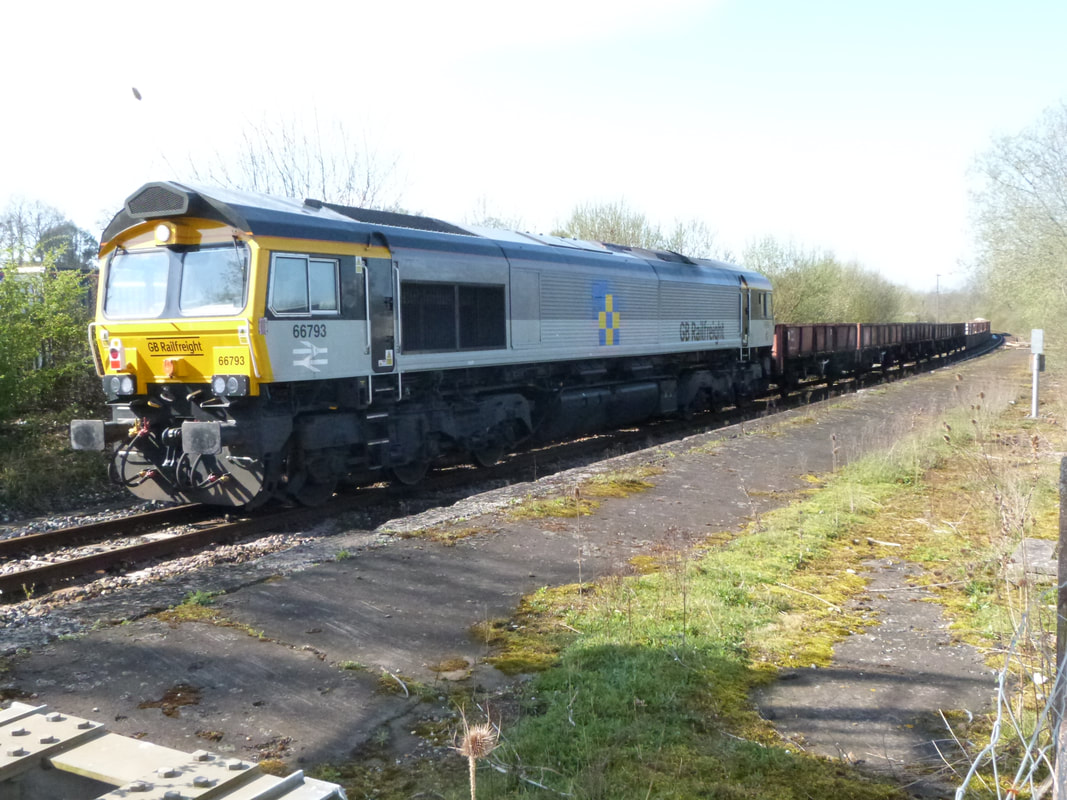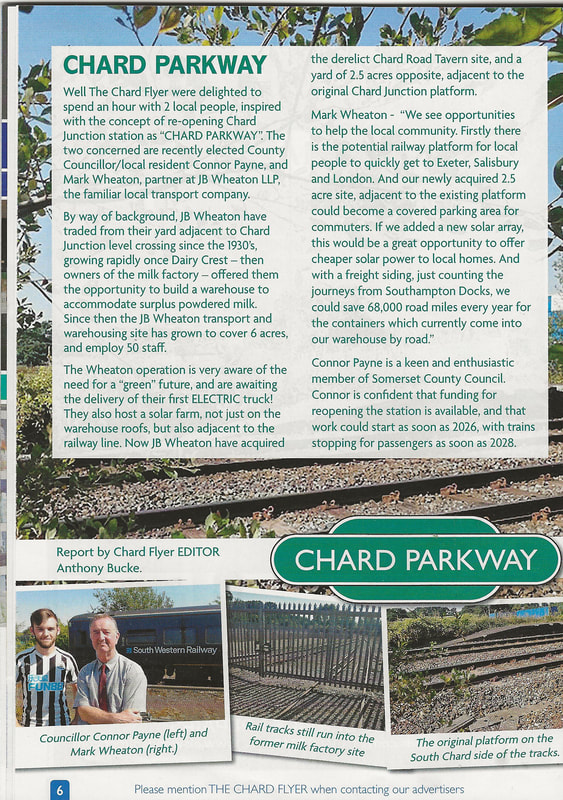Chard Junction
It is with many thanks especially to the late John Cornelius, a former signalman at the junction, that we have sufficient pictures at this location to pause a while. Also many thanks to Brian Pibworth for his contributions.
An excellent video Your attention is also drawn to an excellent video of scenes at Chard Junction using many pictures from our site which has been prepared by Mark Lancaster and placed on YouTube. Herewith a link to this most interesting collection of action at Chard Junction which includes both ground level and drone footage, many pictures from the CRS site. Please click here.
Speed limits over the passing loop at Chard
Brian Pibworth draws our attention to the fact that the reason why Down trains favour the old Up line at Chard Junction is now clear. The Down loop has a 25 mph limit compared with the Up, which has 85 mph - no contest unless there is a timetable necessity. Thank you Brian.
Brian Pibworth draws our attention to the fact that the reason why Down trains favour the old Up line at Chard Junction is now clear. The Down loop has a 25 mph limit compared with the Up, which has 85 mph - no contest unless there is a timetable necessity. Thank you Brian.
Milk Traffic from Chard Junction
An article by Brian Pibworth
An article by Brian Pibworth
In the course of catching up with "Cornwall Railways" postings, my eye was caught by Dave Tozer's reply re. refurbished milk tankers.
"I can only recall seeing them once heading to Chard Junction. I suspect they were never used much".
It rather depends on what you call "much", as during the summer of 1981 Chard Junction Creamery was host to freight movements unseen for several years, as two rakes of milk tanks, refurbished through some sort of EEC funding, carried surplus milk from the Milk Marketing Board creamery, to a similar plant at Stowmarket in Suffolk.
Unfortunately, while providing a spectacle for us local rail enthusiasts, the project suffered from the "dead hand" of BR and local self interest and didn't last long.
I may be a bit thin on remembering detail but as I recall, the working depended on an inspector, signaller, pilotman and shunter being driven in a Transit van the 60 miles from Westbury Shed to enable the mainline loco to access the milk siding and extract/return the tanks. This cavalcade was often late and the MMB shunter, restricted to their private siding and headshunt, was sometimes reluctant to start . Delay was the order of the day and there was still considerable local resentment of BR (W) taking over "our" freight as they scaled down the old Southern route in favour of "their" GWR main line to Exeter.
Having unlocked gates and points and shuffled the rolling stock, the train would eventually be dispatched eastwards, to the relief of Chard Junction Signal Box, who viewed the whole exercise with great scepticism. The full trains took the Southern route to Yeovil Jnc then via Castle Cary to Stowmarket, but returned the empties via Exeter.
The last nail in the coffin resulted from the lack of washout facilities at Stowmarket which meant that the empties spent many hours sitting in the summer sun with the residual milk contents rapidly "going off". On return to Chard, one of the milk dock reception gang was detailed to climb into the tank and clean out the curdled mess with just a brush and hosepipe. For this privilege he was awarded 50p per tank and there was significant resistance to taking on the task, not only from the workers but also from wives burdened with additional laundry. Added to this, the job theoretically took road driving turns away from the Chard plant, so the project was doomed even before the EEC funding ran out and after a few fits and starts eventually ceased later that year.
So Dave is right to say they were never used much, but when they were, we certainly enjoyed the spectacle.
Best Wishes. Brian Pibworth Very many thanks to Brian for his notes and photographs.
Many thanks to Brian Pibworth for this account of a very short but interesting period in the history of Chard junction.
A footnote from Andy Richards dated 8th March 2016 Excellent article on the Chard Junction Creamery. I moved to Chard Junction in 1998 (no milk train then unfortunately) when the St Erth Dairy shut.
I stayed at Chard until 2008 before moving on. In 1998 Chard was part of the St Ivel group, St Ivel sold Chard to Dairy Crest in 2001. Sadly Chard shut its doors for the last time in September 2015. The site has been decommissioned and if the rumours are correct demolishion will start shortly. Another part of the railway history gone for ever.
I stayed at Chard until 2008 before moving on. In 1998 Chard was part of the St Ivel group, St Ivel sold Chard to Dairy Crest in 2001. Sadly Chard shut its doors for the last time in September 2015. The site has been decommissioned and if the rumours are correct demolishion will start shortly. Another part of the railway history gone for ever.
IT was the end of an era on Friday night 9th March 2012 as Chard Junction’s historic signal box saw its final train through the former station. At 23.53 the last train to be signalled by the signal box passed through on its way to Salisbury. From Monday, trains between Yeovil and Honiton started to be controlled by a state-of-the-art Signalling Control Centre at Basingstoke. By April 2012, all remaining signal boxes between Salisbury and Exmouth Junction will have transferred to Basingstoke to end 148 years of manual signalling on the line to Exeter. There has been a signal box at Chard Junction for 137 years with the current box replacing the original in 1982, but re-using the original stone base. The last train was passed through by signalman Tim Hoad, who worked on the railway for 23 years, 16 of them at Chard, and Chris Phillimore, managing director of railway consultancy and equipment company TIR, watched it race through at midnight. From This is the West Country 15th March 2012
More notes on Chard Junction Signalbox kindly provided by Martin Duff, Operations Manager
Reference photographs below. Seen on a freezing Sunday morning in December 2010 during a visit when I was on-call. The panel at Chard seen in the photograph was short lived, it was provided in 2009 when a new dynamic loop was provided at Axminster to allow an hourly service to operate (services to Paignton and Plymouth finished at the same time). The box was new in late 1982 (the earlier structure already the subject of a fine study by Roger Winnen on the CRS web pages) and was pleasantly situated on the up side of the line, almost opposite the former creamery. With the hourly service, occasional diverted HST's and ad hoc moves it was a reasonably busy place to work, especially with passing trains at Axminster and supervising the CCTV level crossing there too. Closure came in March 2012 when all signalling was re-controlled up to Basingstoke in phase 2 of 3 for the Salisbury - Exeter scheme. Sadly the structure came down within weeks - literally disappearing one mid week night. The panel however survives as an exhibit in Yeovil Railway Centre. When it was decommissioned I made enquiries of my colleagues in NR and there was no use for the panel and it was not required as strategic reserve, even its shell so it was gifted to YRC.
Reference photographs below. Seen on a freezing Sunday morning in December 2010 during a visit when I was on-call. The panel at Chard seen in the photograph was short lived, it was provided in 2009 when a new dynamic loop was provided at Axminster to allow an hourly service to operate (services to Paignton and Plymouth finished at the same time). The box was new in late 1982 (the earlier structure already the subject of a fine study by Roger Winnen on the CRS web pages) and was pleasantly situated on the up side of the line, almost opposite the former creamery. With the hourly service, occasional diverted HST's and ad hoc moves it was a reasonably busy place to work, especially with passing trains at Axminster and supervising the CCTV level crossing there too. Closure came in March 2012 when all signalling was re-controlled up to Basingstoke in phase 2 of 3 for the Salisbury - Exeter scheme. Sadly the structure came down within weeks - literally disappearing one mid week night. The panel however survives as an exhibit in Yeovil Railway Centre. When it was decommissioned I made enquiries of my colleagues in NR and there was no use for the panel and it was not required as strategic reserve, even its shell so it was gifted to YRC.
THE END.
Chard Junction Box on the last day.
Chard Junction Box on the last day.
Further to the above picture Graham Mann kindly responds :- Just responding to today’s piece on the Axminster gang pic, I believe Geoff Matthews may have ended up as a Section Manager in Salisbury, but Matt Tyne worked for me at Exeter as a Works Delivery Manager from 2008, he left the Railway circa 2010 I’m now volunteering on the Plym Valley Railway keeping my hand in so to speak ! Keep up the good work. Regards Graham Many thanks Graham
'When the railways were privatised 0n 1-4-1994, my signalman colleague at Chard Junction, Bill Love and I thought we would like to mark the passing of the nationalised British Rail. So we painted a headstone and placed it behind one of our flower beds. It was well received by the locals.
Then the local press became interested and pictures appeared in the local papers,finally the TV news sent a cameraman down to film it and it appeared on the local West of England evening news,its fame had spread far and wide. But after a week management asked us to discreetly remove it. I think they were a bit embarrased over the attention it had received.
But Bill and I had a good laugh about it and besides it was good clean fun.'
CHEERS JOHN C.
Then the local press became interested and pictures appeared in the local papers,finally the TV news sent a cameraman down to film it and it appeared on the local West of England evening news,its fame had spread far and wide. But after a week management asked us to discreetly remove it. I think they were a bit embarrased over the attention it had received.
But Bill and I had a good laugh about it and besides it was good clean fun.'
CHEERS JOHN C.
An Interlude
A review of pictures at Chard Junction collected by John Cornelius while he was signalman.
A review of pictures at Chard Junction collected by John Cornelius while he was signalman.
Pausing a while at Chard Junction.
D449 had taken D821 Greyhound, temporarily renamed 'Cornwall', to Falmouth Docks for a twinning ceremony with a Royal Navy ship of the same name - this occurred on the 24th March 2001. Subsequently D821 visited the Bodmin and Wenford Railway for a spell before moving on up country.
D449 had taken D821 Greyhound, temporarily renamed 'Cornwall', to Falmouth Docks for a twinning ceremony with a Royal Navy ship of the same name - this occurred on the 24th March 2001. Subsequently D821 visited the Bodmin and Wenford Railway for a spell before moving on up country.
It couldn't have happened at a worse time and place! A report from John Cornelius, at the time he was signalman at Chard Junction. Many thanks for this report.
This happened around 06.30 at Chard Junction on March 16th 1997, when a machine leaving an engineers possession suffered a broken hydraulic oil pipe and became a total failure on the crossing, stopping lorries from reaching the milk factory and causing a queue back for nearly a mile.Luckily trains were not affected as they used the loop. The only road traffic that could get by was cars, small vans and cycles.
The crossing was blocked for around three hours whilst waitng for a spare pipe to be brought to site.
When it arrived, it didn't take the mechanic long to fix it and to everyone's relief the machine was moved off the crossing and into the yard and the delayed traffic was able to get moving again.
Just another day of life on the railway. cheers JOHN C.
The crossing was blocked for around three hours whilst waitng for a spare pipe to be brought to site.
When it arrived, it didn't take the mechanic long to fix it and to everyone's relief the machine was moved off the crossing and into the yard and the delayed traffic was able to get moving again.
Just another day of life on the railway. cheers JOHN C.
Also pictures of an earlier possession at Chard Junction.
The earlier days of the Creamery at Chard Junction Andy Richards
Just looked at the article by Mark Lancaster on Chard Junction on the website, great article.
Not sure if its a common known fact but Chard Junction Creamy had 4 coal boilers for steam generation up the mid 2000's.
If you look at the pictures of the creamery from the railway side there was two green silo's with domed tops, these were our coal hoppers. The noise when the lorries off loaded into the silos was horrendous, as you can imagine we were not to popular with the neighbours also the boilers use to chuck out fine black bit of ash. It was quite common to go to the car park on the way to find the roof of your car covered in little black bits.
Having just moved jobs due to the closure of Evercreech (this was the last factory left of the old Unigate/St Ivel empire in the South West) reminded me I still have the pictures attached. I think we said we would credit them to the Andrew Tredrea collection. They would make interesting viewing for your readers as the curtains have closed on the local dairy industry and railway infrastructure for the good
Not sure if its a common known fact but Chard Junction Creamy had 4 coal boilers for steam generation up the mid 2000's.
If you look at the pictures of the creamery from the railway side there was two green silo's with domed tops, these were our coal hoppers. The noise when the lorries off loaded into the silos was horrendous, as you can imagine we were not to popular with the neighbours also the boilers use to chuck out fine black bit of ash. It was quite common to go to the car park on the way to find the roof of your car covered in little black bits.
Having just moved jobs due to the closure of Evercreech (this was the last factory left of the old Unigate/St Ivel empire in the South West) reminded me I still have the pictures attached. I think we said we would credit them to the Andrew Tredrea collection. They would make interesting viewing for your readers as the curtains have closed on the local dairy industry and railway infrastructure for the good
A question on
Creamery Operations at Chard and Seaton.
- posed by Brian Pibworth
Creamery Operations at Chard and Seaton.
- posed by Brian Pibworth
Question posed on the 9th February 2022.
Good Morning Keith,
While rummaging through my slides of Chard Junction, taken during the 1981 milk traffic resurgence, I came across a few which I had omitted from our CRS Archive pages. It is just about possible to work out how PO and BR locos managed to shunt the full and empty tanks to assemble a train to run from the CJ creamery to Stowmarket - even sometimes when the Creamery loco wouldn't start and the mainline locos did the job alone.
However, a bit further West and 20 or so years earlier we had the busy Express Dairy Milk and Egg Depot at Seaton Junction and try as i might I can't understand how they managed to shunt their tanks and vans, apparently without benefit of a private owner loco. There is plenty of evidence, including pictures, of the Seaton Branch loco, sometimes still attached to the Pull/Push set (!), shunting the Milk Depot sidings. But according to track plans there was no run around off the main line and a move to haul filled tanks from the Depot into the long Up Sidings would surely leave the loco trapped. Similarly how did did empty tanks reach the depot if they were dropped off from a down train? Was there a horse? Gravity? Pinch-bar?
Any help from members in solving this Shunting Puzzle would be much appreciated.
With kind regards to you both,
Brian Pibworth
Good Morning Keith,
While rummaging through my slides of Chard Junction, taken during the 1981 milk traffic resurgence, I came across a few which I had omitted from our CRS Archive pages. It is just about possible to work out how PO and BR locos managed to shunt the full and empty tanks to assemble a train to run from the CJ creamery to Stowmarket - even sometimes when the Creamery loco wouldn't start and the mainline locos did the job alone.
However, a bit further West and 20 or so years earlier we had the busy Express Dairy Milk and Egg Depot at Seaton Junction and try as i might I can't understand how they managed to shunt their tanks and vans, apparently without benefit of a private owner loco. There is plenty of evidence, including pictures, of the Seaton Branch loco, sometimes still attached to the Pull/Push set (!), shunting the Milk Depot sidings. But according to track plans there was no run around off the main line and a move to haul filled tanks from the Depot into the long Up Sidings would surely leave the loco trapped. Similarly how did did empty tanks reach the depot if they were dropped off from a down train? Was there a horse? Gravity? Pinch-bar?
Any help from members in solving this Shunting Puzzle would be much appreciated.
With kind regards to you both,
Brian Pibworth
Many thanks Brian.
The end of the Creamery at Chard Junction
Brian Pibworth has kindly sent in the following pictures he took in July 2016 of the demolition work of the Creamery now well advanced.
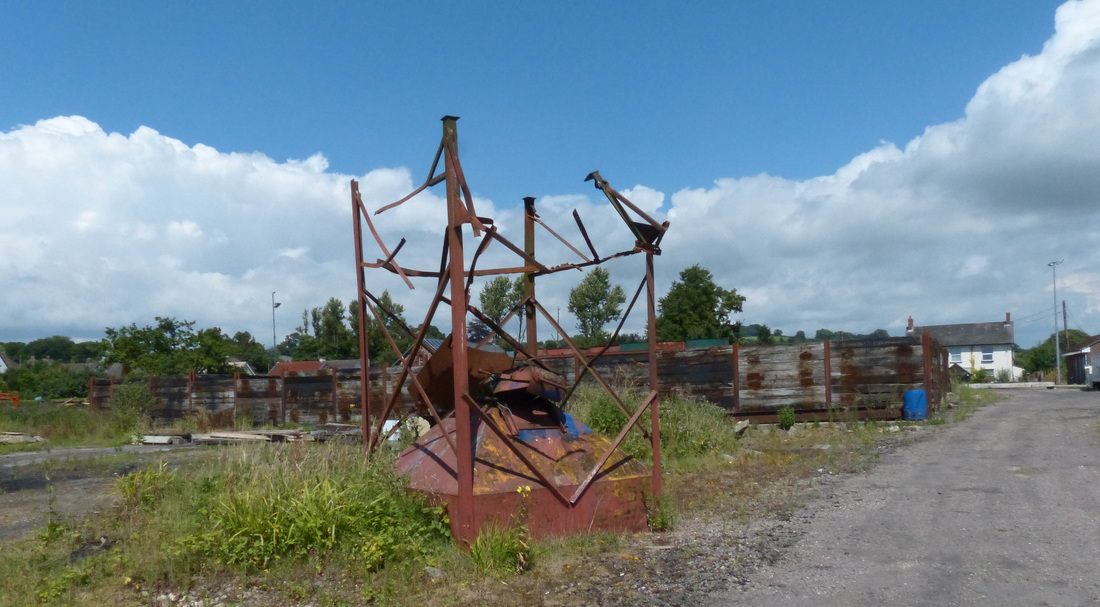
4) Chard Junction Coal Yard July 2016 Copyright Brian Pibworth. Brian writes :- The coal yard (4) is almost unrecognisable from the old Darch's Coals operation that I remember and the current coal merchant has concentrated business behind a wall of railway sleepers adjacent to the road. This must be more efficient than the historical yard but effectively covers the remains of the Chard Branch station.
Brian Pibworth writes :- As promised, some pictures of what remains of Chard Junction Creamery. The pics are straight into the sun but I can vouch for the fact that there are no buildings left standing, just huge piles of earth and crushed aggregate. The train is the retreating Southwest Trains 3-car unit No 159007 with the 1L44 11.25 Exeter St David's to London Waterloo service.
Regarding you comment about the close proximity of the creamery to the sewage works, I can confirm that the filter beds adjacent to the down line were there to treat what remained after extracting butter, cream and Marvel and this has now gone with the rest of the plant. My recollection of visiting the factory was of ducts of steaming "water" flowing through the plant and presumably ending up in the R. Axe after treatment. Tatworth, the adjacent village, has its own sewage works on the north side of the old station. As a teenager heading for a Boy Scout camp near Ilfracombe in the 1950s, I remember seeing a similar close proximity of treatment plant and creamery when our train stopped for an age near Lapford, N Devon. My friend Ronnie quickly concocted an explanation which somehow reversed the flow, from village to factory, and managed to put us off eating a certain brand of creamed rice for a very long time!
A quick snoop at Google Earth shows that their latest satellite picture shows all but the original buildings demolished, but we are wondering if the site will remain in its "original condition" for long before someone finds a way of developing it, especially as it is bordered by various business premises.
With kind regards, Brian Many thanks for your time and trouble Brian.
Regarding you comment about the close proximity of the creamery to the sewage works, I can confirm that the filter beds adjacent to the down line were there to treat what remained after extracting butter, cream and Marvel and this has now gone with the rest of the plant. My recollection of visiting the factory was of ducts of steaming "water" flowing through the plant and presumably ending up in the R. Axe after treatment. Tatworth, the adjacent village, has its own sewage works on the north side of the old station. As a teenager heading for a Boy Scout camp near Ilfracombe in the 1950s, I remember seeing a similar close proximity of treatment plant and creamery when our train stopped for an age near Lapford, N Devon. My friend Ronnie quickly concocted an explanation which somehow reversed the flow, from village to factory, and managed to put us off eating a certain brand of creamed rice for a very long time!
A quick snoop at Google Earth shows that their latest satellite picture shows all but the original buildings demolished, but we are wondering if the site will remain in its "original condition" for long before someone finds a way of developing it, especially as it is bordered by various business premises.
With kind regards, Brian Many thanks for your time and trouble Brian.
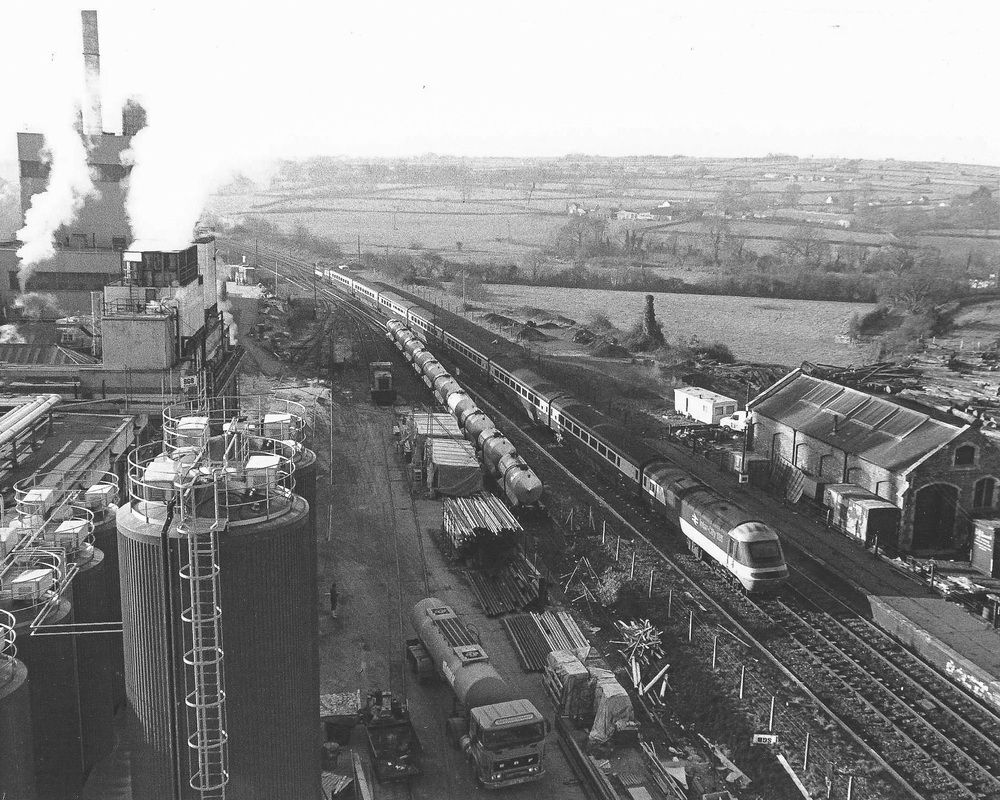
Putting things in perspective. Brian took this view with the kind permission of the late Mike Chubb then manager of the creamery. 6) View from top of Chard Junction Creamery 1982 Copyright Brian Pibworth The branch from Chard Central station ran down hill to terminate at an independent platform behind the station building. The branch made a curving approach from the right just off this picture. An HST diverted off its normal route due to work on the Whiteball tunnel stands on the passing loop.
A letter kindly sent in by Brian Pibworth in connection with an inquiry concerning the demolition works of the Creamery at Chard Junction produced some very interesting additionl shots concerning a runaway and a Deltic Railtour.
Hello Keith,
The Chard Junction Creamery appears to have reverted to the original brick buildings which had previously been dominated or enclosed by pre-fabricated additions.
Almost everything in the view from the top of the building in pic 6 has now gone and I am grateful to my friend, the late Mike Chubb, for arranging for me to tour the plant when he was manager there in the 80s. From the HST running by it must have been a Sunday diversion while work was going on re-lining Whiteball Tunnel. (Picture above)
The coal yard (4) is almost unrecognisable from the old Darch's Coals operation that I remember and the current coal merchant has concentrated business behind a wall of railway sleepers adjacent to the road. This must be more efficient than the historical yard but effectively covers the remains of the Chard Branch station.
Regarding the terminus of the Chard Branch, pics (7 & 8) show tracks in the road left by a 20 ton brake van and a wagon which escaped from a shunting operation at Chard Town in 1962 and survived the runaway journey, over several miles of curving downhill track, to hit the blocks at Chard Junction Branch station at about 35 mph. The wagons demolished the blocks, careered across the road and the van embedded itself in the side of the Chard Road Tavern. The tracks remained in the tarmac for several decades but those across the road have now gone and the pub and car park are now part of a private house. A full account of this incident (which had no casualties apart from the wagons and pub wall) can be found on pp 82/83 "Working the Chard Branch"by Derek Phillips and R Eaton-Lacey pub Fox & Co. Yeovil.
Pic (5) Shows the creamery in full operation complete with milk tankers and the old LSWR signal box in 1981. The occasion was an unscheduled stop of the Deltic Devonian Railtour, headed by 55016, which waited 15 min to allow the 11.10 Waterloo - Exeter to pass. The stop attracted many local enthusiasts and photographers including the chap on the right sporting no less than two Exakta cameras! (PS If anyone collects old Exaktas, I still have the odd one deep in our loft). My notes show the film to be HP5 rated at 1600 ASA which indicated November twilight and credit goes to my wife, Patricia, for recording the event.
Hope this fills in a few gaps.
With kind regards
Brian
Hello Keith,
The Chard Junction Creamery appears to have reverted to the original brick buildings which had previously been dominated or enclosed by pre-fabricated additions.
Almost everything in the view from the top of the building in pic 6 has now gone and I am grateful to my friend, the late Mike Chubb, for arranging for me to tour the plant when he was manager there in the 80s. From the HST running by it must have been a Sunday diversion while work was going on re-lining Whiteball Tunnel. (Picture above)
The coal yard (4) is almost unrecognisable from the old Darch's Coals operation that I remember and the current coal merchant has concentrated business behind a wall of railway sleepers adjacent to the road. This must be more efficient than the historical yard but effectively covers the remains of the Chard Branch station.
Regarding the terminus of the Chard Branch, pics (7 & 8) show tracks in the road left by a 20 ton brake van and a wagon which escaped from a shunting operation at Chard Town in 1962 and survived the runaway journey, over several miles of curving downhill track, to hit the blocks at Chard Junction Branch station at about 35 mph. The wagons demolished the blocks, careered across the road and the van embedded itself in the side of the Chard Road Tavern. The tracks remained in the tarmac for several decades but those across the road have now gone and the pub and car park are now part of a private house. A full account of this incident (which had no casualties apart from the wagons and pub wall) can be found on pp 82/83 "Working the Chard Branch"by Derek Phillips and R Eaton-Lacey pub Fox & Co. Yeovil.
Pic (5) Shows the creamery in full operation complete with milk tankers and the old LSWR signal box in 1981. The occasion was an unscheduled stop of the Deltic Devonian Railtour, headed by 55016, which waited 15 min to allow the 11.10 Waterloo - Exeter to pass. The stop attracted many local enthusiasts and photographers including the chap on the right sporting no less than two Exakta cameras! (PS If anyone collects old Exaktas, I still have the odd one deep in our loft). My notes show the film to be HP5 rated at 1600 ASA which indicated November twilight and credit goes to my wife, Patricia, for recording the event.
Hope this fills in a few gaps.
With kind regards
Brian
Gradients - Chard Town to Chard Junction
From a level start at Chard Town the line fell continuously for almost the whole of its length (2 1/2 miles) to Chard Junction where after a final dash down a 1 in 80 curve to a short level section at the platform. The gradients were 1 in 194, 163, 277, 600, 94, 200, 80.
From a level start at Chard Town the line fell continuously for almost the whole of its length (2 1/2 miles) to Chard Junction where after a final dash down a 1 in 80 curve to a short level section at the platform. The gradients were 1 in 194, 163, 277, 600, 94, 200, 80.
A report received from John Cornelius 31st July 2016 ;- Chard junc milk factory now virtually demolished, has featured quite a bit on the web in recent times.
So here's some pics from 2001 when several million pounds were being invested to update it, including four milk silos, two of which are seen arriving, then being craned into position and the finished job all on the new base.
More on the Runaway wagons. CHARD photographer David Wheadon, captured the scene shortly after the incident and a picture appeared in the local press the following week. I have a prèss cutting of the photo showing the guards van and wagon in the pub yard.
Another runaway.** Also some years before, 0-4-2 No 5812 arriving on a passenger train from Taunton slipped on icy rails,failed to stop, slid through the platform and demolished the buffers,the force of the impact stopping the loco from going into the road.
Enjoy, cheers JOHN C Many thanks for the report and pictures.
So here's some pics from 2001 when several million pounds were being invested to update it, including four milk silos, two of which are seen arriving, then being craned into position and the finished job all on the new base.
More on the Runaway wagons. CHARD photographer David Wheadon, captured the scene shortly after the incident and a picture appeared in the local press the following week. I have a prèss cutting of the photo showing the guards van and wagon in the pub yard.
Another runaway.** Also some years before, 0-4-2 No 5812 arriving on a passenger train from Taunton slipped on icy rails,failed to stop, slid through the platform and demolished the buffers,the force of the impact stopping the loco from going into the road.
Enjoy, cheers JOHN C Many thanks for the report and pictures.
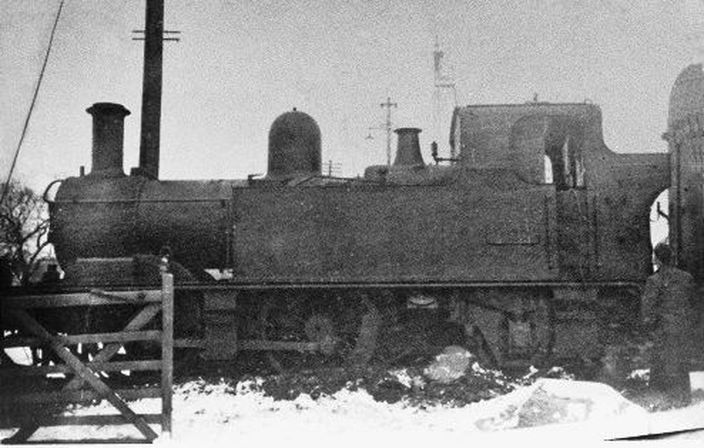
** Back in the 1930's 0-4-2 No 5812 arriving on a passenger train from Taunton slipped on icy rails, failed to stop, slid through the platform and demolished the buffers, the force of the impact stopping the loco from going into the road.Photo taken by the late Peter Kirkland - from the John Cornelius Collection,
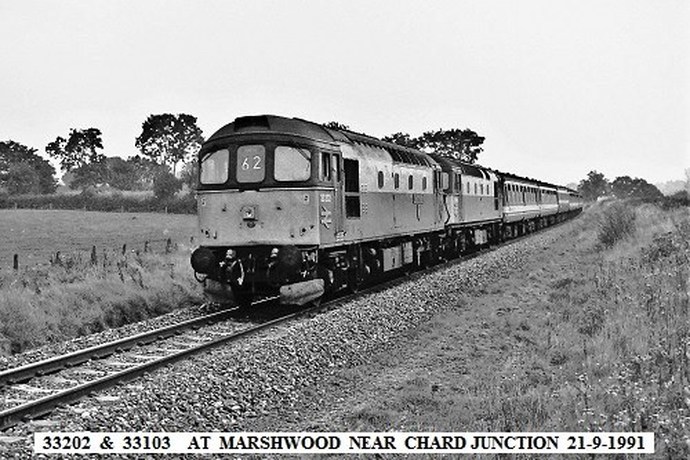 Copyright John Cornelius
Copyright John Cornelius
January 2018
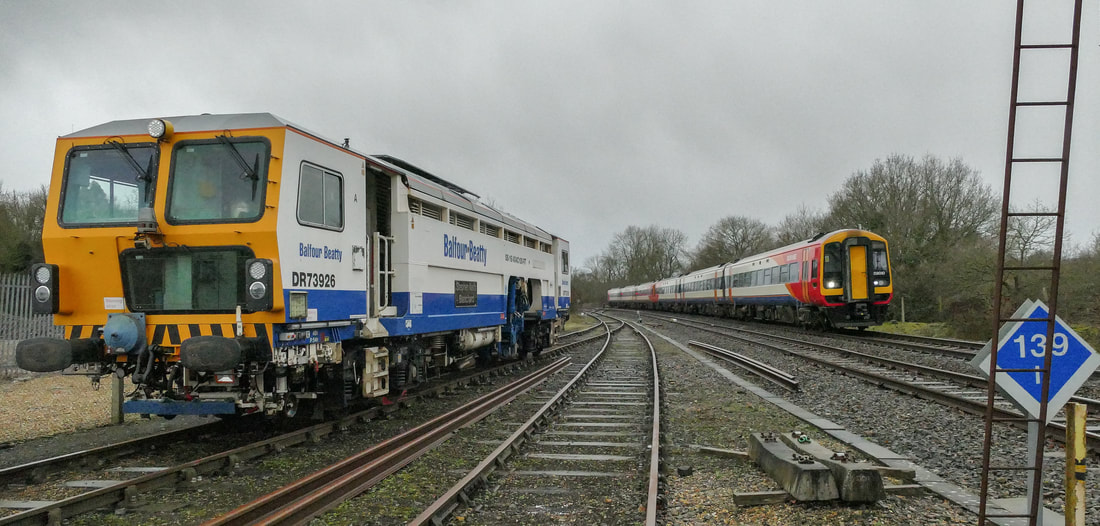
On a cold, wet January day Balfour Beatty Tamper DR73926 "Stephen Keith Blanchard" waits between night maintenance work in all that remains of the old Chard Junction Creamery Sidings. Passing at speed on the up main line is the delayed 1L52 1325 Exeter St David's to London Waterloo SWT service. 16th January 2018 Copyright Brian Pibworth
P1610539.jpg
Chard Junction Floods - John Cornelius writes:-
Taken standing on the level crossing which was higher than the flood water. The last pic with the line shows the height the water came up on the 1-1-2001. Had it been daylight, I would have taken some pics from the platform edge showing the line completely under water. Sadly it all happened when it was dark, but it was the worst flooding I ever saw in my time there.
Taken standing on the level crossing which was higher than the flood water. The last pic with the line shows the height the water came up on the 1-1-2001. Had it been daylight, I would have taken some pics from the platform edge showing the line completely under water. Sadly it all happened when it was dark, but it was the worst flooding I ever saw in my time there.
Chard Junction in 2019
Please find attached pictures of the New Measurement Train at Chard Junction today. Many thanks to Guy Vincent for giving a "heads up" about busy times on the old LSWR line. It takes me back to the 80s when they relined Whiteball Tunnel and we had cement, bitumen and ballast rumbling up the Axe valley. Not so much freight these days but it looks promising.
They cancelled the Class 66 gauging loco today but the NMT made a bright show in the Winter sunshine
With kind regards, Brian Many thanks Brian
They cancelled the Class 66 gauging loco today but the NMT made a bright show in the Winter sunshine
With kind regards, Brian Many thanks Brian
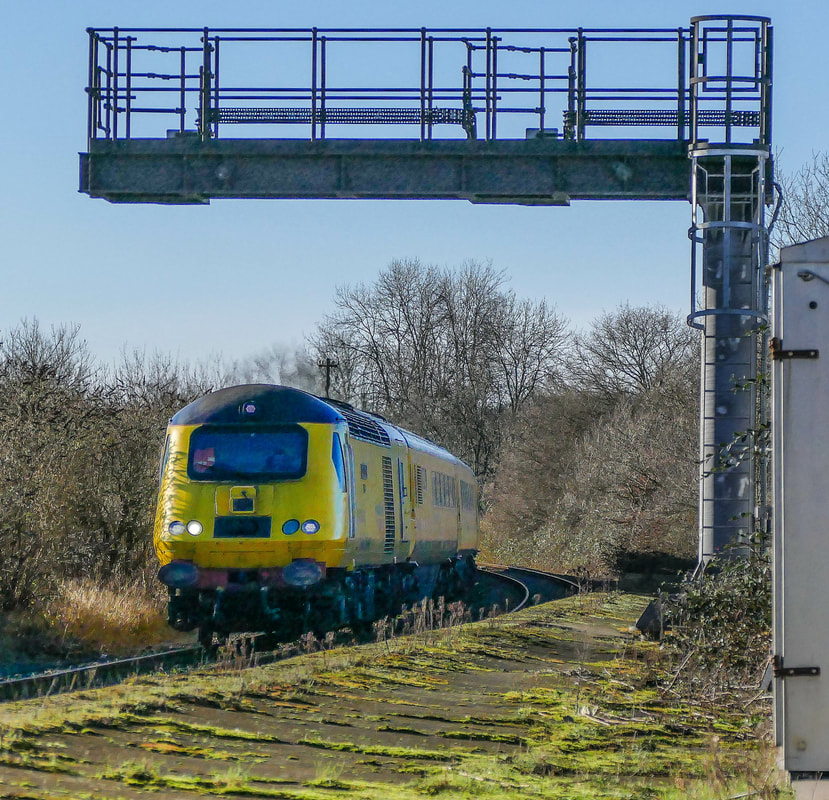
101J 0541 Reading Triangle Sidings to Salisbury, headed by powercar "Railway Observer", waiting in the Junction Loop, the old Dn line, with no sign of the Creamery in the background and the Up platform rapidly greening over. The picture is taken from the site of the Chard Junction Signal Box showing the coloured light signal gantry which still controls Up movements through the loop and level crossing status. 17th January 2019. Copyright Brian Pibworth.
Many thanks Brian.
Brian Pibworth writes
Chard Junction in 2020
Chard Junction in 2020
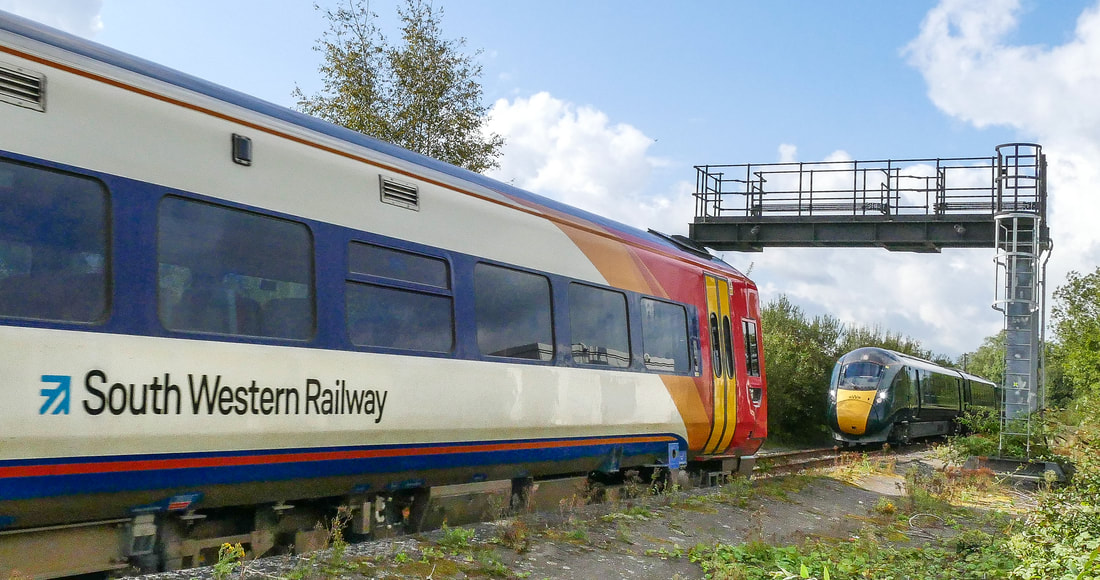
GWR 802106, in diesel mode, waits in Chard Junction loop with the 1A80 0840 Plymouth to London while SWR 159104 bats past at lines peed with 1L17 0820 London Waterloo to Exeter St Davids. The WTT described this as an "unadvertised service stop", so keeping it away from the platform was probably a good idea! 29th September 2020. Copyright Brian Pibworth.
Many thanks Brian.
A report on the former goods yard at Chard junction
September 2020
September 2020
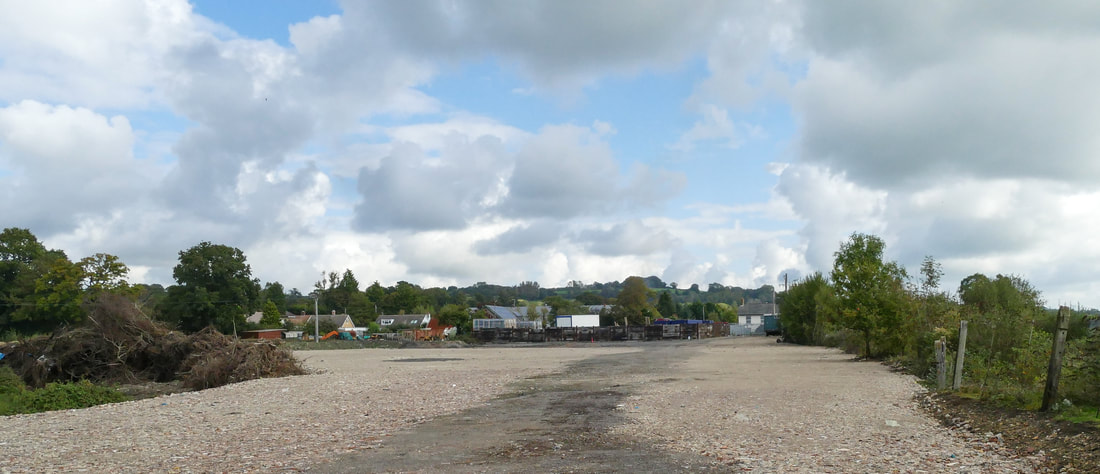
Chard Junction Station Site
The entire site has now been cleared, levelled and covered in compacted hardcore. From L to R ia the former branch formation to Chard (behind uprooted trees) , the branch platform, Chard Road Hotel and the current mainline fence. There seems to be less recycled hardcore on the old Milk Factory site and this may account for the material on the station side. The sleeper-walled compound (centre)contains trailers from a local heavy goods haulier. 29th September 2020. Copyright Brian Pibworth.
Many thanks Brian
All changed at Chard Junction
- Brian Pibworth brings us right up to date - to the end 2020 with changes at this once busy location.
- Brian Pibworth brings us right up to date - to the end 2020 with changes at this once busy location.
Dear Keith,
Herewith attached pictures of the old Chard Junction Station site as of 29th September 2020 for the CRS Archive.
The entire site has been cleared, levelled and covered in compacted hardcore. There seems to be less recycled hardcore on the old Milk Factory site and this may account for the material on the station side. The sleeper-walled compound contains trailers from local heavy goods hauliers. The approach road is now protected by massive steel security gates and there is no public access - even by accident.
1) Screen-grab of Google Satellite view of Chard Junction Station Site September 2020 with camera direction arrows (NO copyright permission).
2) Chard Jnc. Station Site A > South West
3) Chard Jnc. Station Site B > North East. From L to R, the former branch formation to Chard (behind uprooted trees) , the branch platform, Chard Road Hotel and the current mainline fence
4) Chard Jnc. Station Site C > West
5) Chard Jnc. Station Site. Scrap Metal Pile
6) Chard Jnc. Station Site. Goods Shed block paving.
7) Chard Jnc. Station Site. L to R Current signal relay containers, former station foundations, current concrete sleepers and wooden sleepers enclosing truck park.
I'll send today's pic by separate email so as to avoid overfilling the message.
Regards,
Brian
1) Chard Jnc Satellite-Arrows.jpg
2) Chard Jnc. Station Site A > South West
3) Chard Jnc. Station Site B > North East
4) Chard Jnc. Station Site C > West
5) Scrap Metal
6) Chard Jnc. Station Site - Goods Shed Block Paving
7) Chard Jnc. Station Site - Foundations and sleepers.
Herewith attached pictures of the old Chard Junction Station site as of 29th September 2020 for the CRS Archive.
The entire site has been cleared, levelled and covered in compacted hardcore. There seems to be less recycled hardcore on the old Milk Factory site and this may account for the material on the station side. The sleeper-walled compound contains trailers from local heavy goods hauliers. The approach road is now protected by massive steel security gates and there is no public access - even by accident.
1) Screen-grab of Google Satellite view of Chard Junction Station Site September 2020 with camera direction arrows (NO copyright permission).
2) Chard Jnc. Station Site A > South West
3) Chard Jnc. Station Site B > North East. From L to R, the former branch formation to Chard (behind uprooted trees) , the branch platform, Chard Road Hotel and the current mainline fence
4) Chard Jnc. Station Site C > West
5) Chard Jnc. Station Site. Scrap Metal Pile
6) Chard Jnc. Station Site. Goods Shed block paving.
7) Chard Jnc. Station Site. L to R Current signal relay containers, former station foundations, current concrete sleepers and wooden sleepers enclosing truck park.
I'll send today's pic by separate email so as to avoid overfilling the message.
Regards,
Brian
1) Chard Jnc Satellite-Arrows.jpg
2) Chard Jnc. Station Site A > South West
3) Chard Jnc. Station Site B > North East
4) Chard Jnc. Station Site C > West
5) Scrap Metal
6) Chard Jnc. Station Site - Goods Shed Block Paving
7) Chard Jnc. Station Site - Foundations and sleepers.
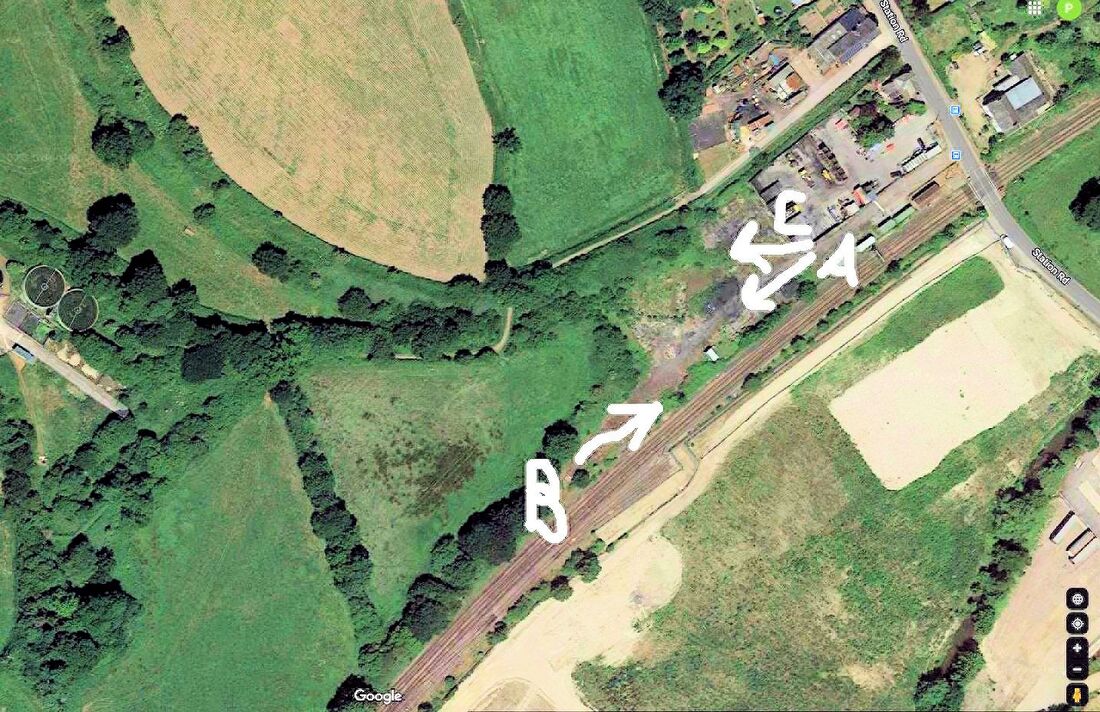
Chard Jnc Satellite-Arrows 29th September 2020. Copyright Brian Pibworth. In this view you can clearly see the site of the former Milk Factory - it occupied much of the bottom right of this picture, The destinctive curve heading north away from the former station site is the formation of the Chard branch leading eventually to Taunton.
A visit this morning, 23rd December 2020, showed that the security gate has been strengthened considerably since September and now completely bars access to the site. There are forklift trucks operating in the sleepered compound and a photographer "accidentally" wandering in would attract attention and still not be able to pass the formidable gates and fences.
Brian
Brian
Many thanks Brian
Chard Junction and main line - Engineering works Easter Weekened 2022
Bill Elston
Bill Elston
Engineering work is taking place between Yeovil Jct and Honiton this weekend, with the line shut.
GBRf 66793, in BR Railfreight Construction livery is seen at Chard Jct., along with various plant and equipment, please see photos.
Happy Easter, Bill
GBRf 66793, in BR Railfreight Construction livery is seen at Chard Jct., along with various plant and equipment, please see photos.
Happy Easter, Bill
Thanks for your report Bill.
Please go to Chard Jct Excl to Yeovil Jct for further coverage
